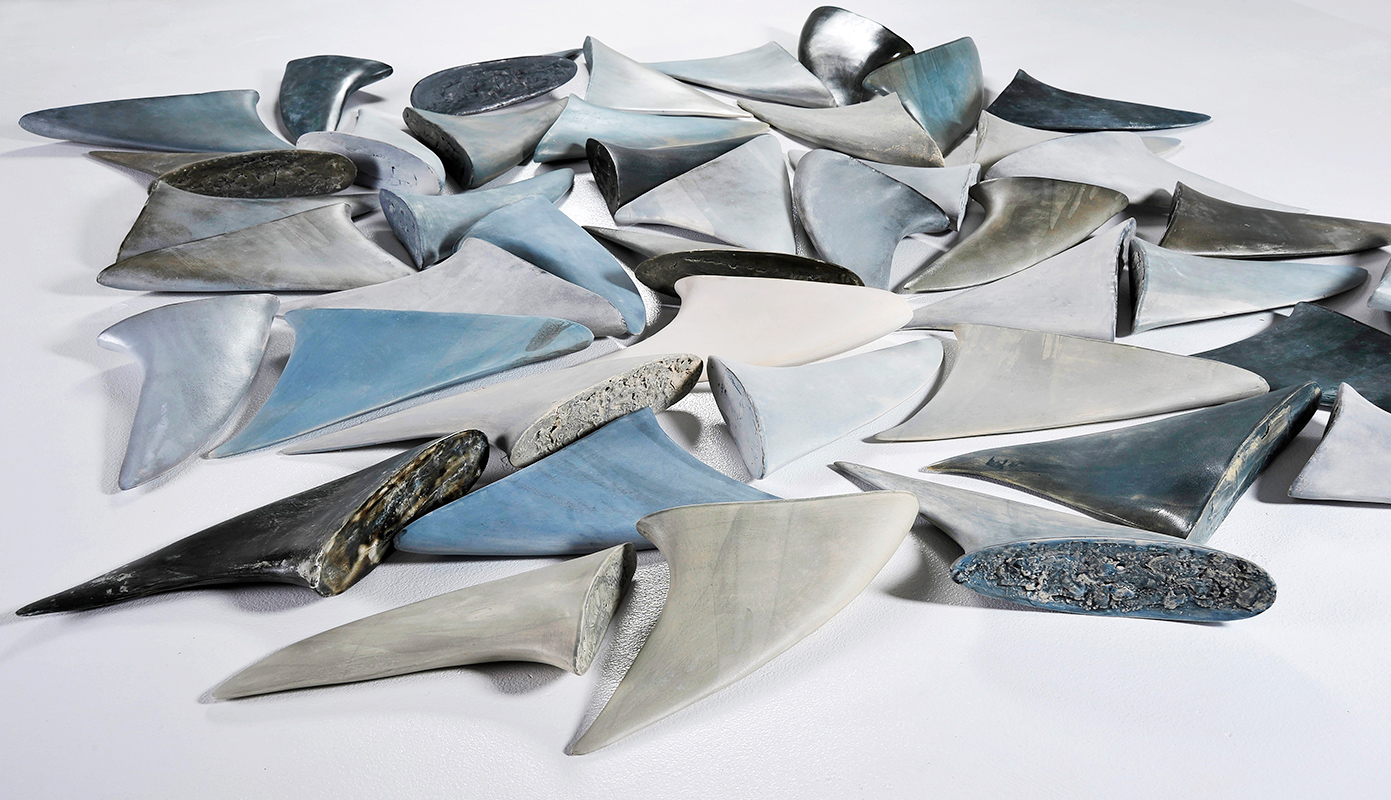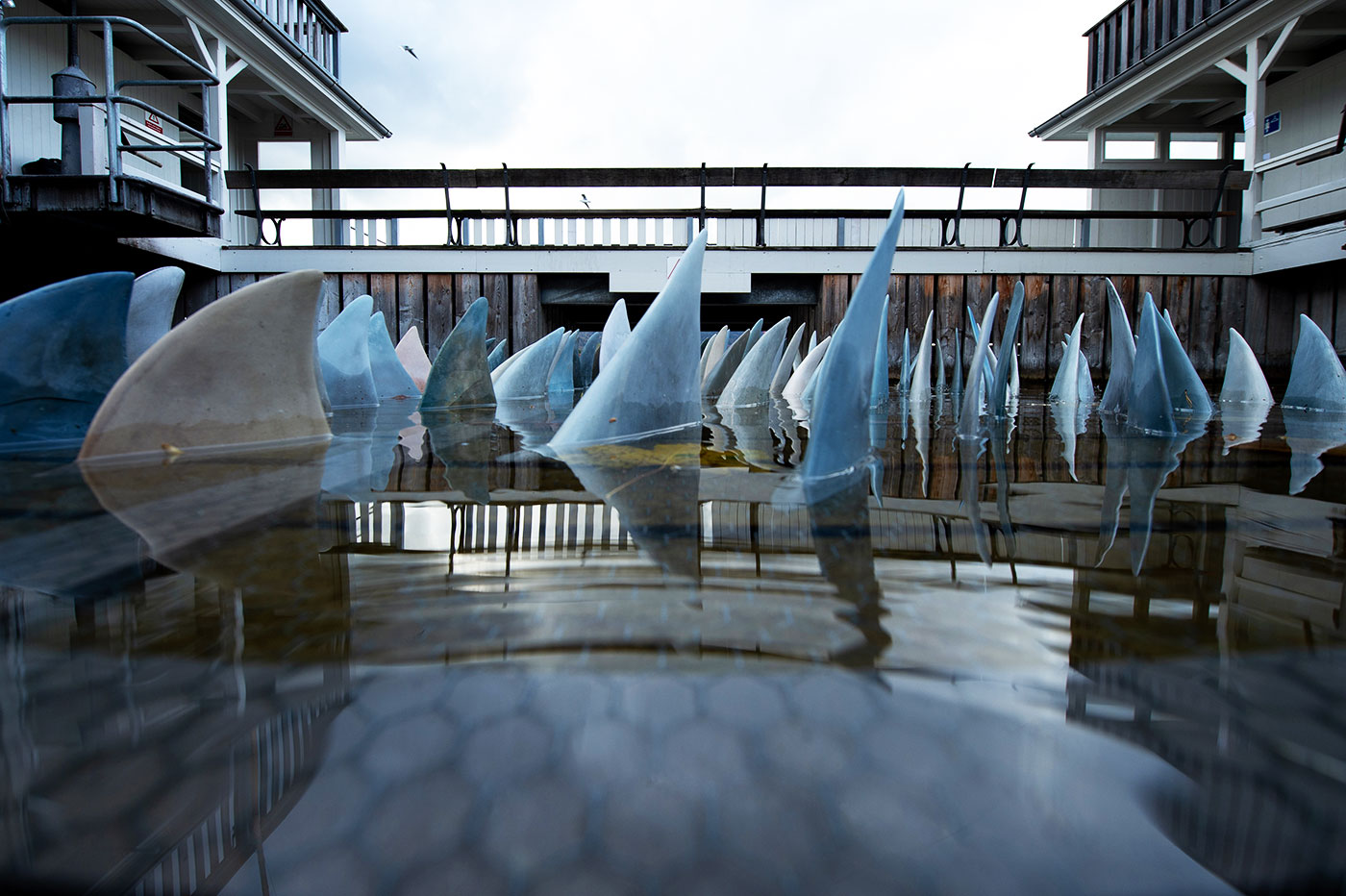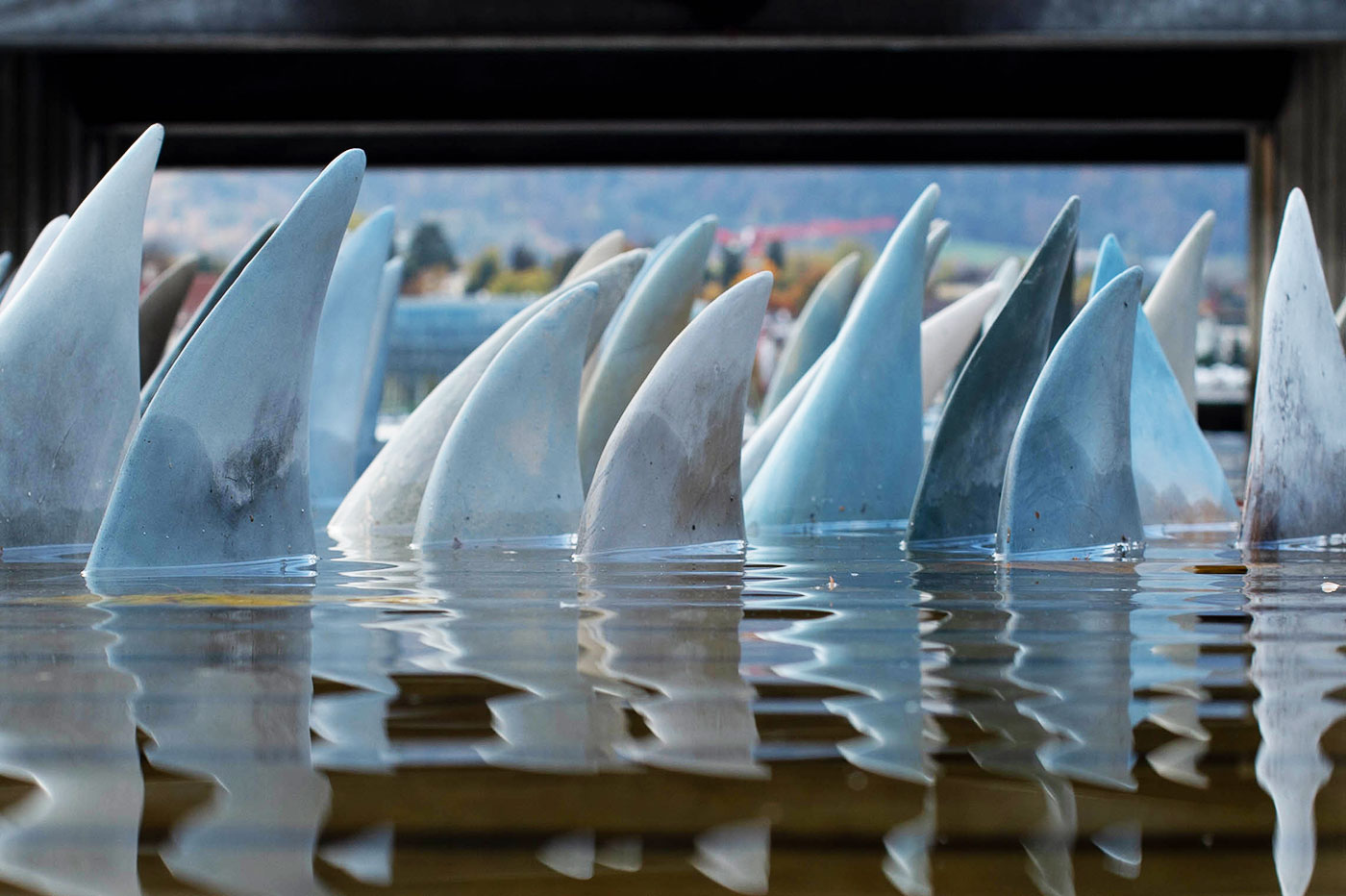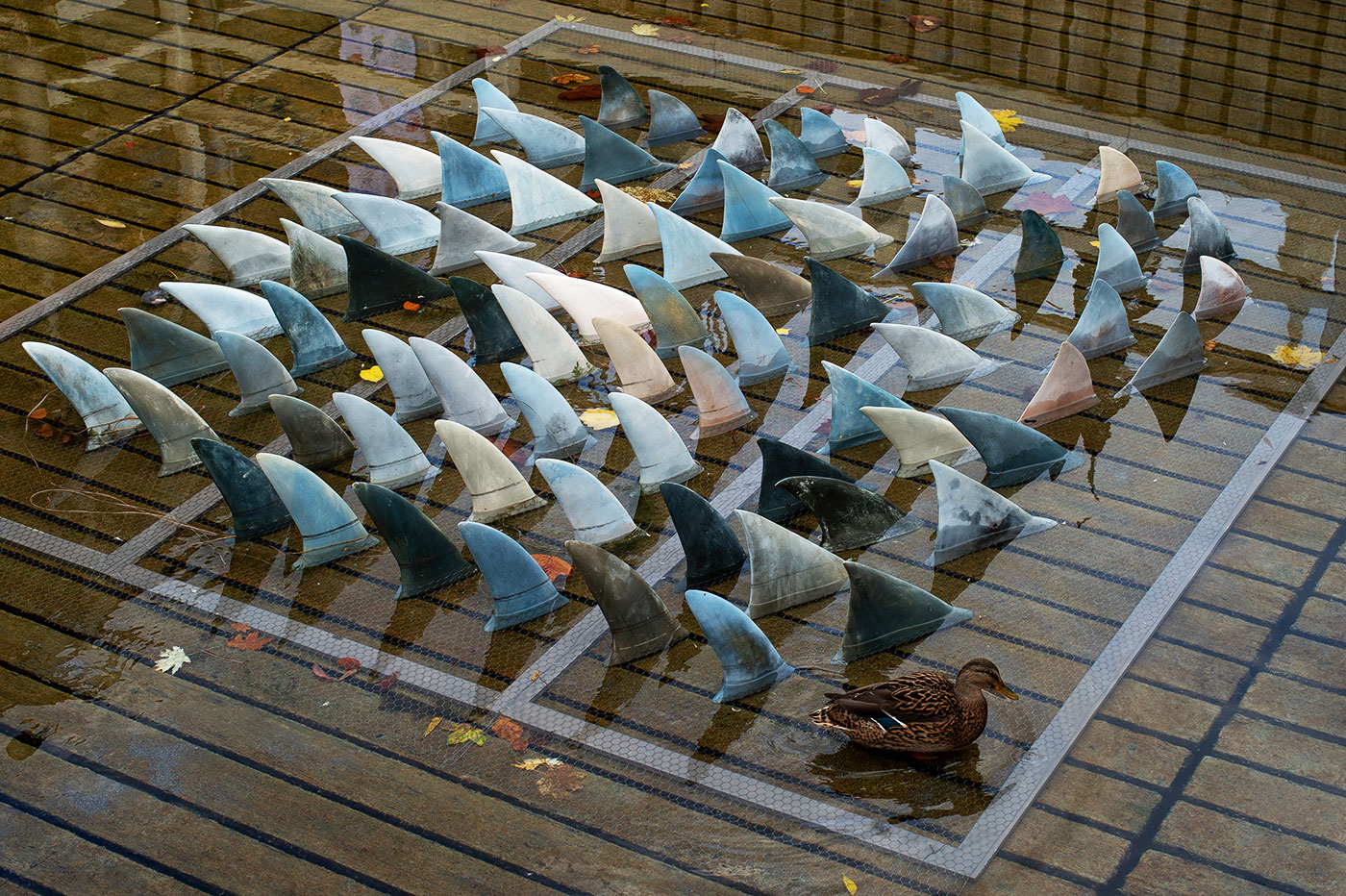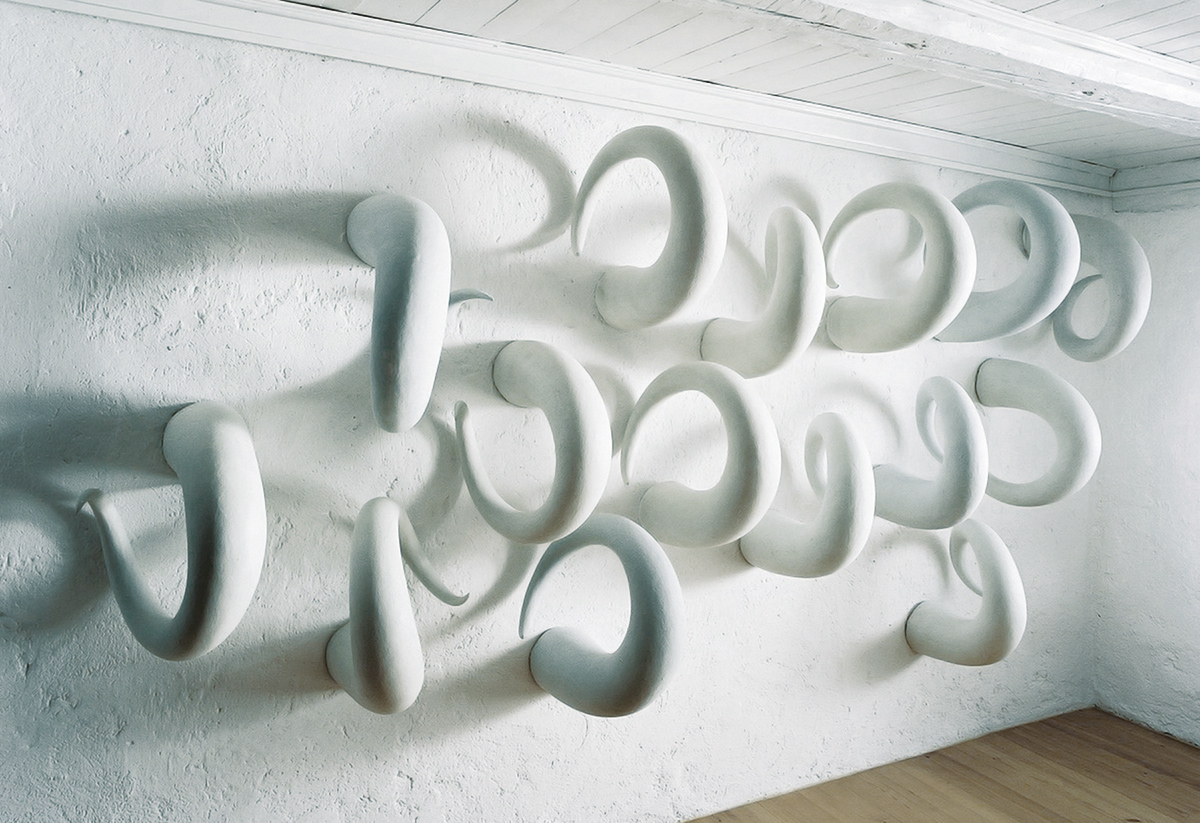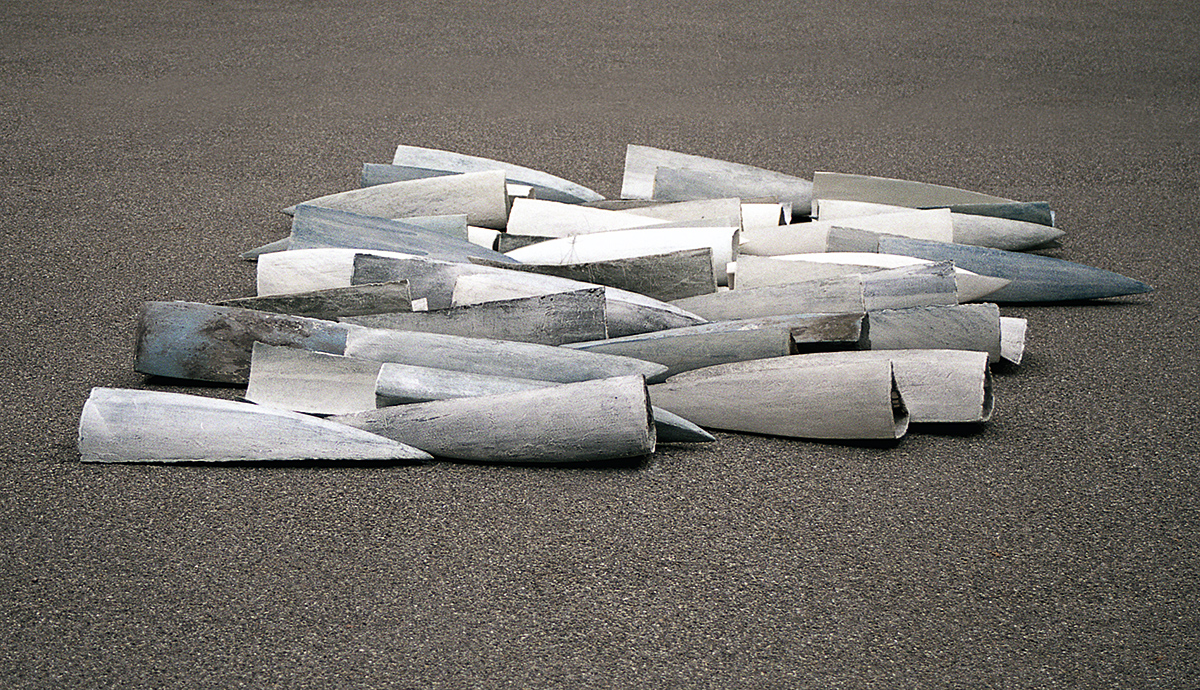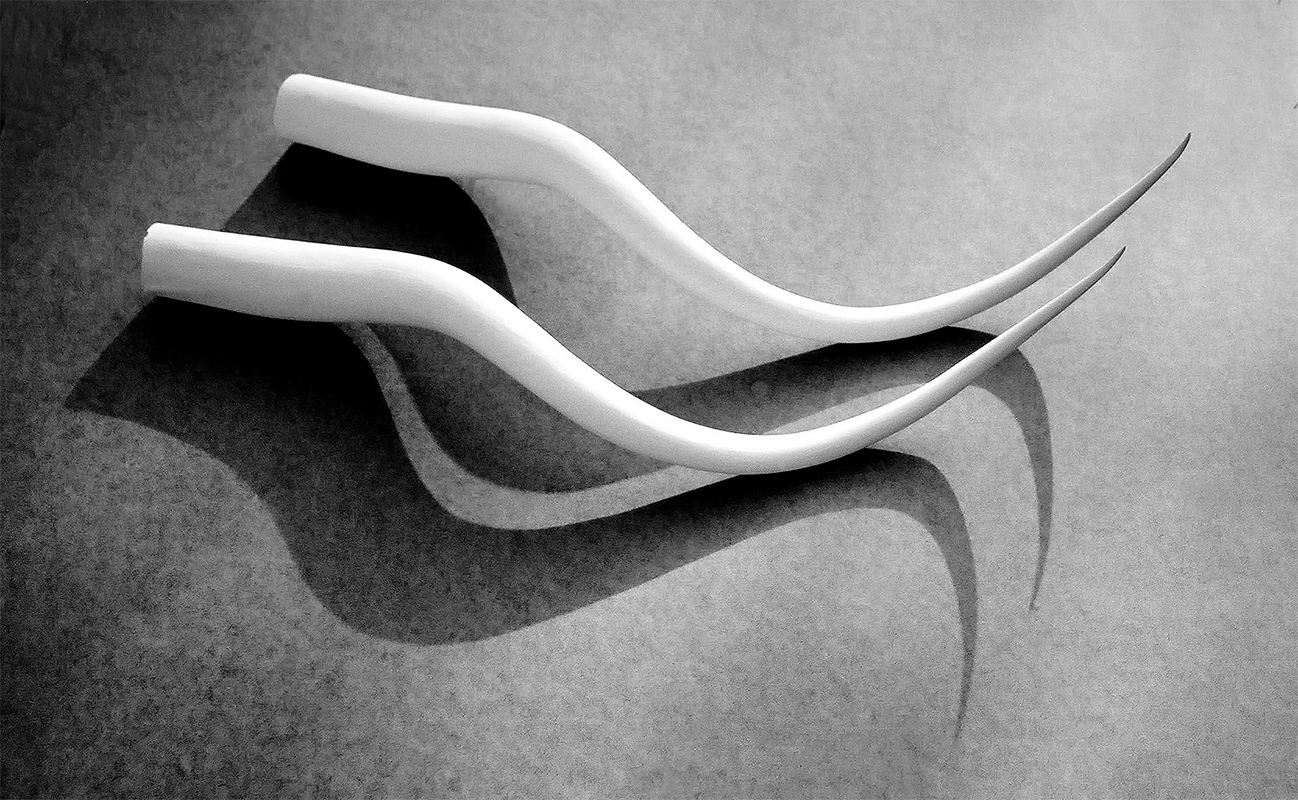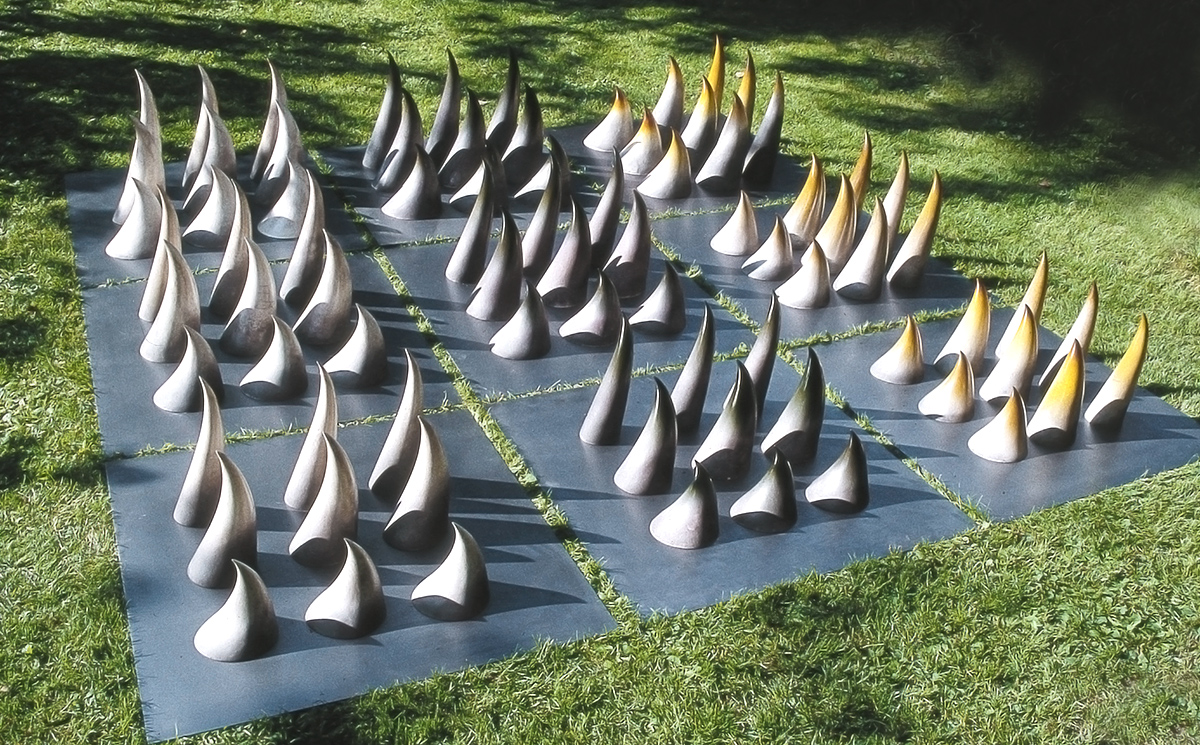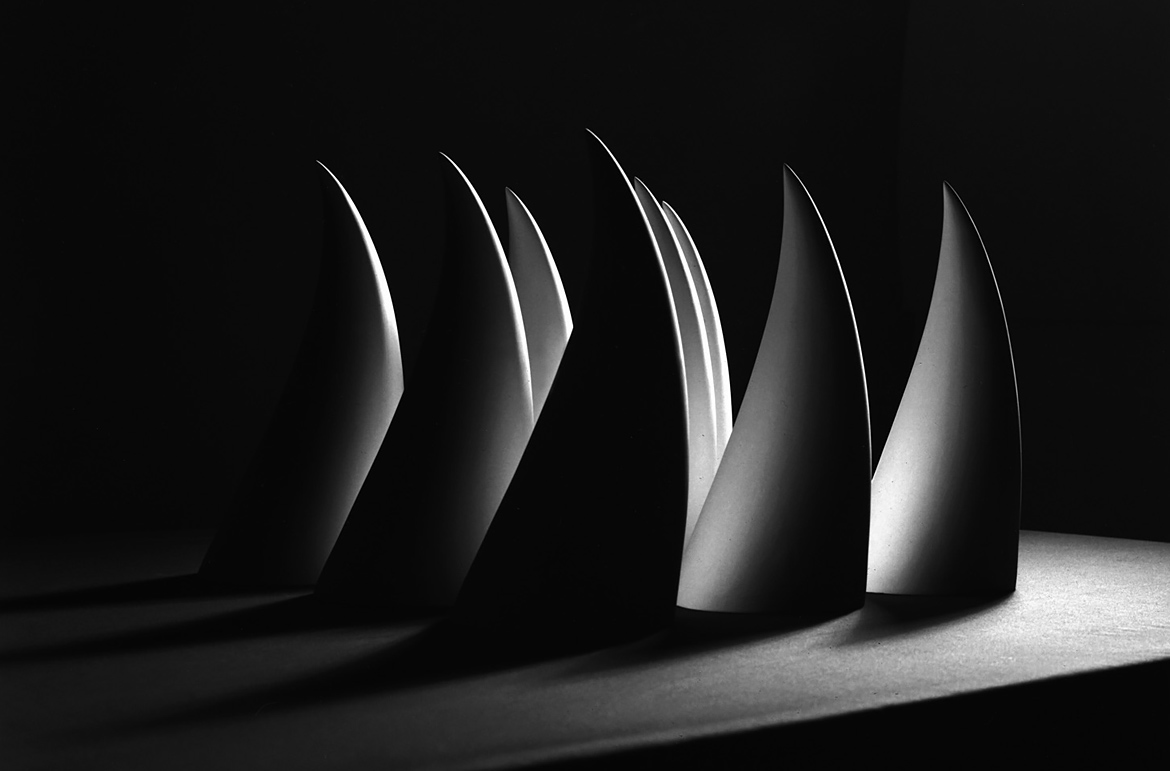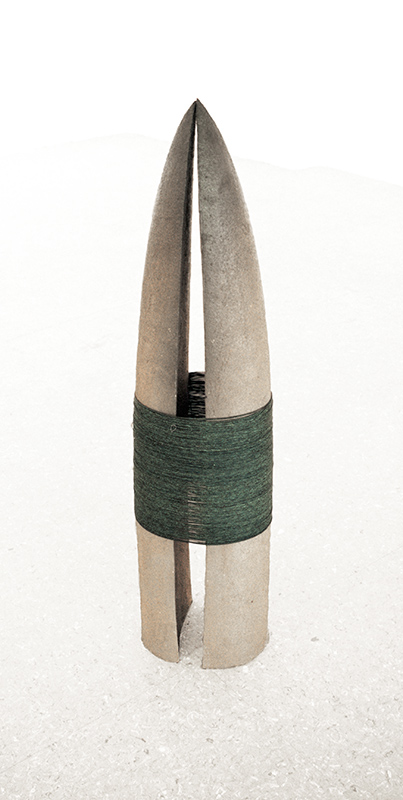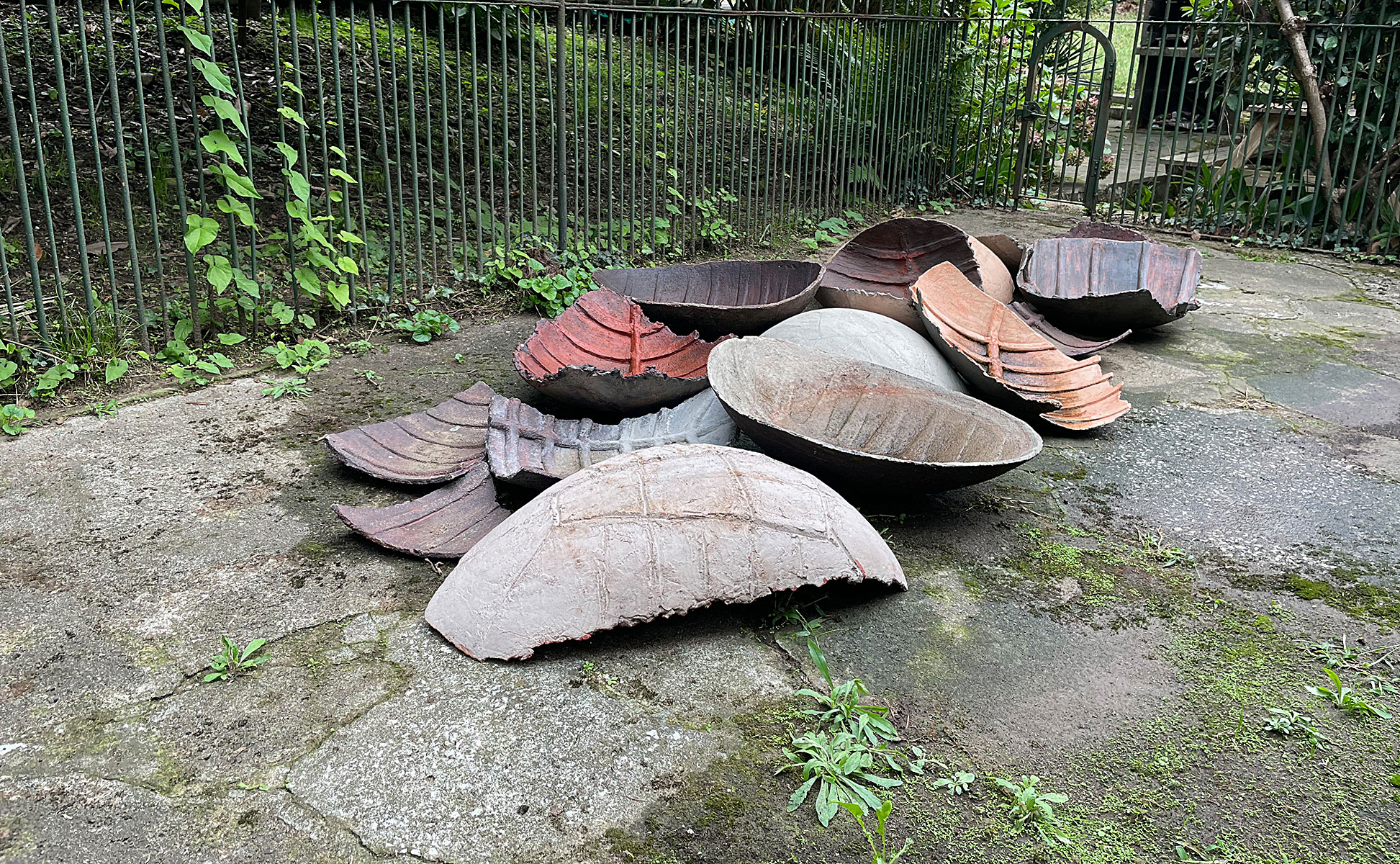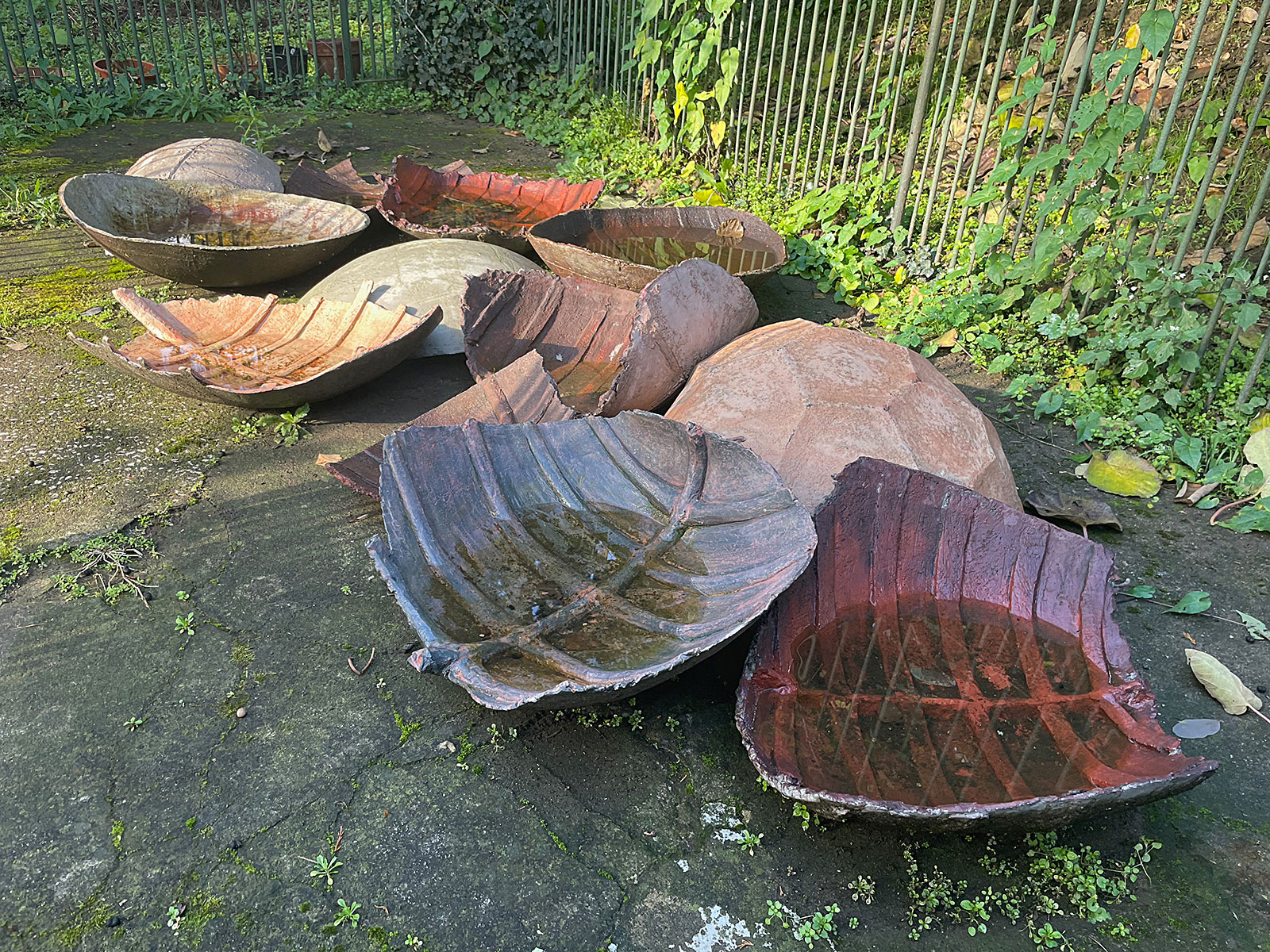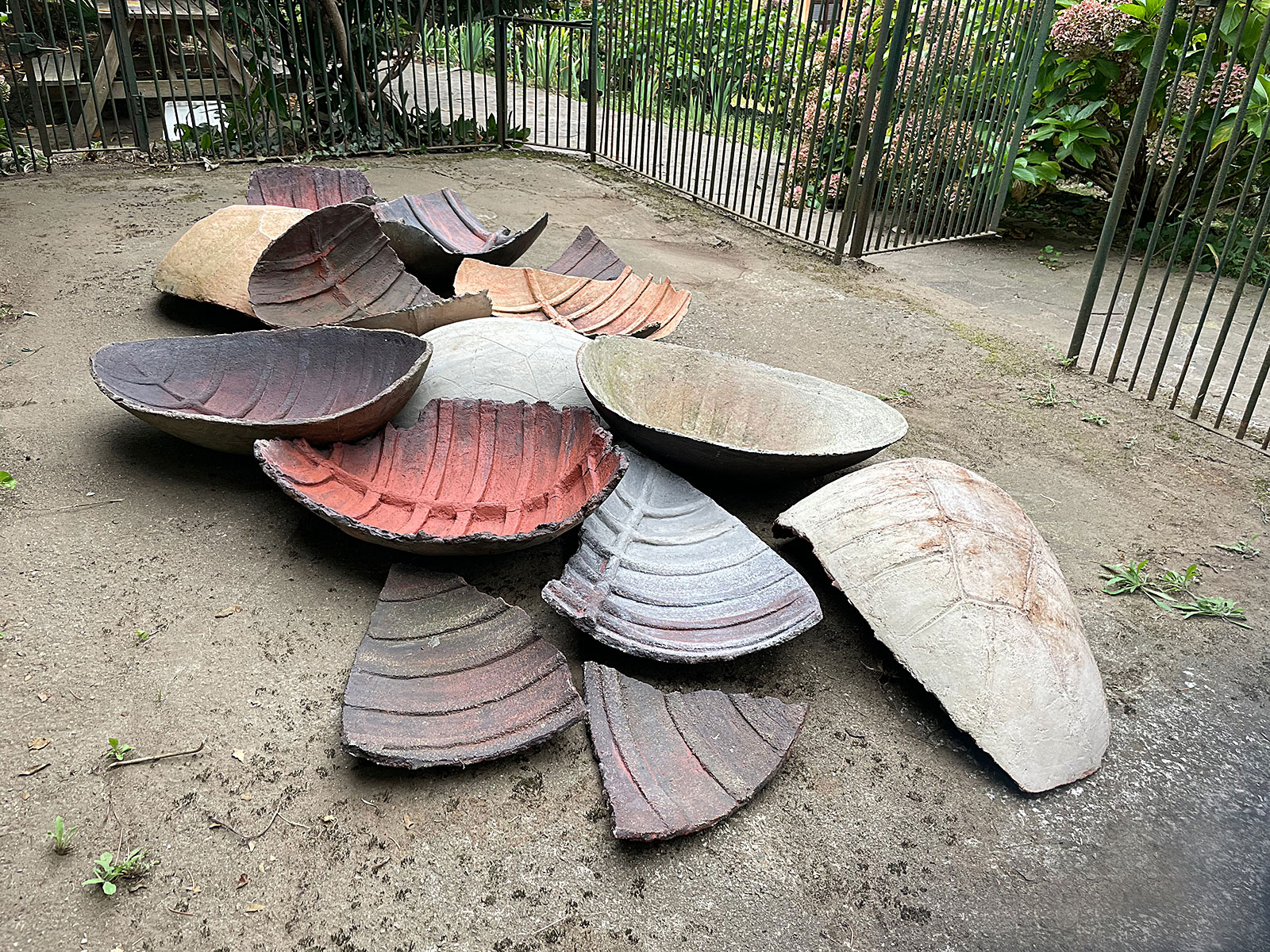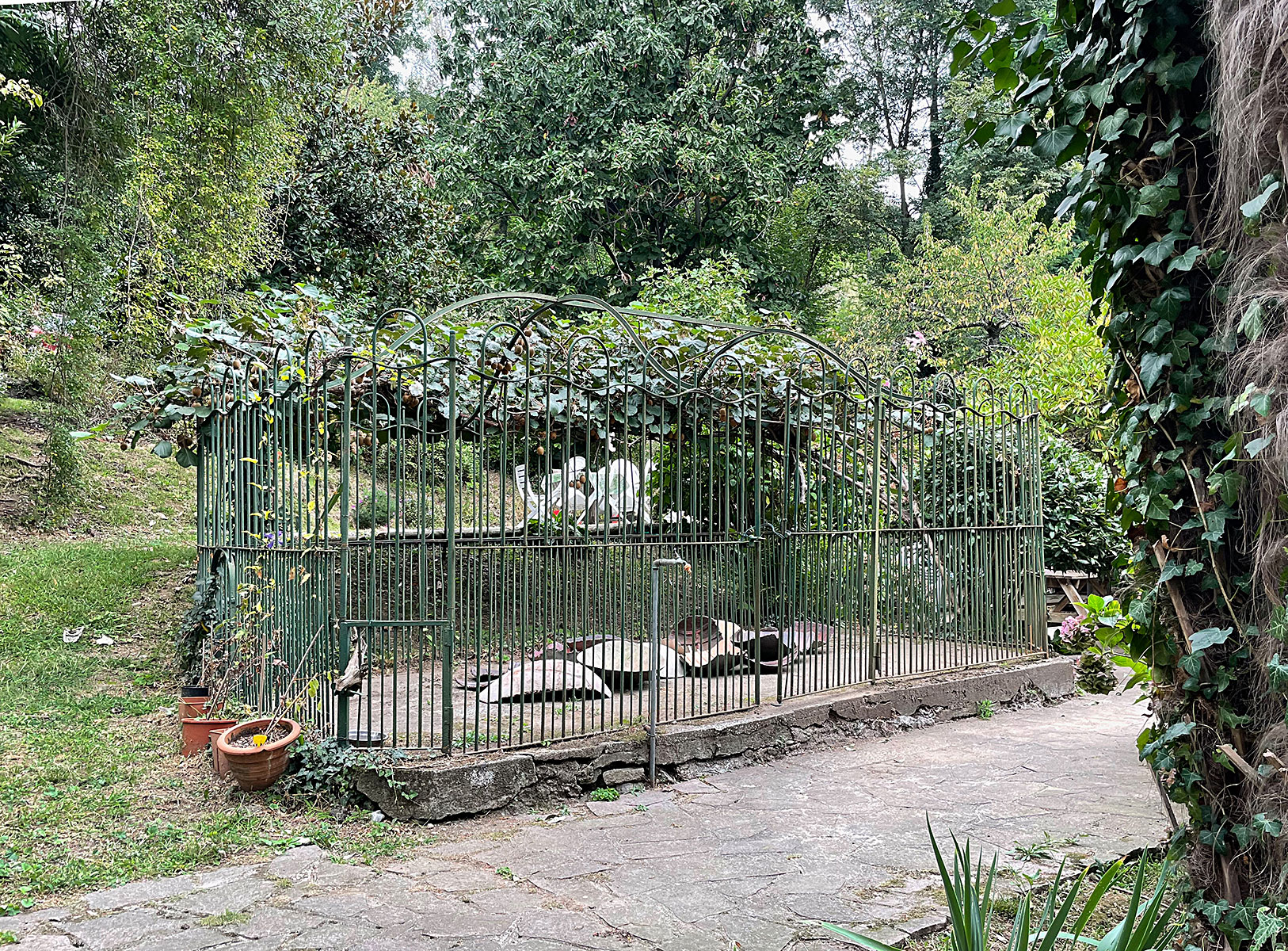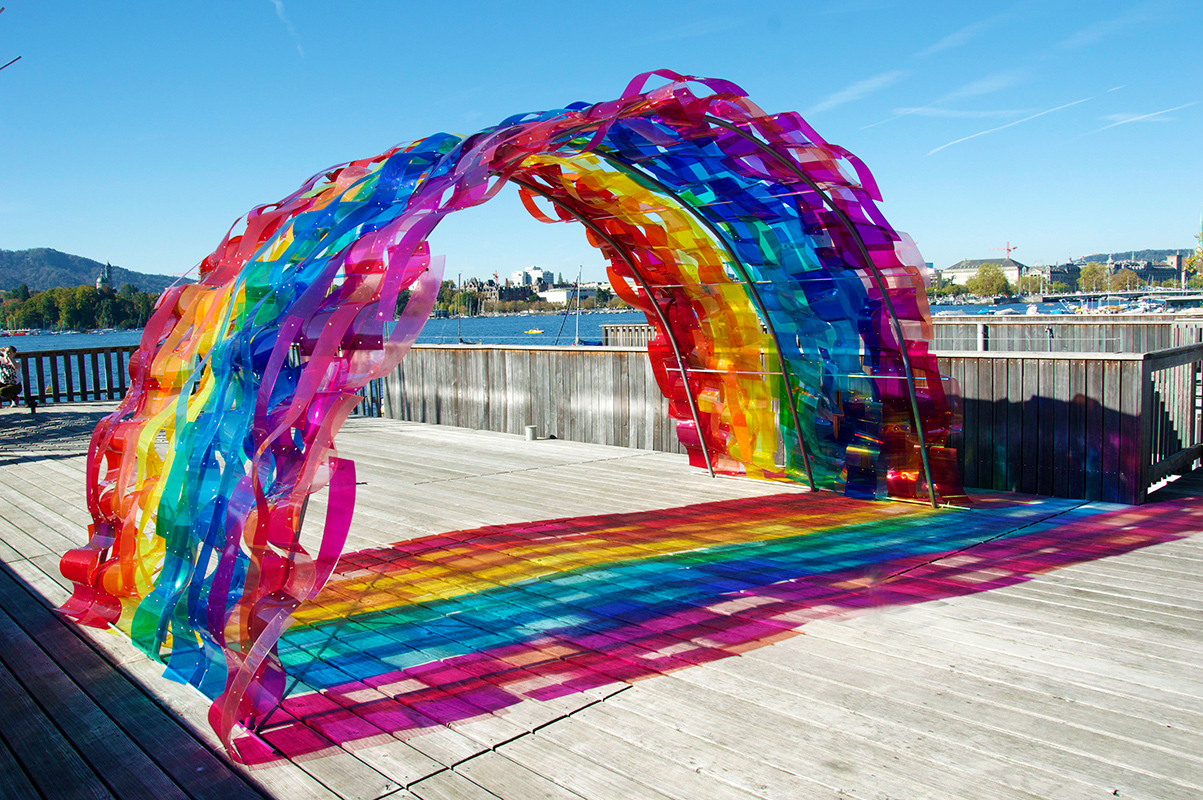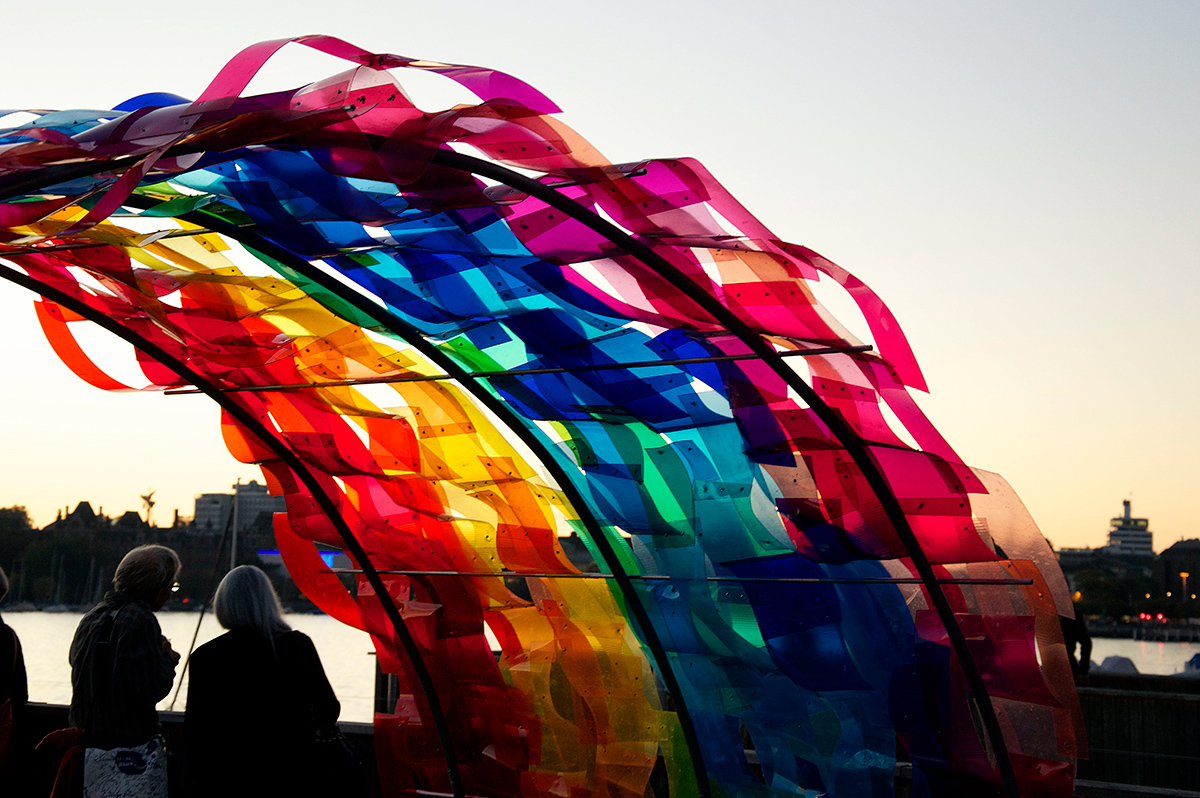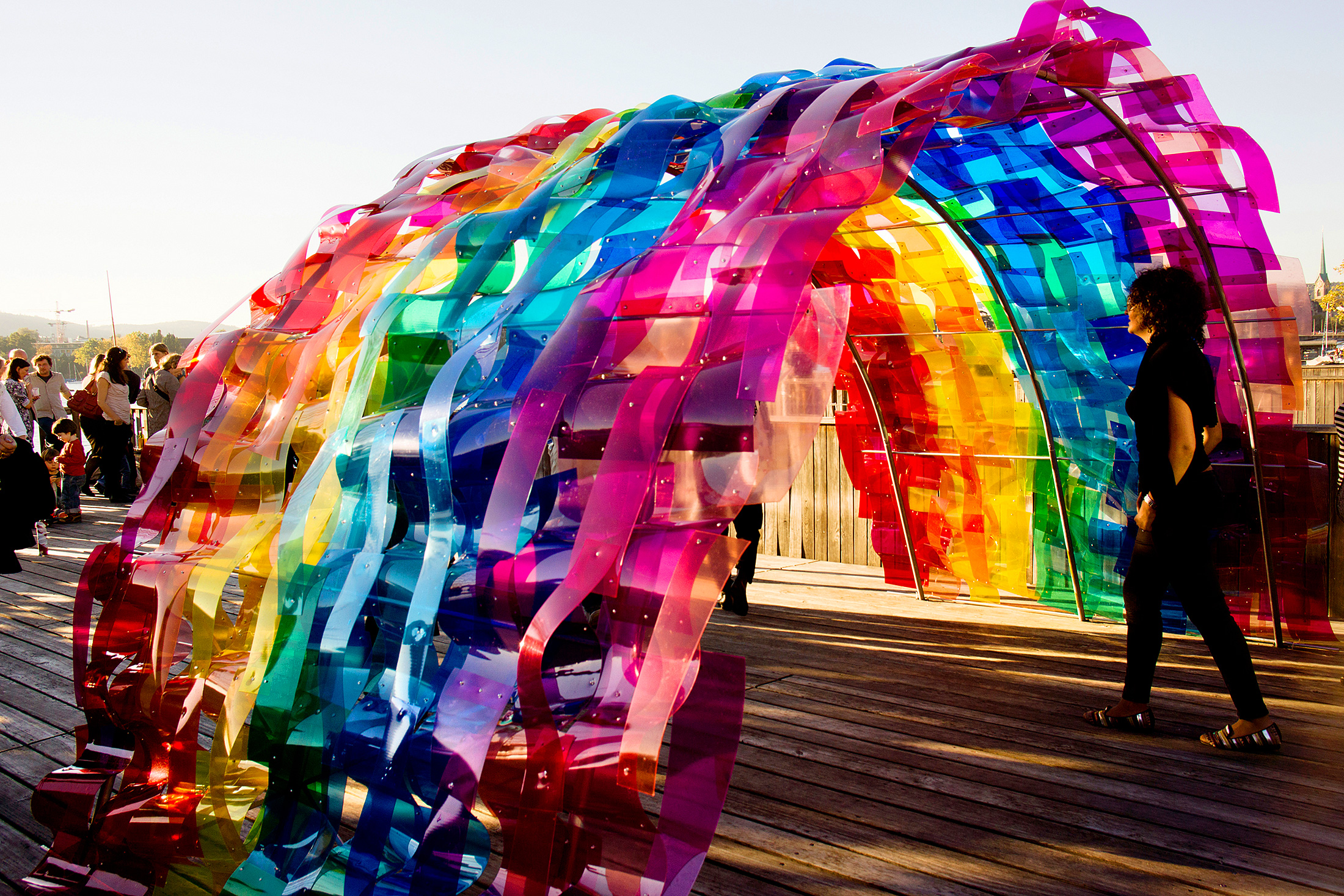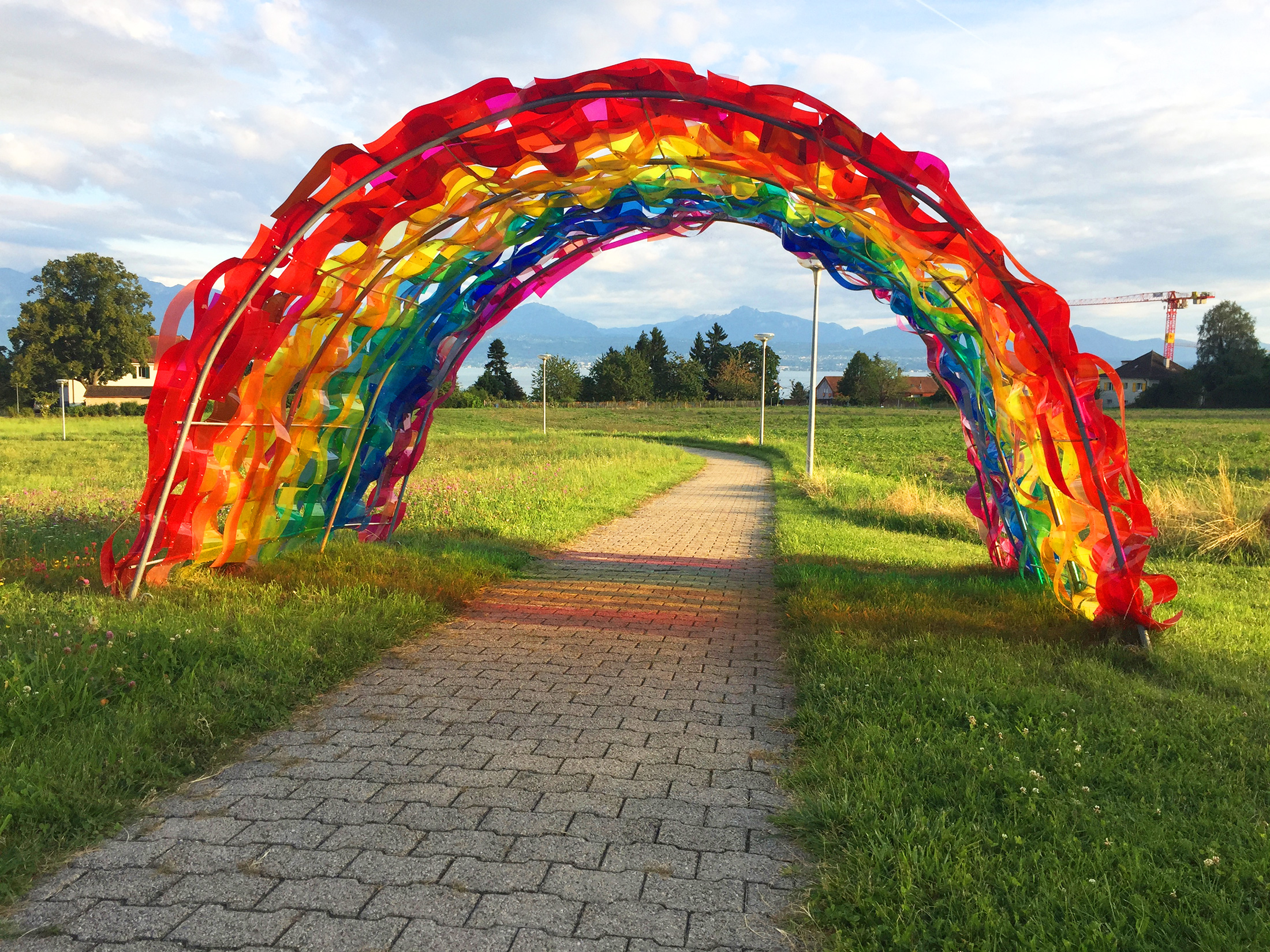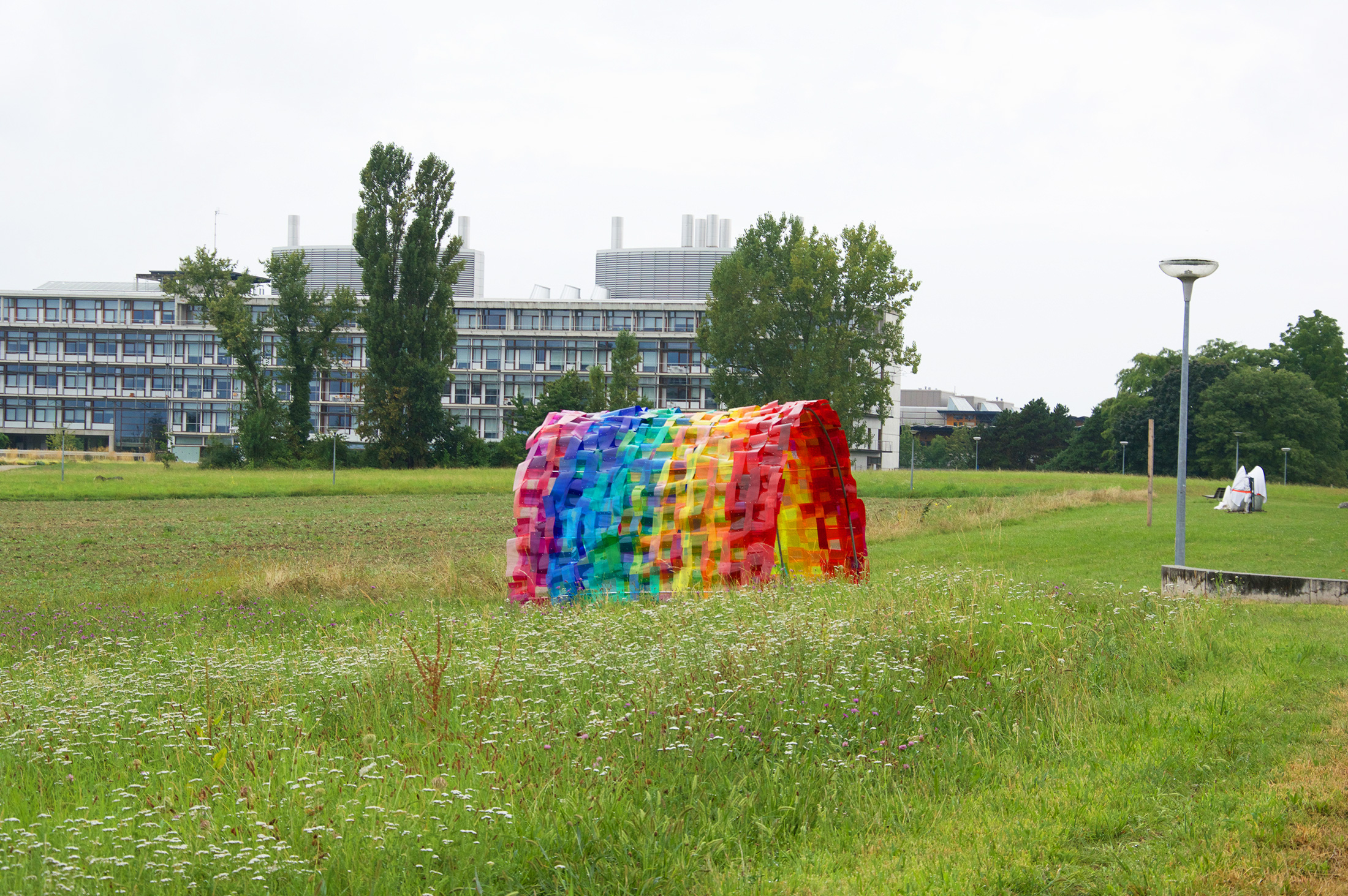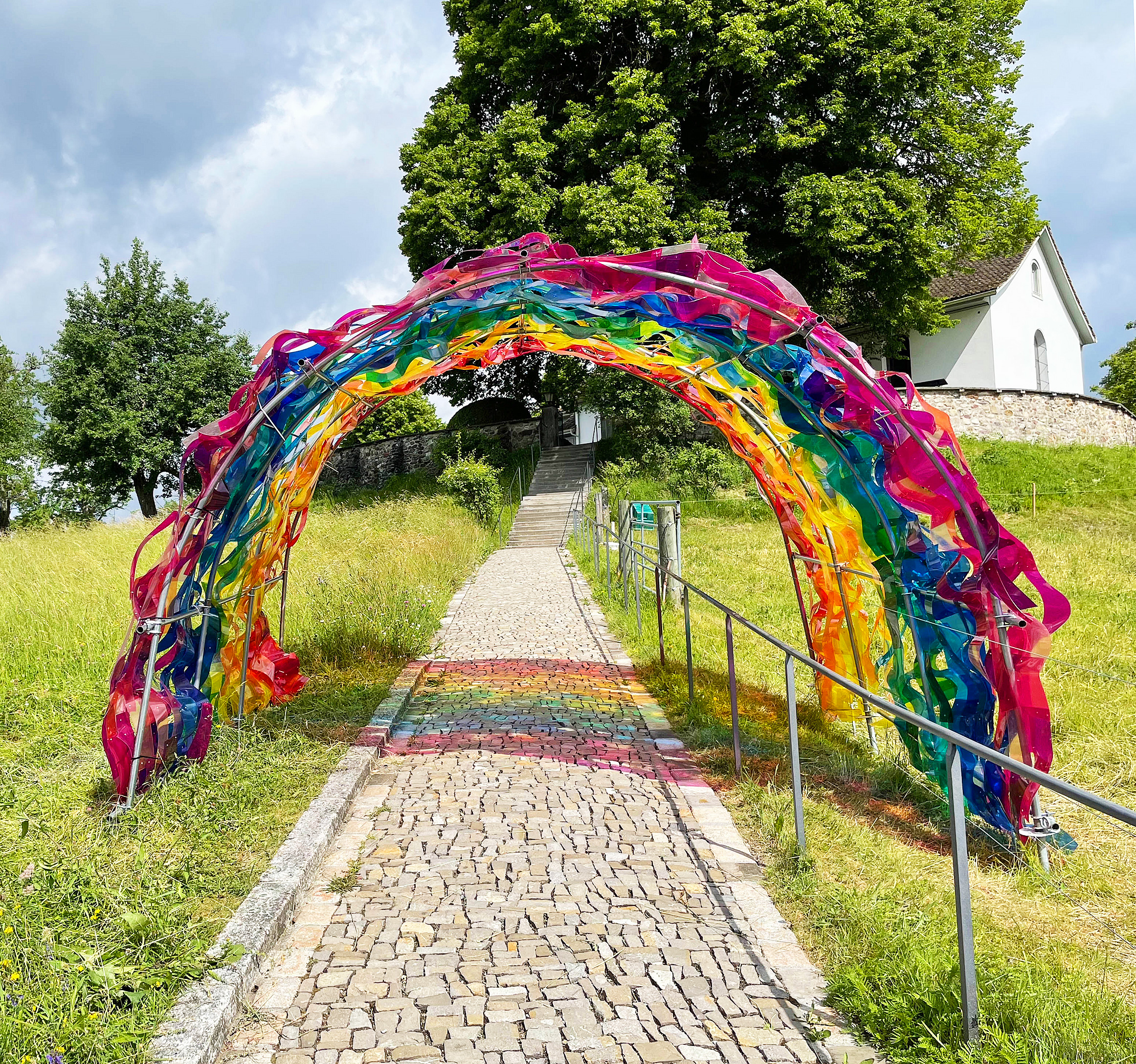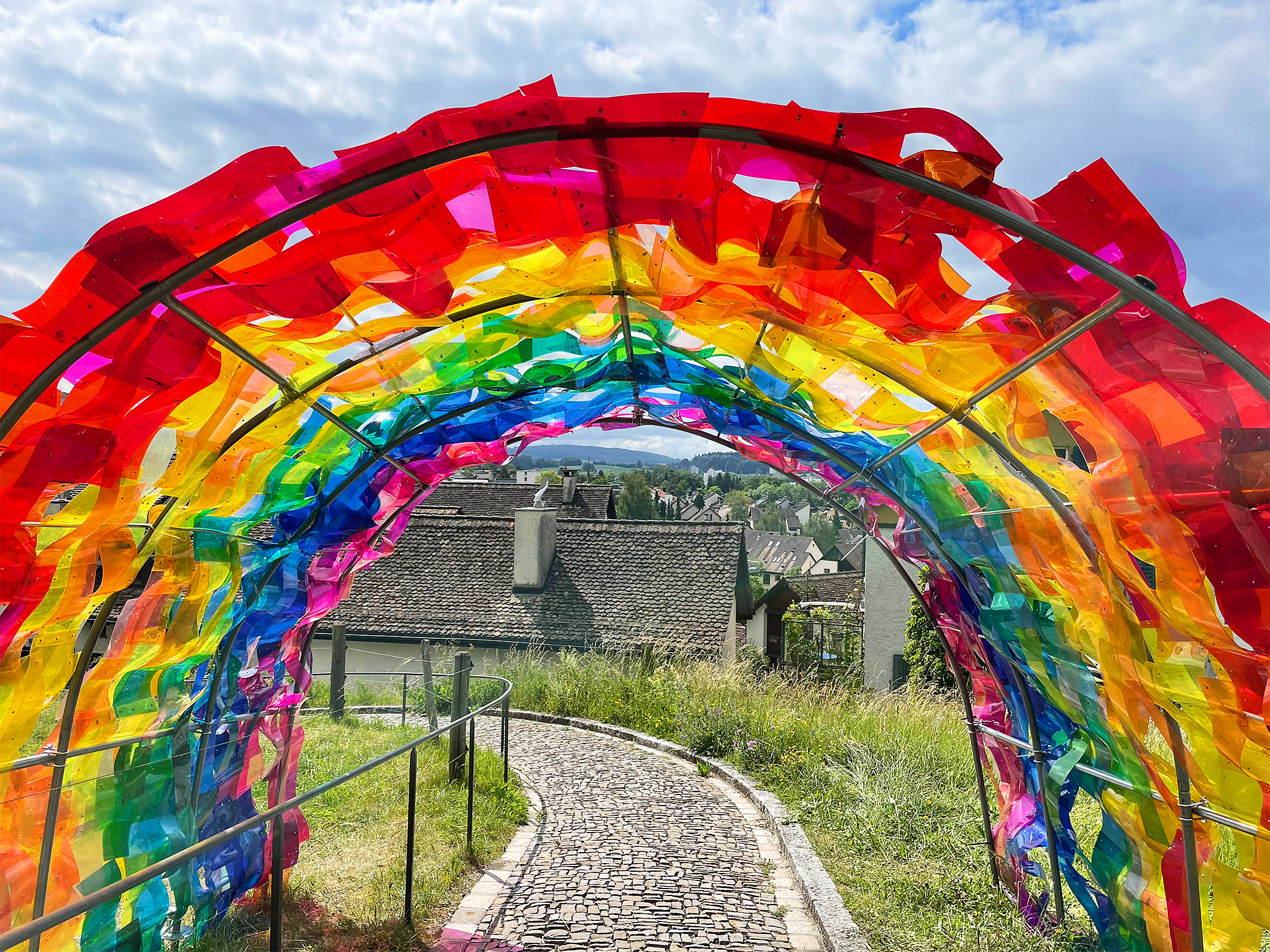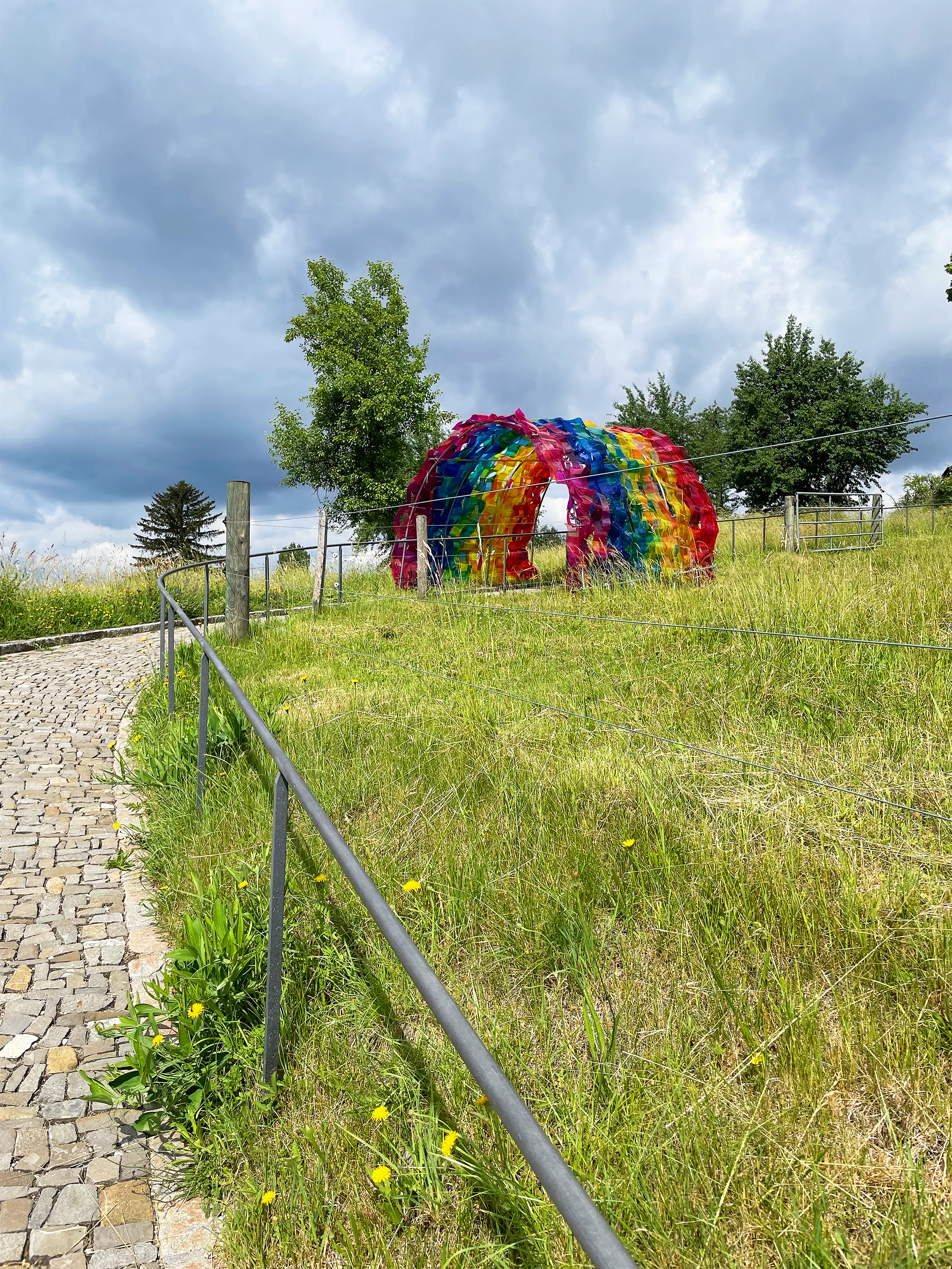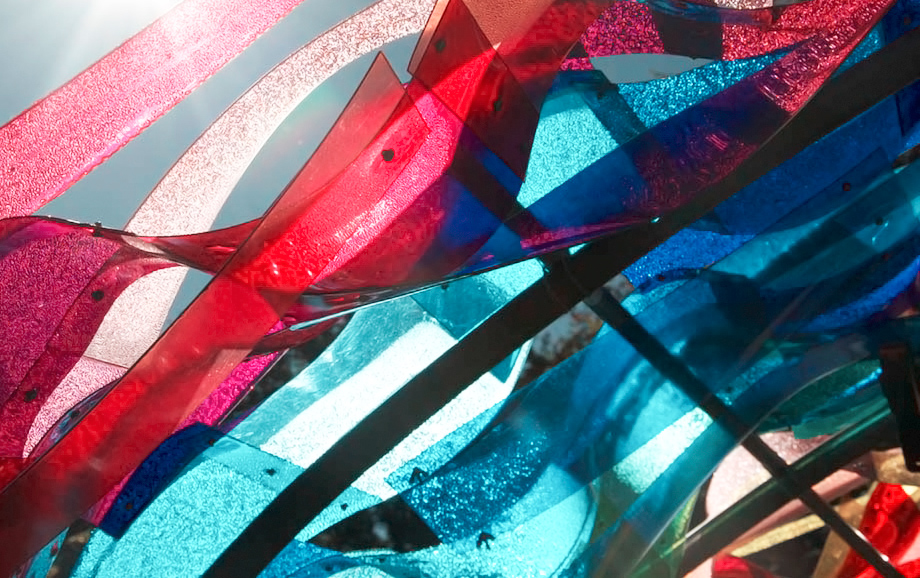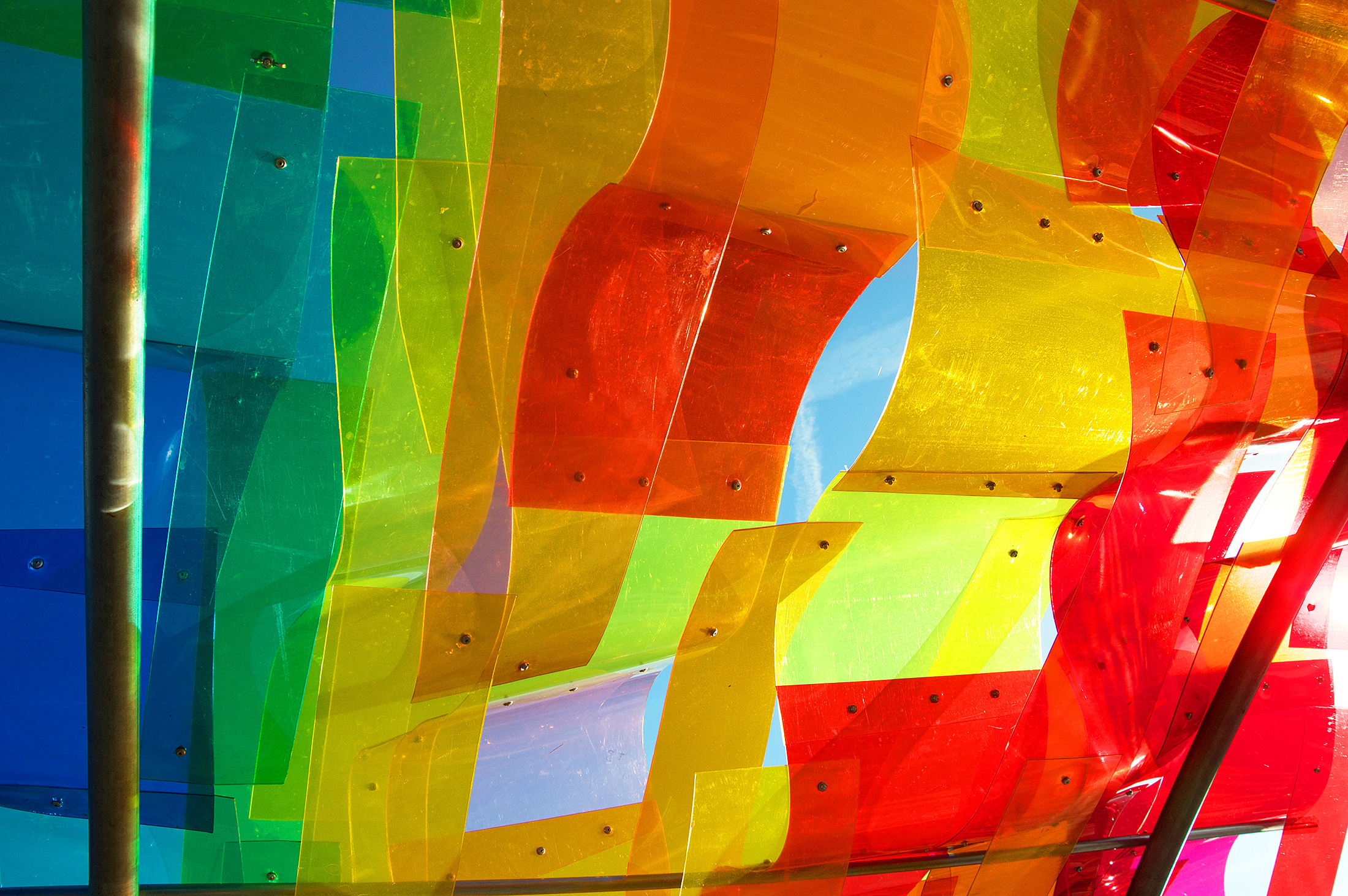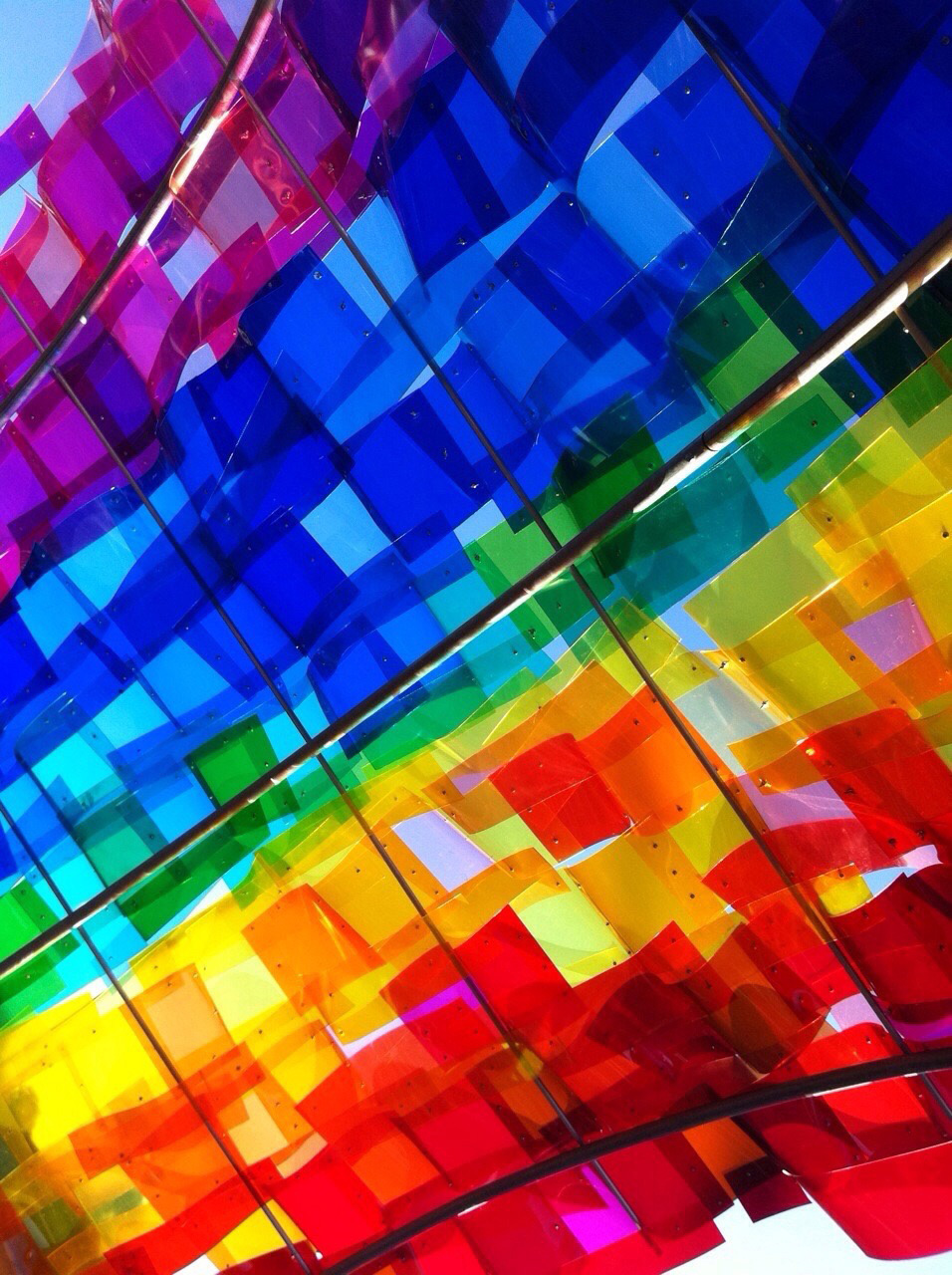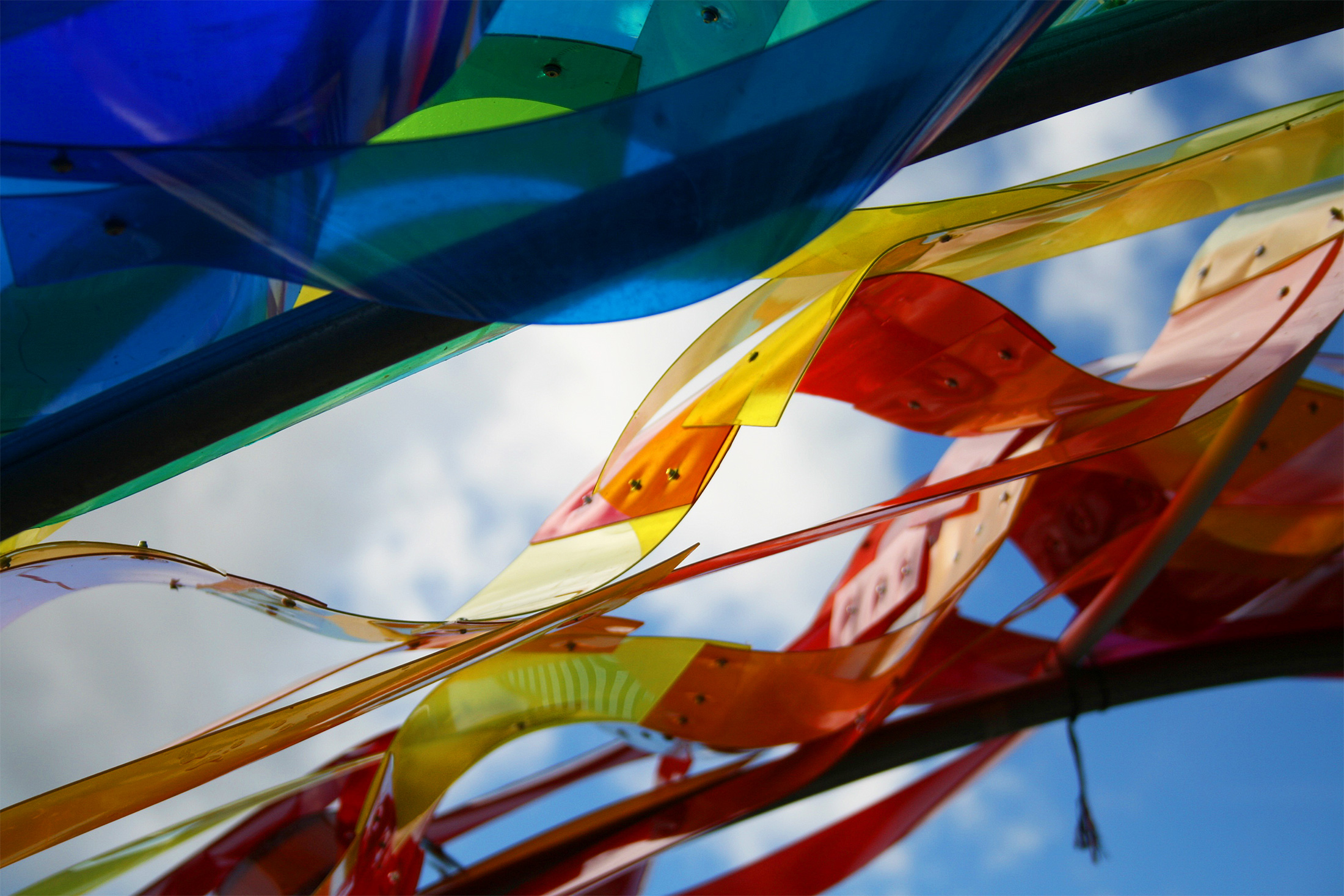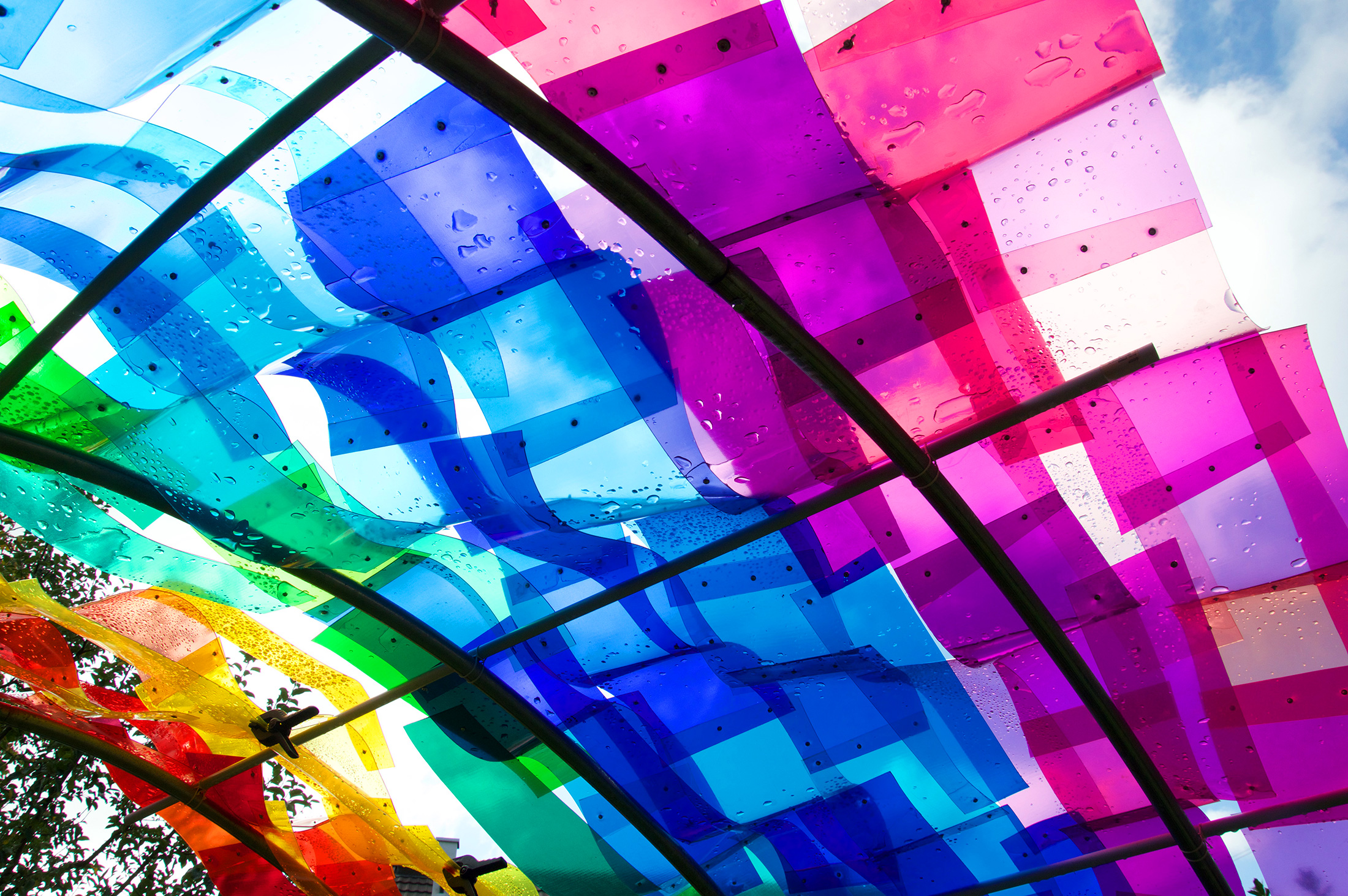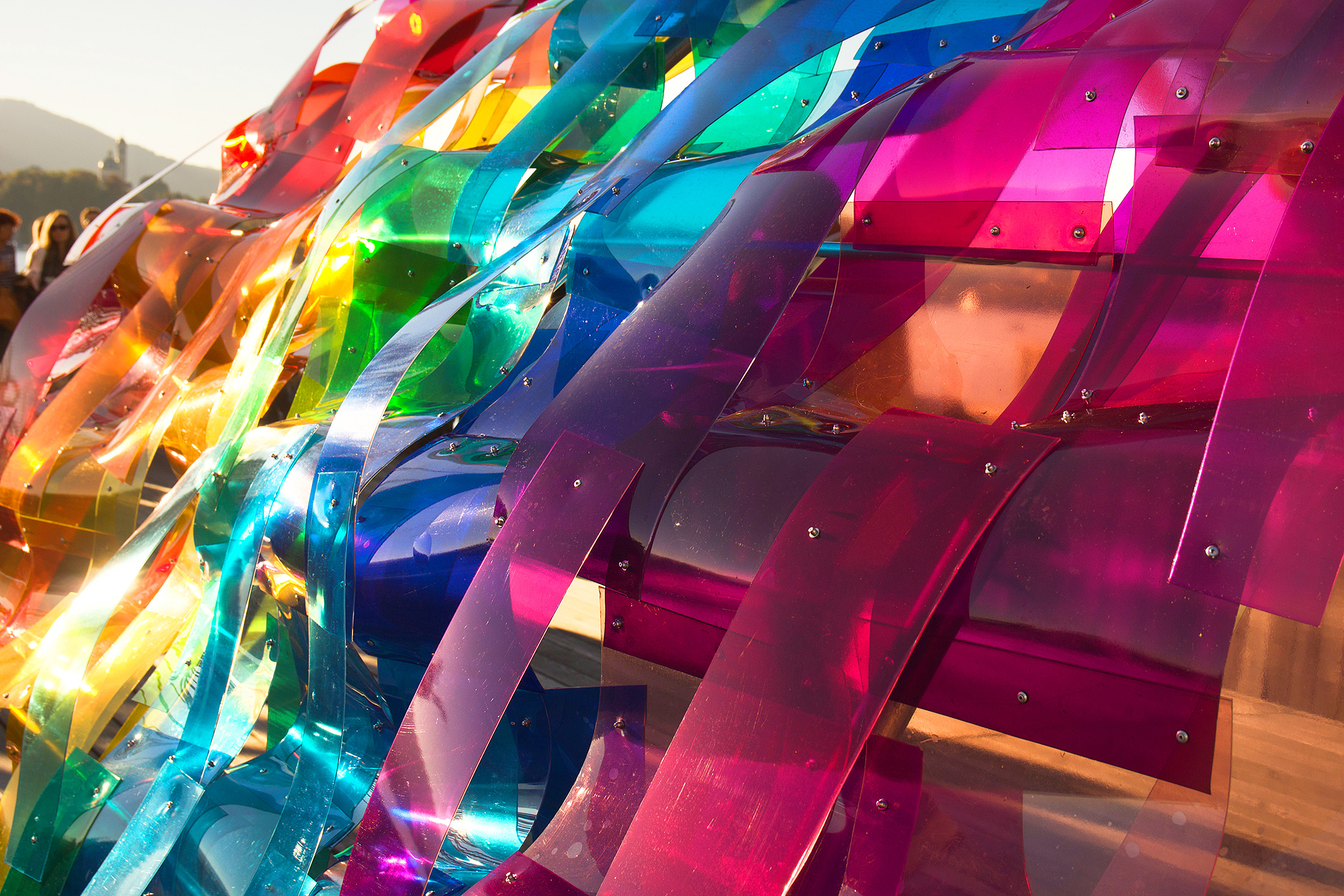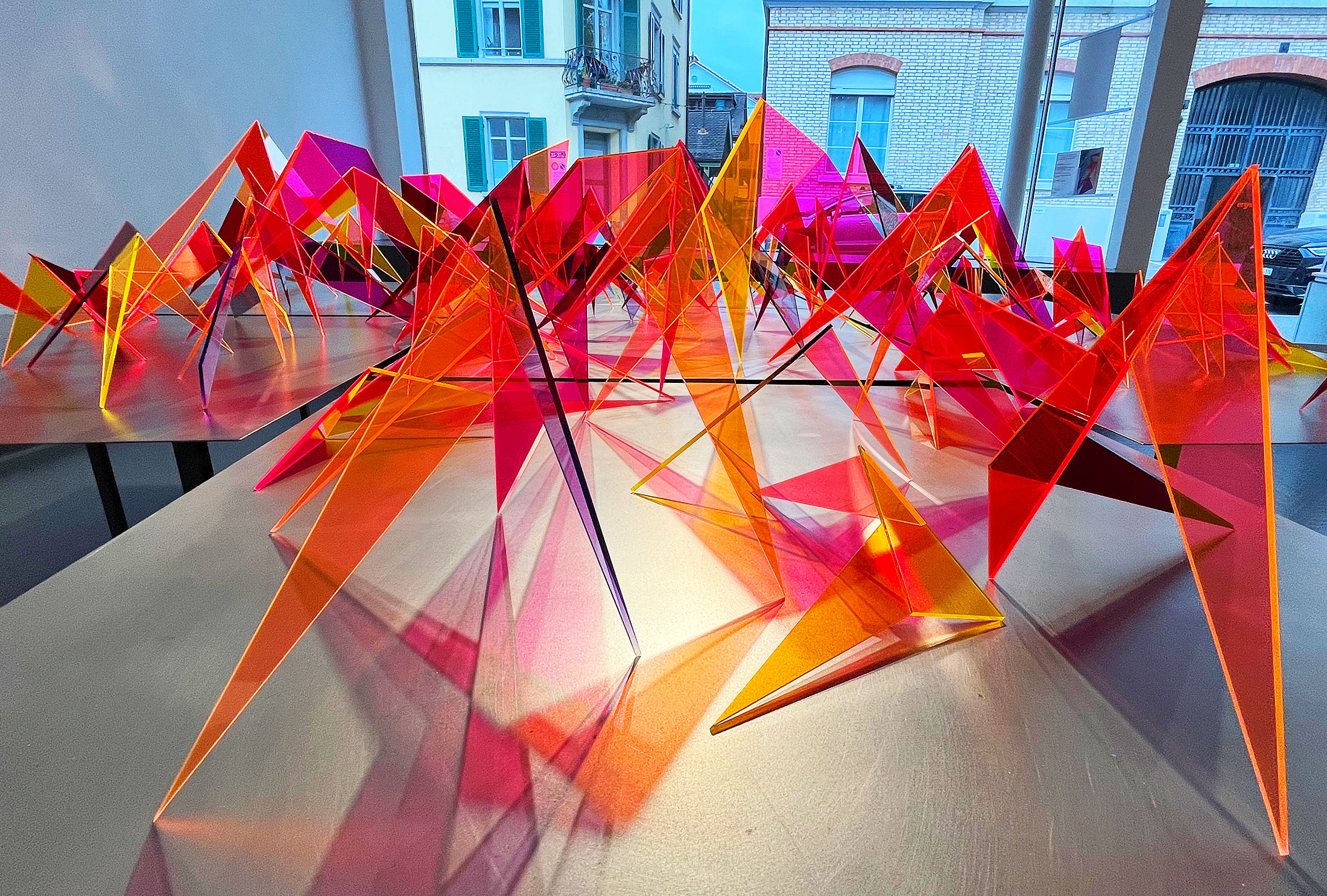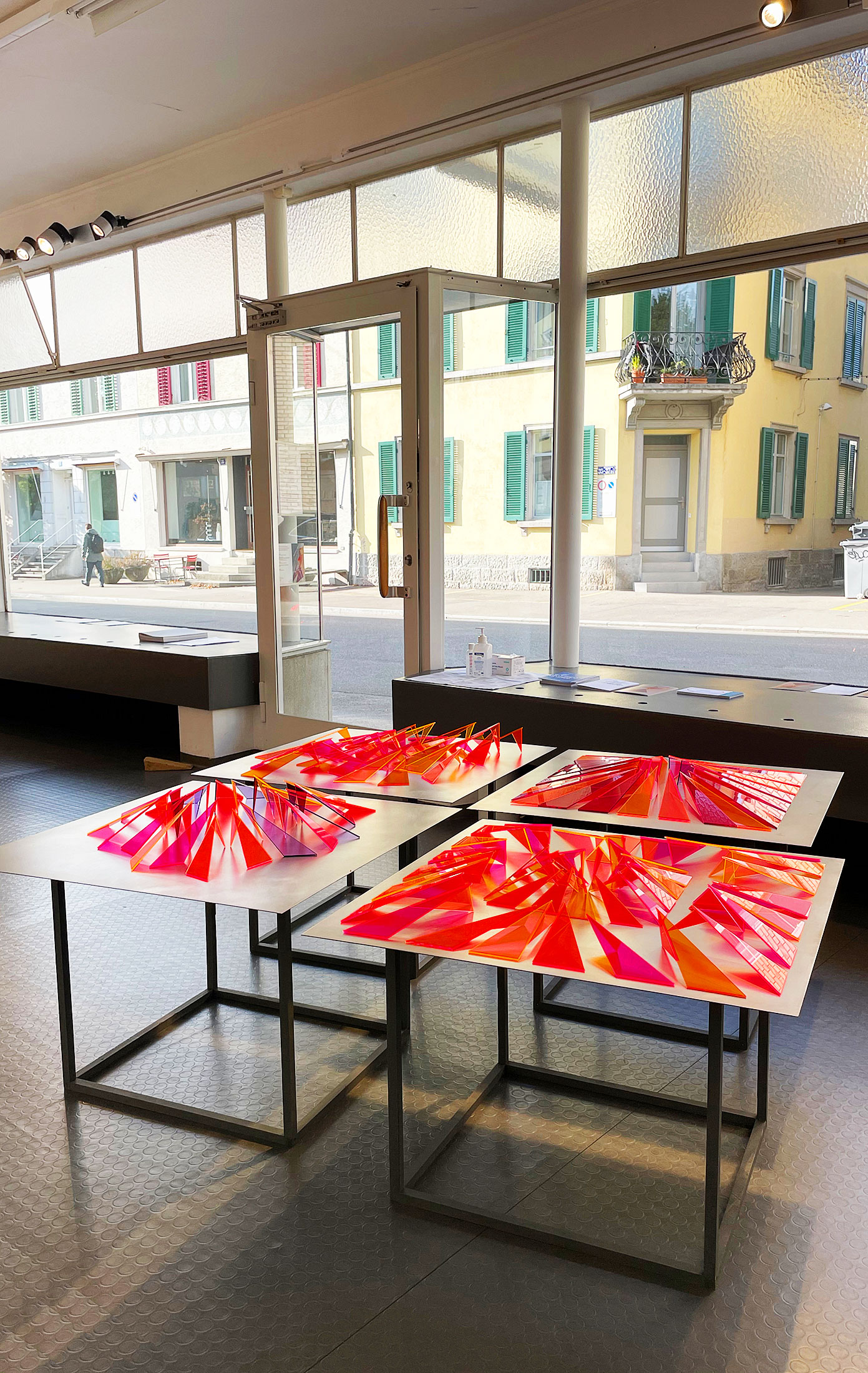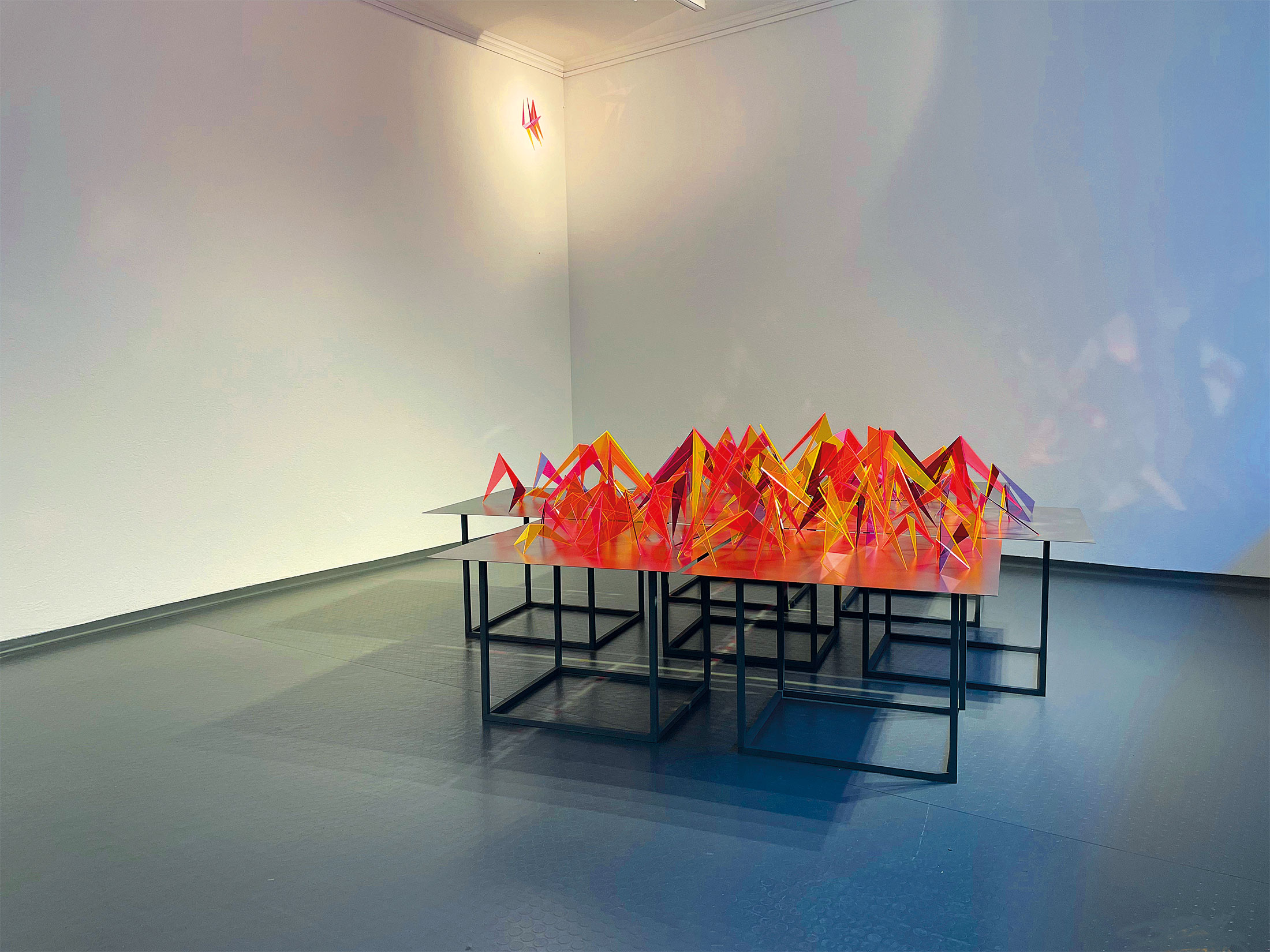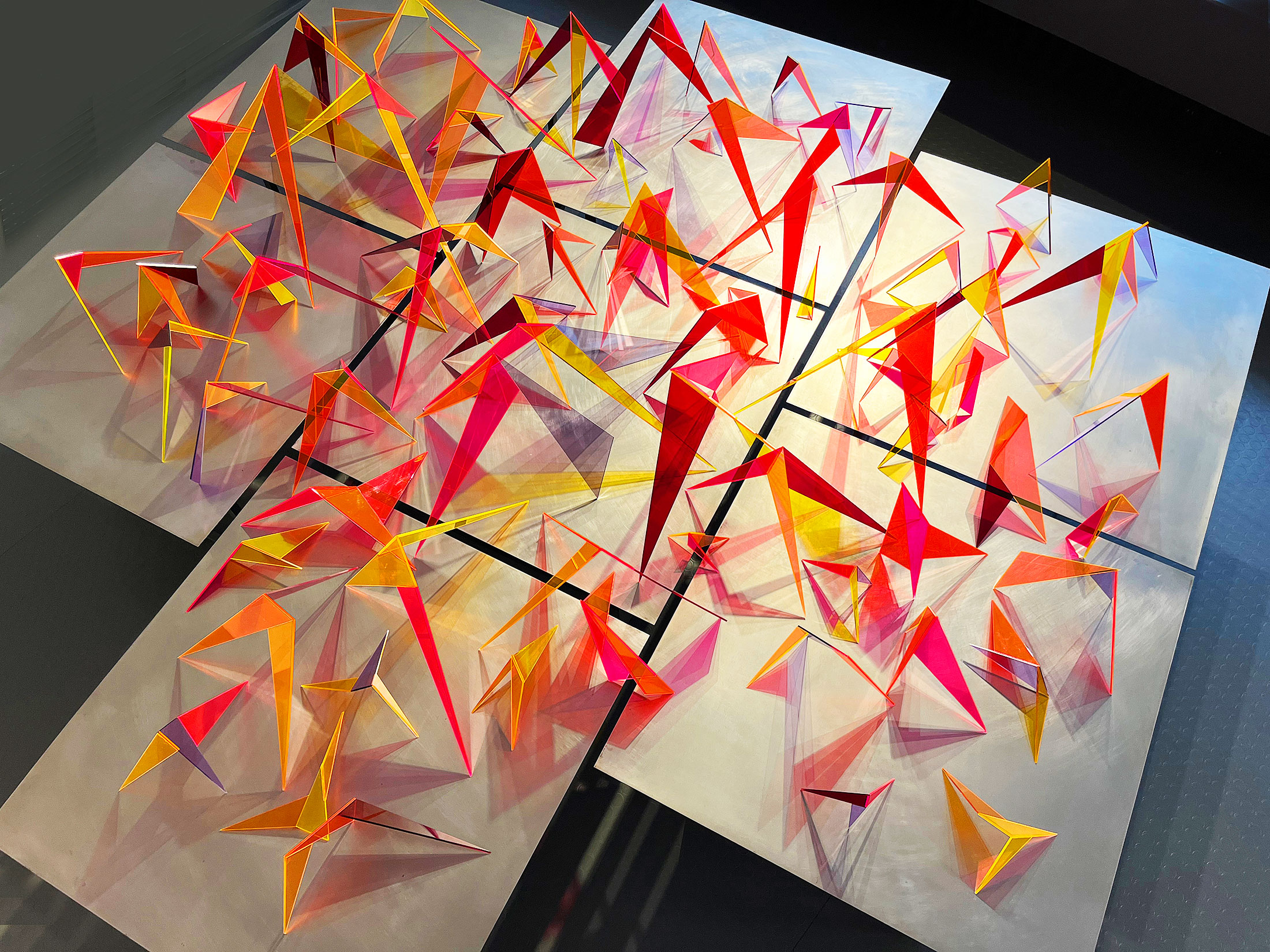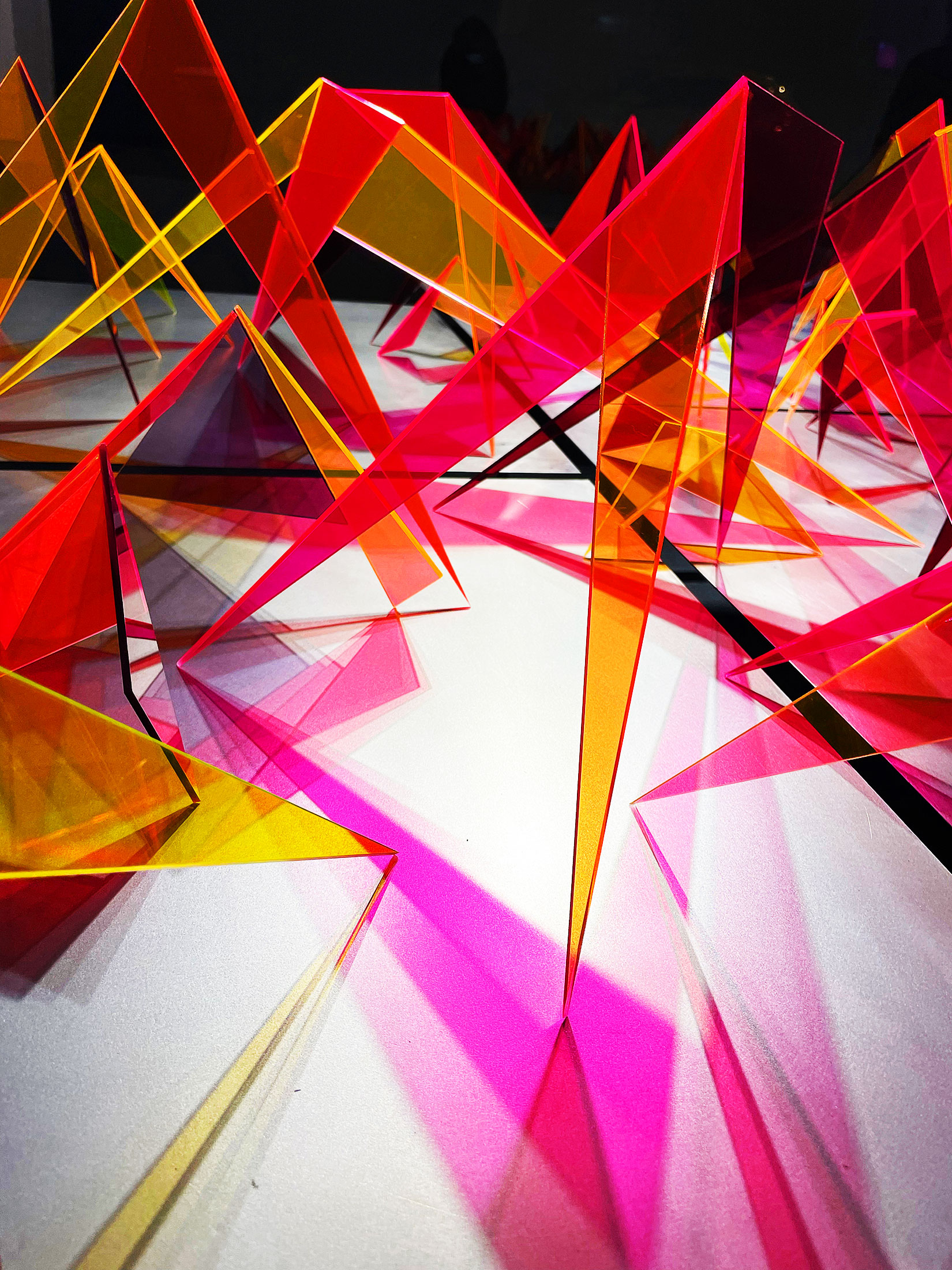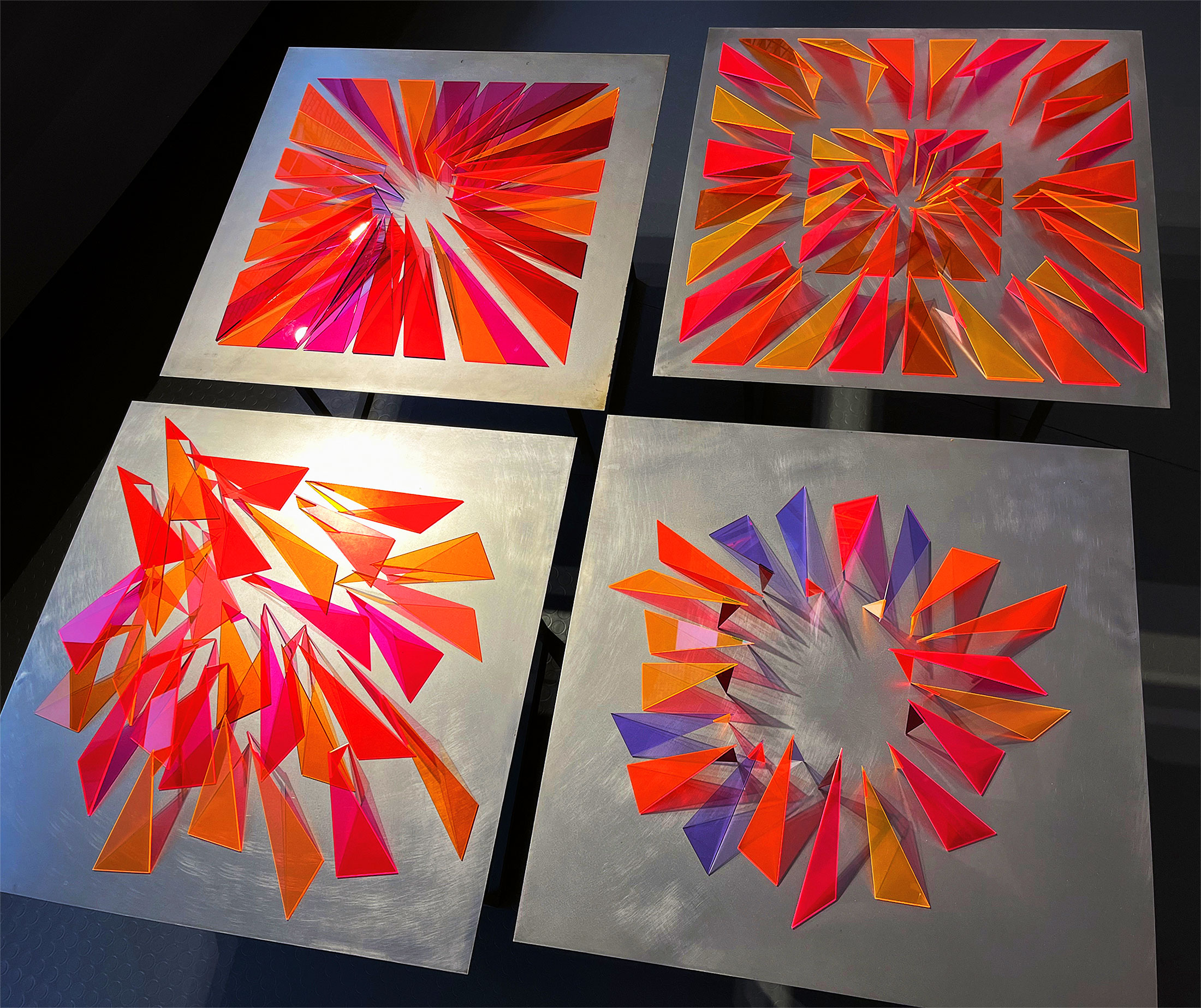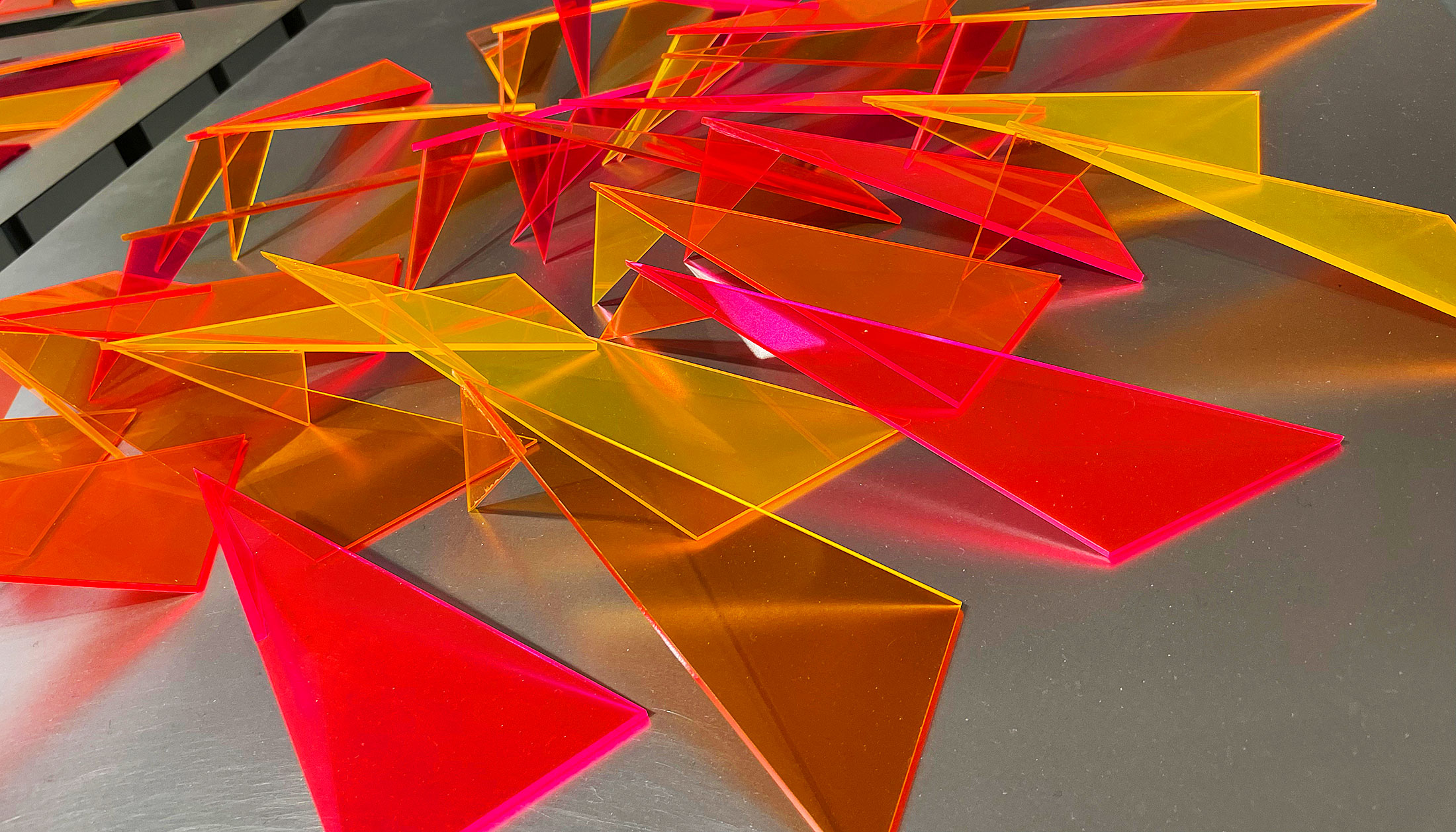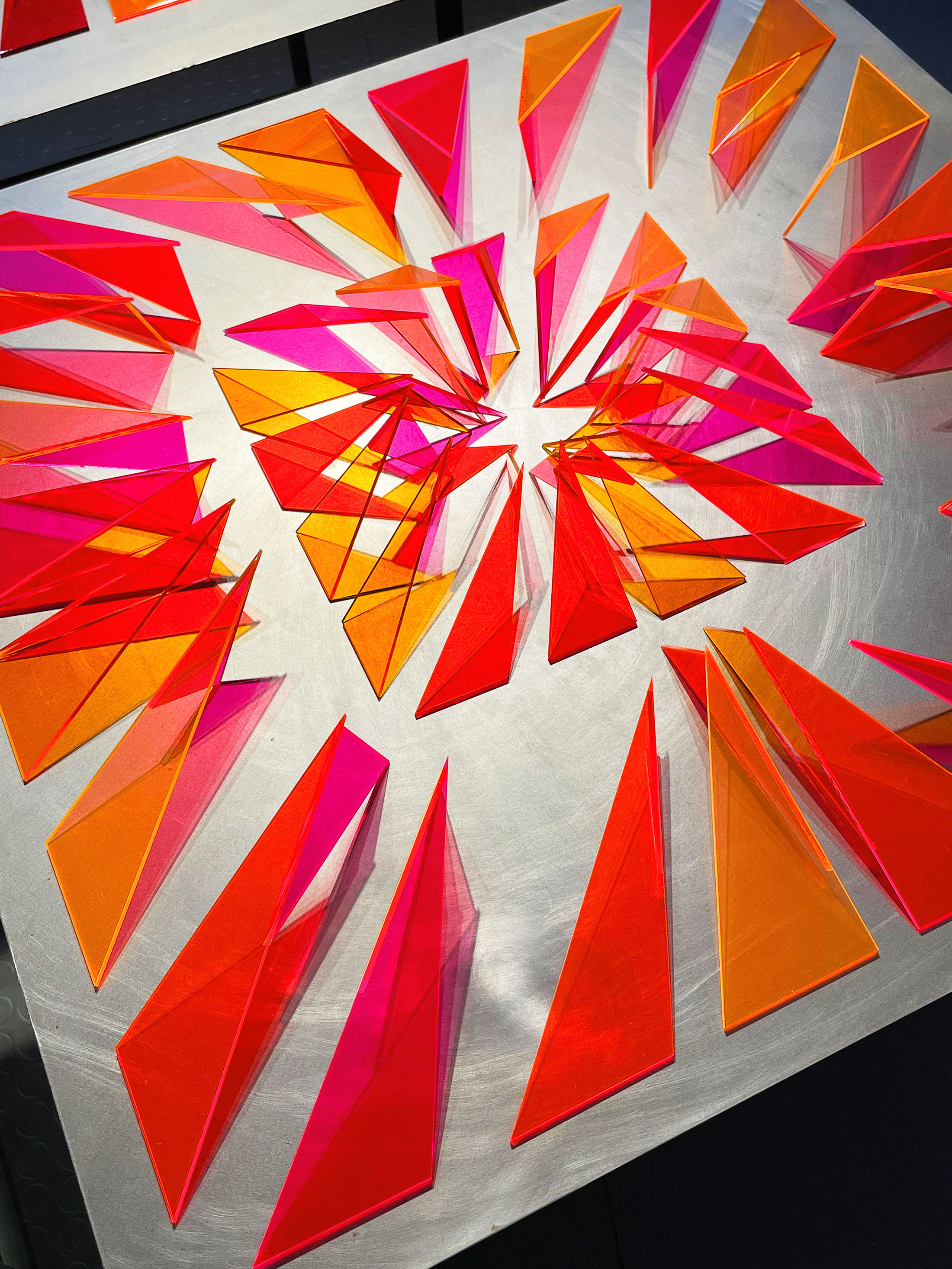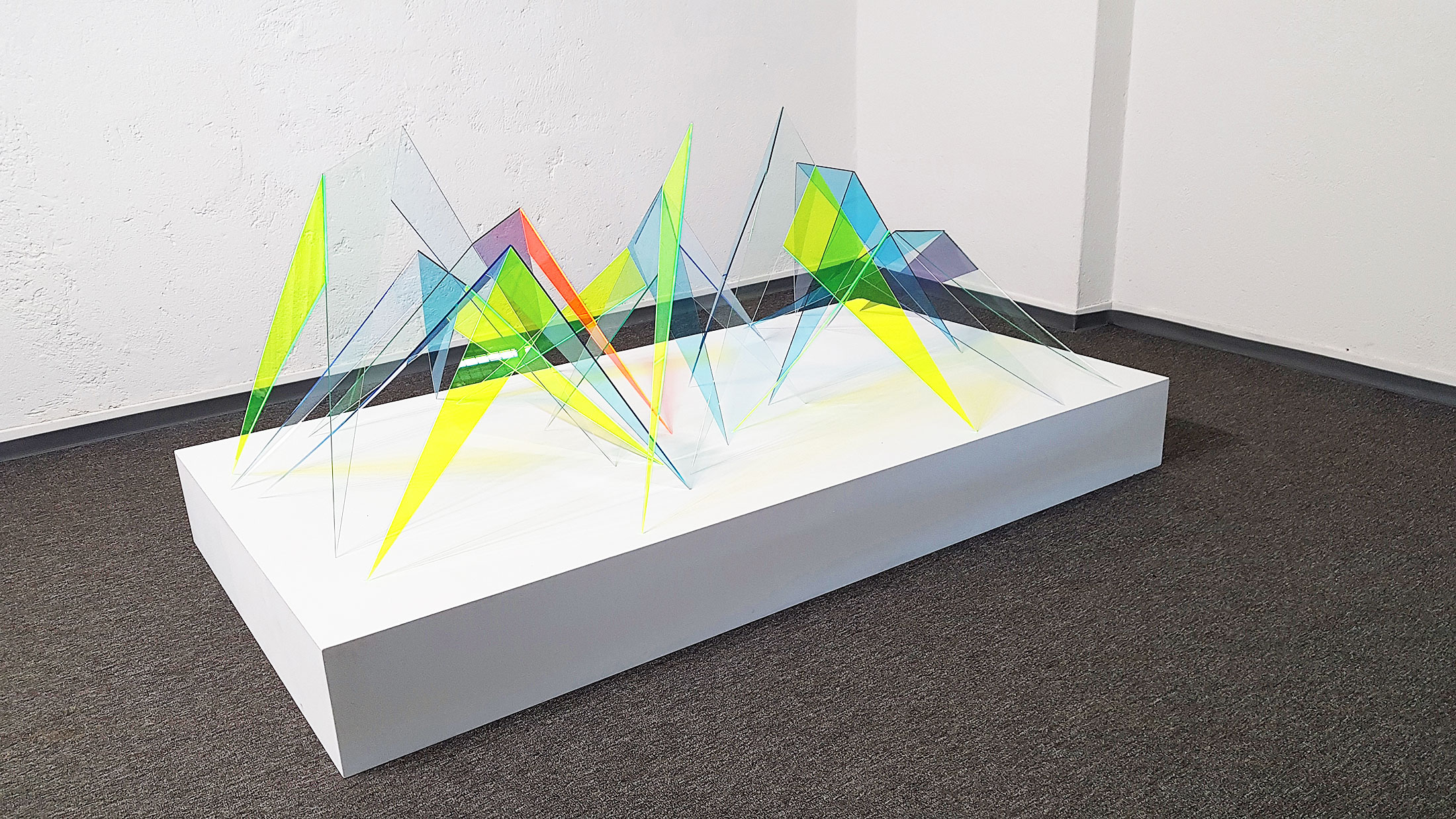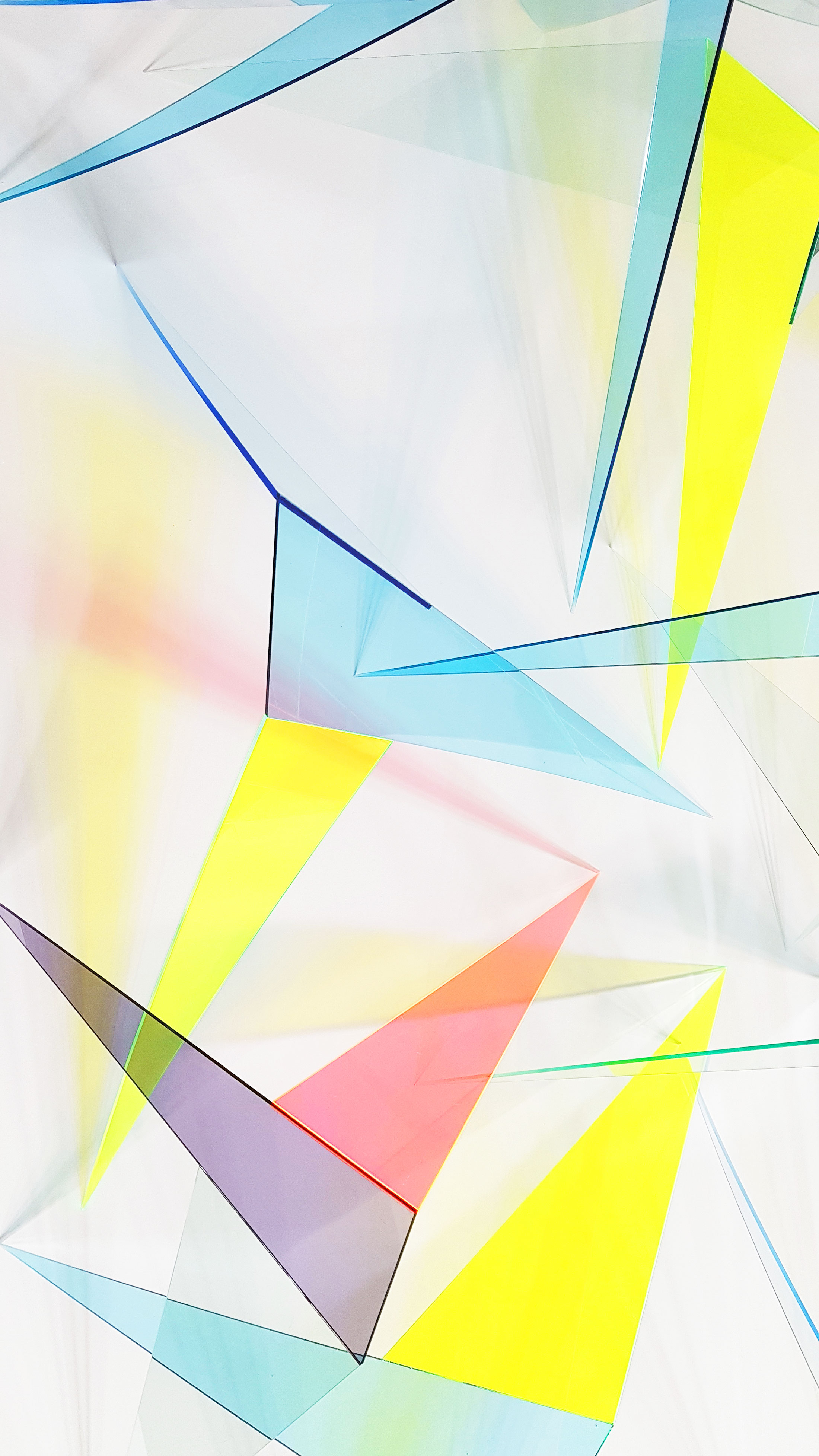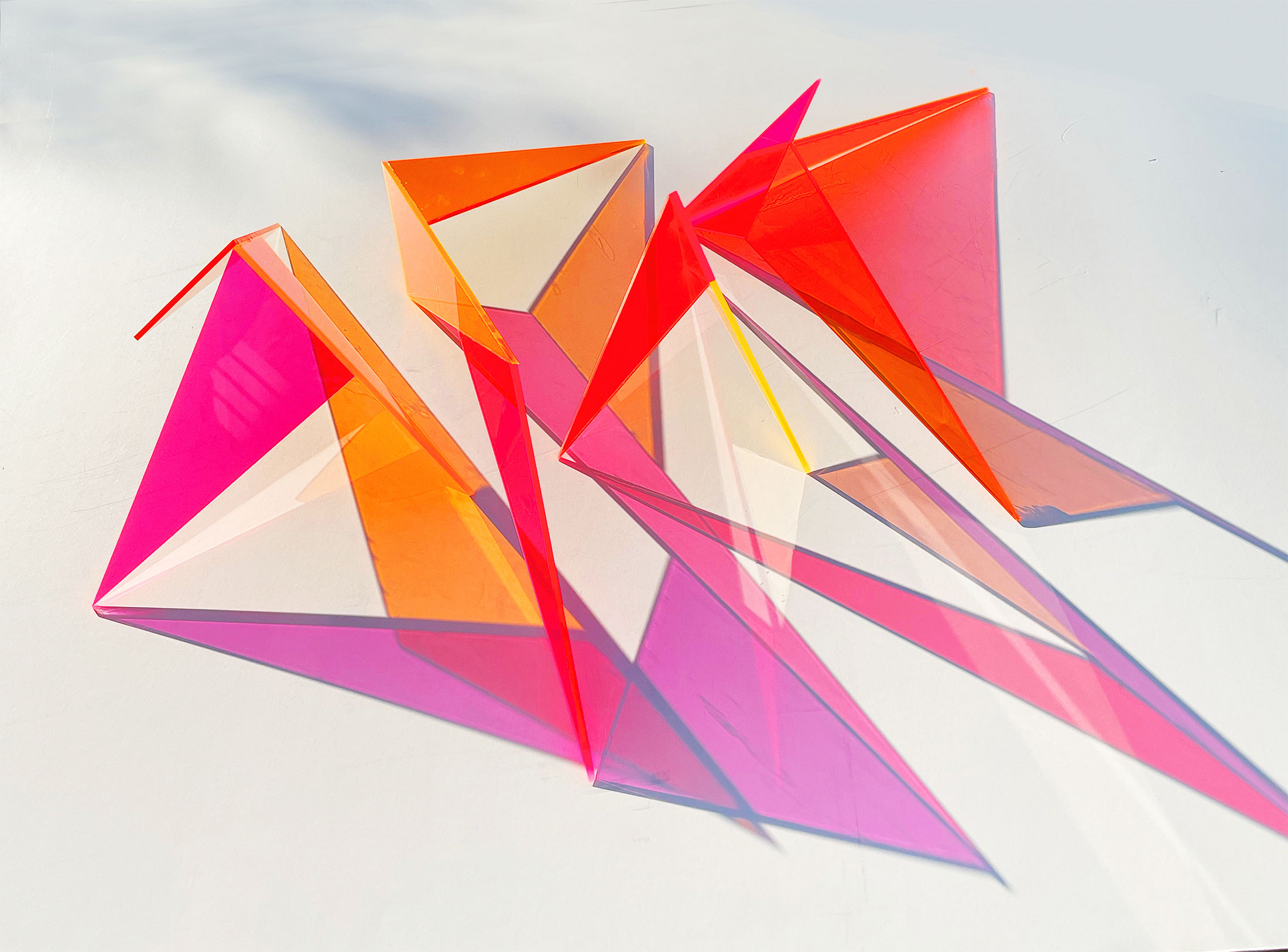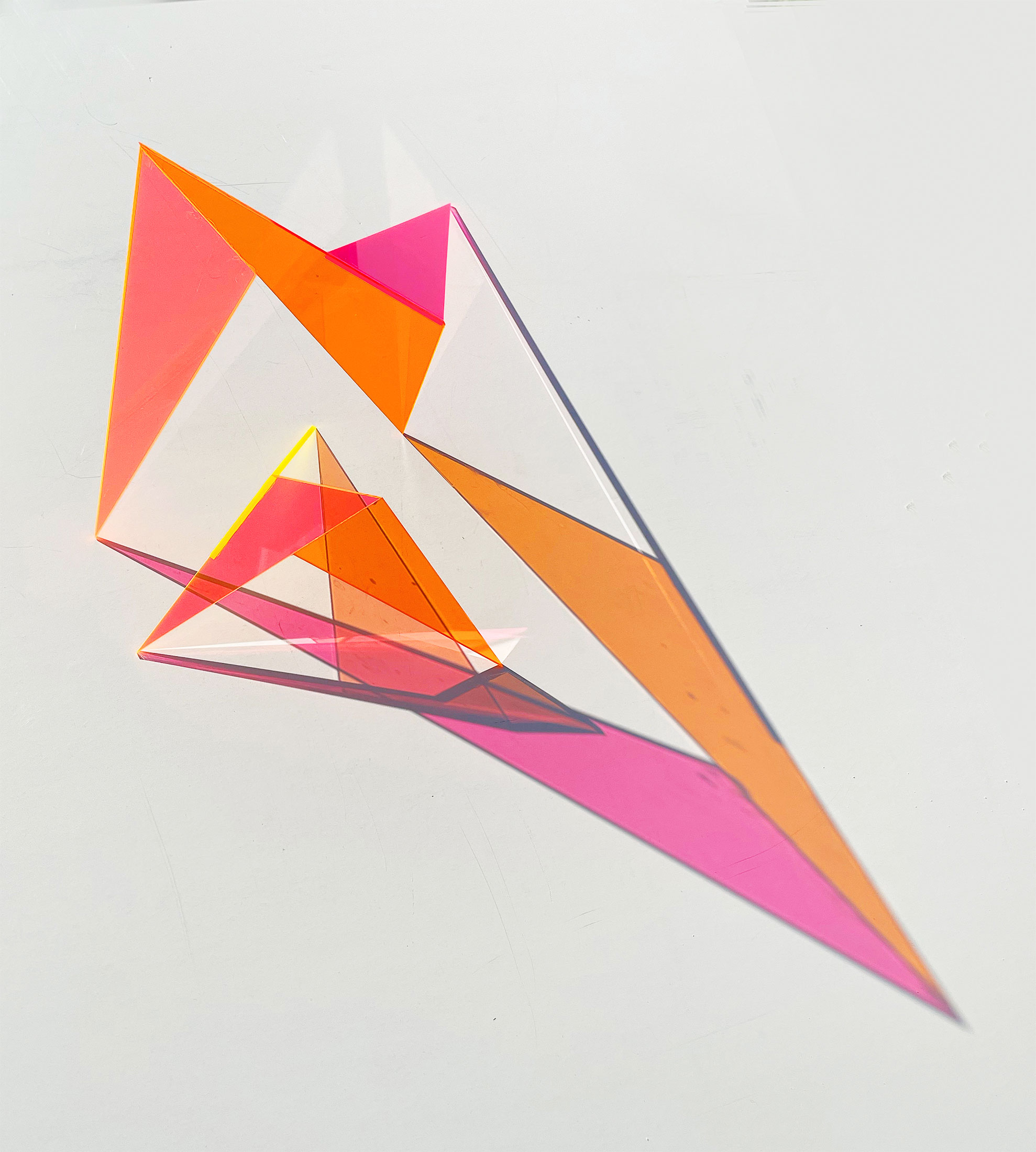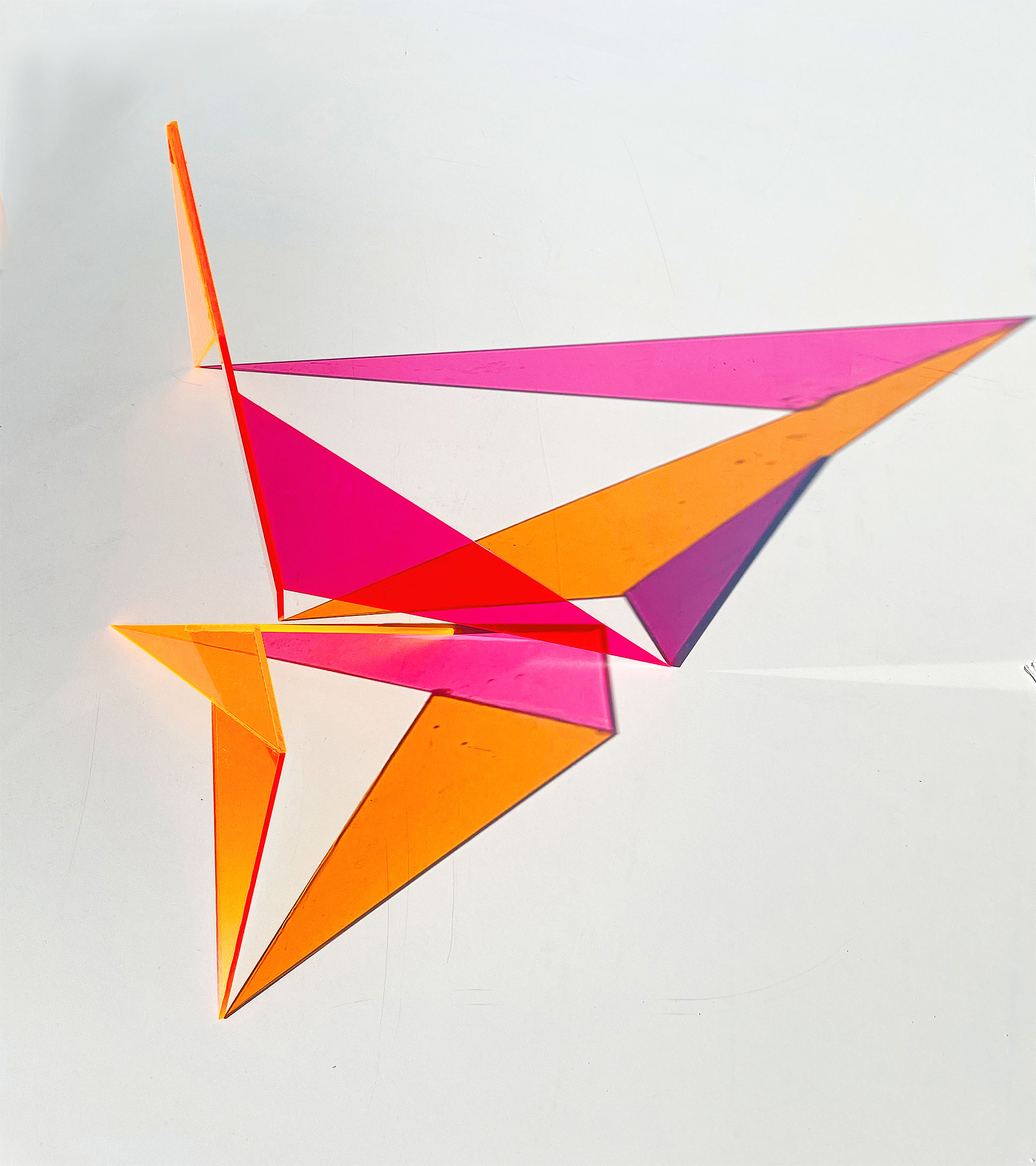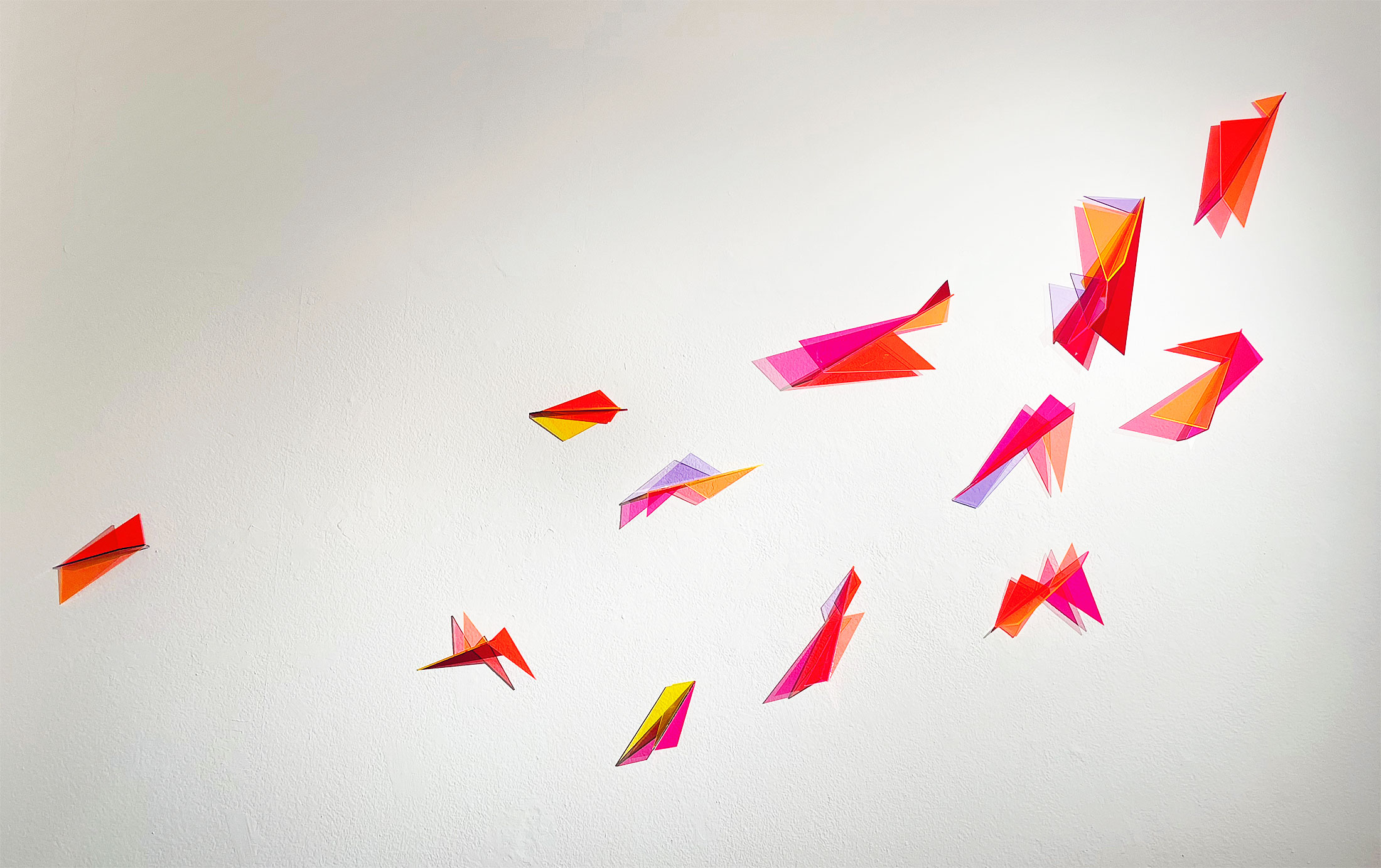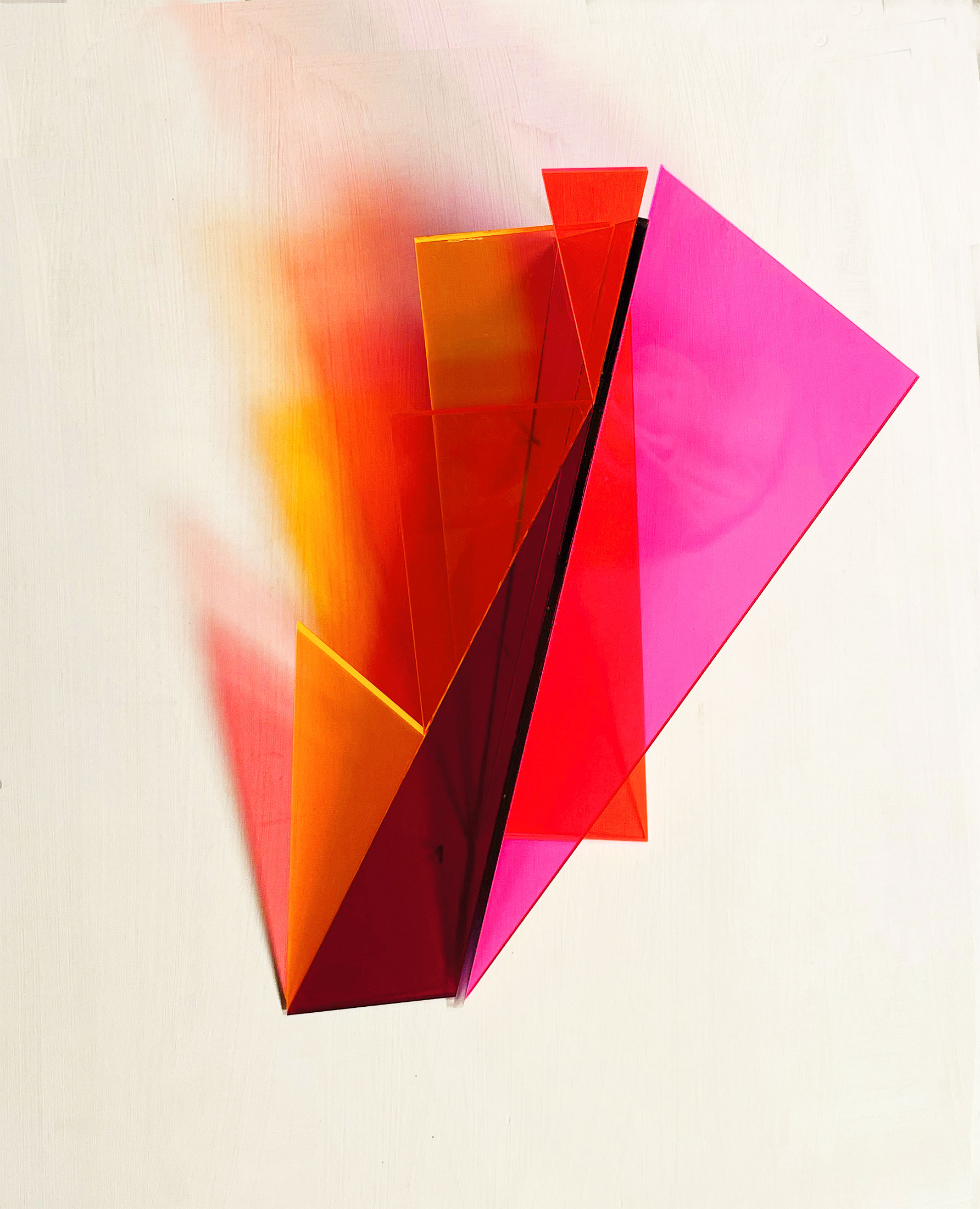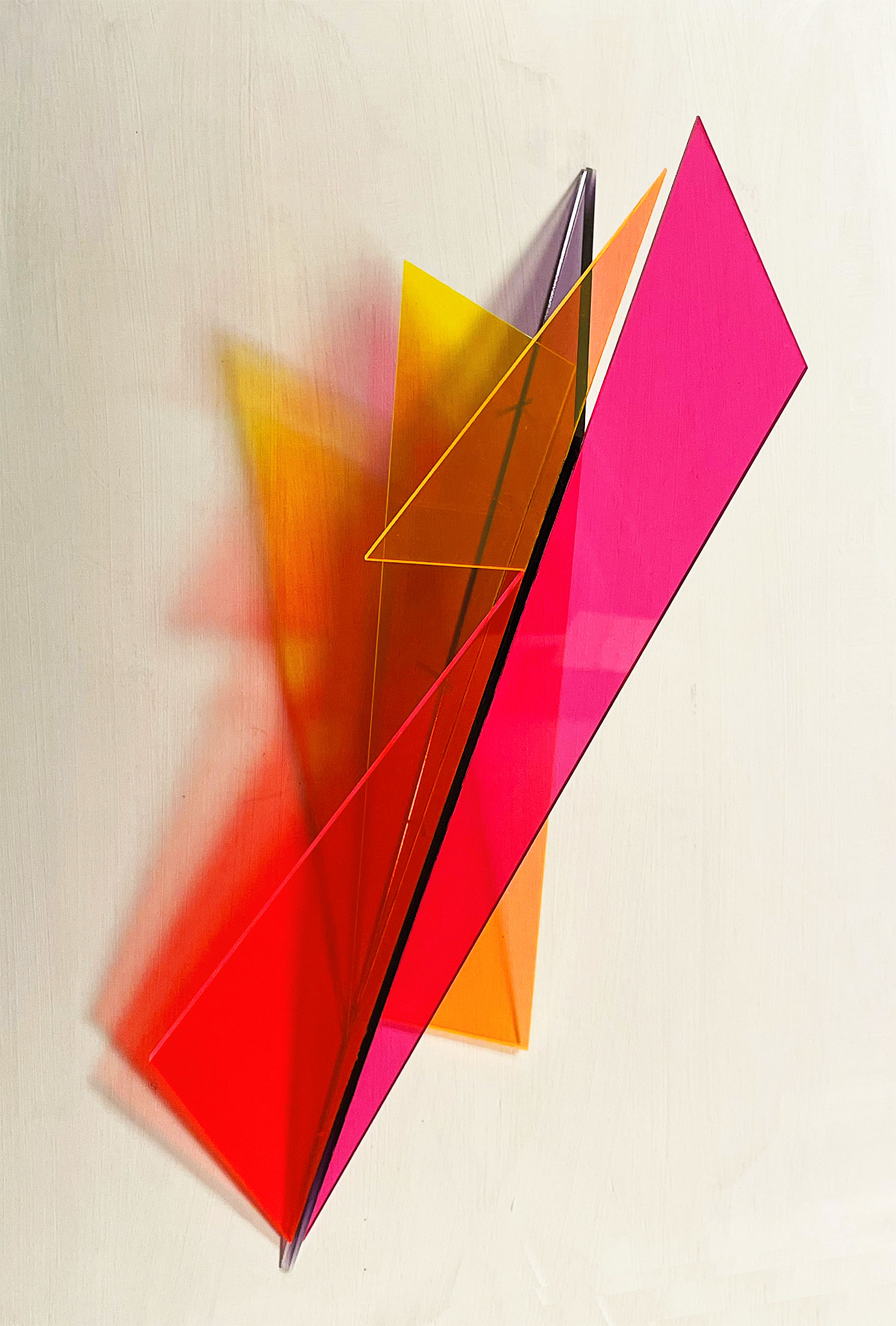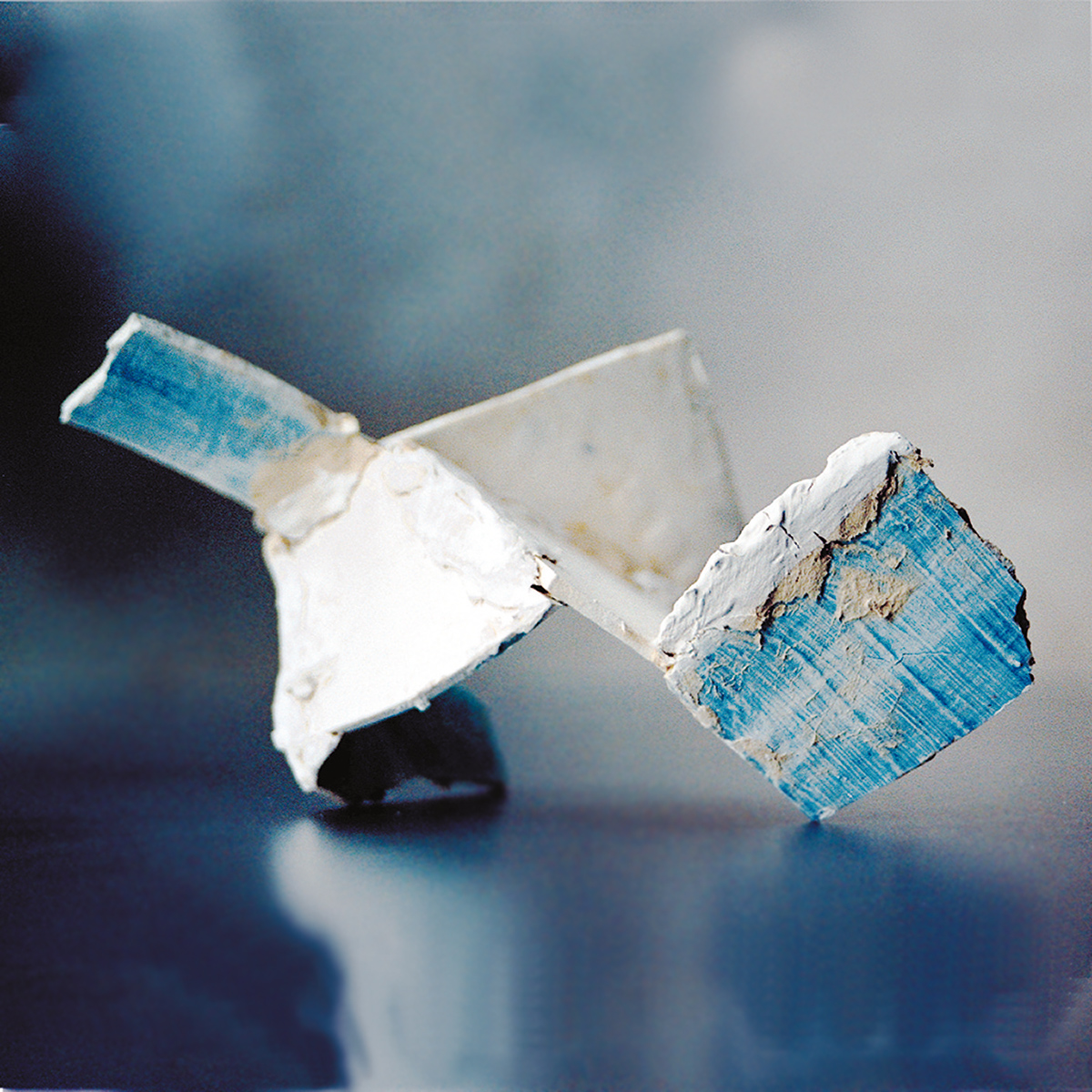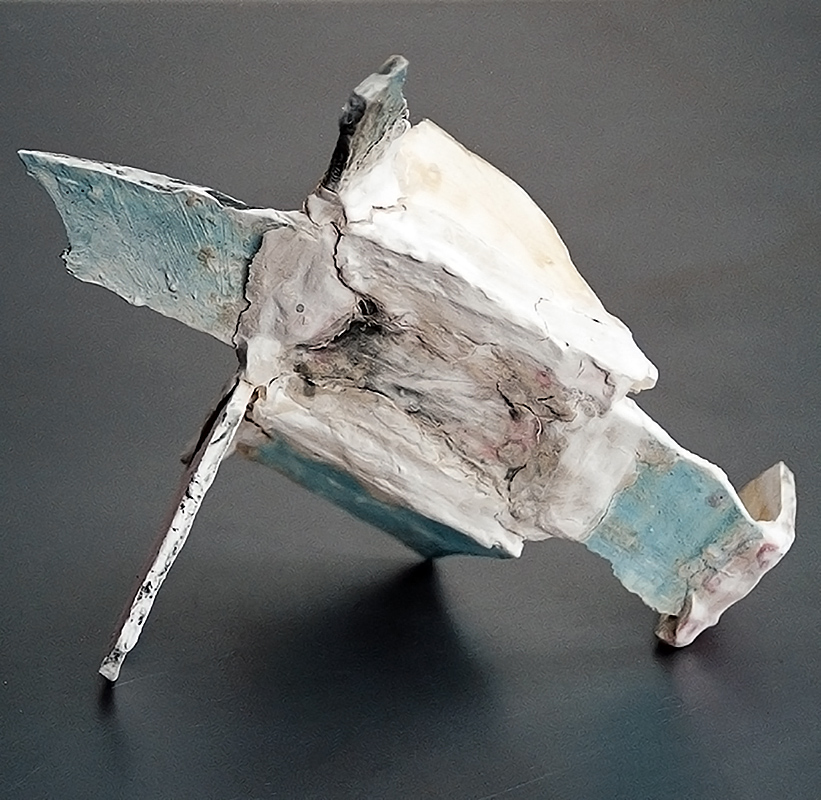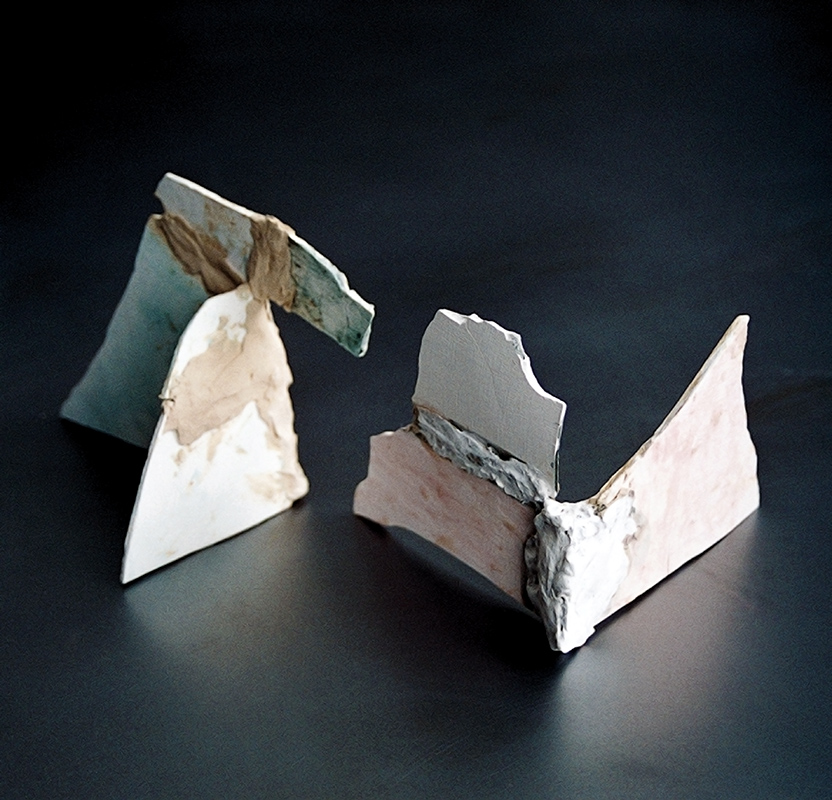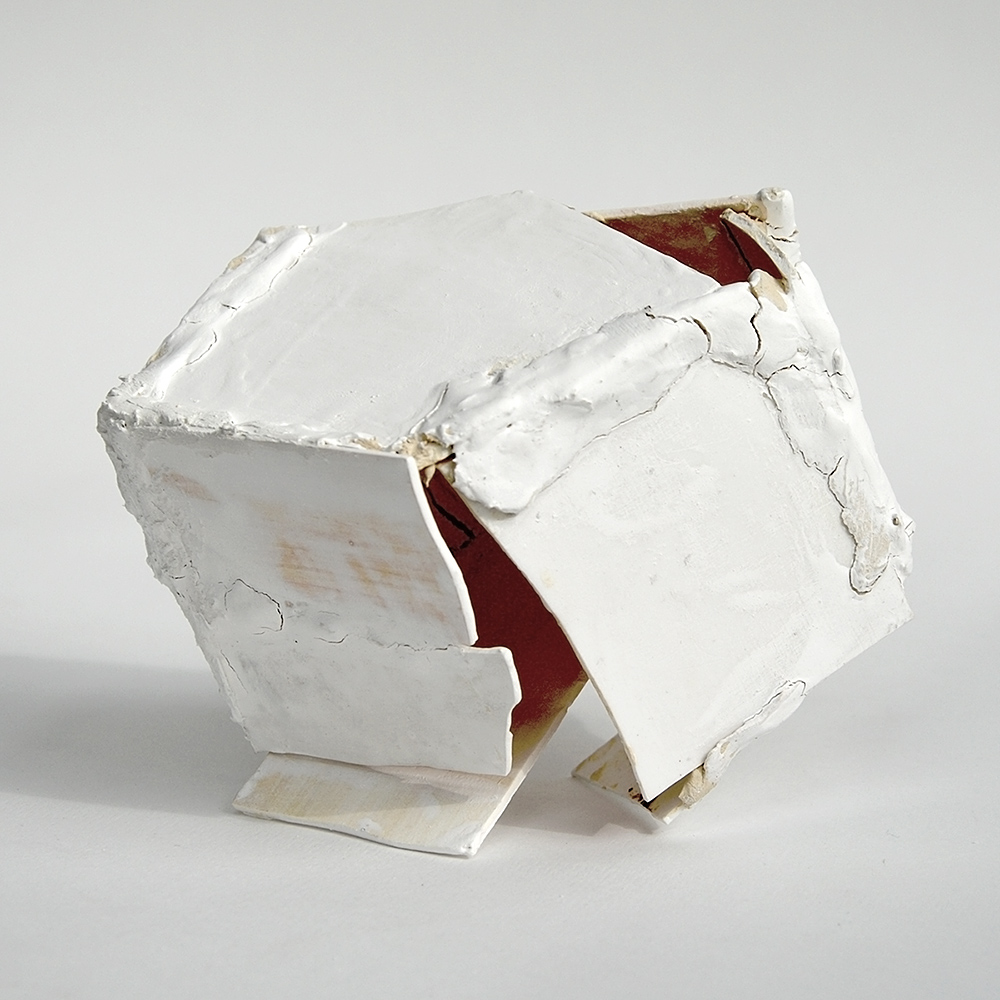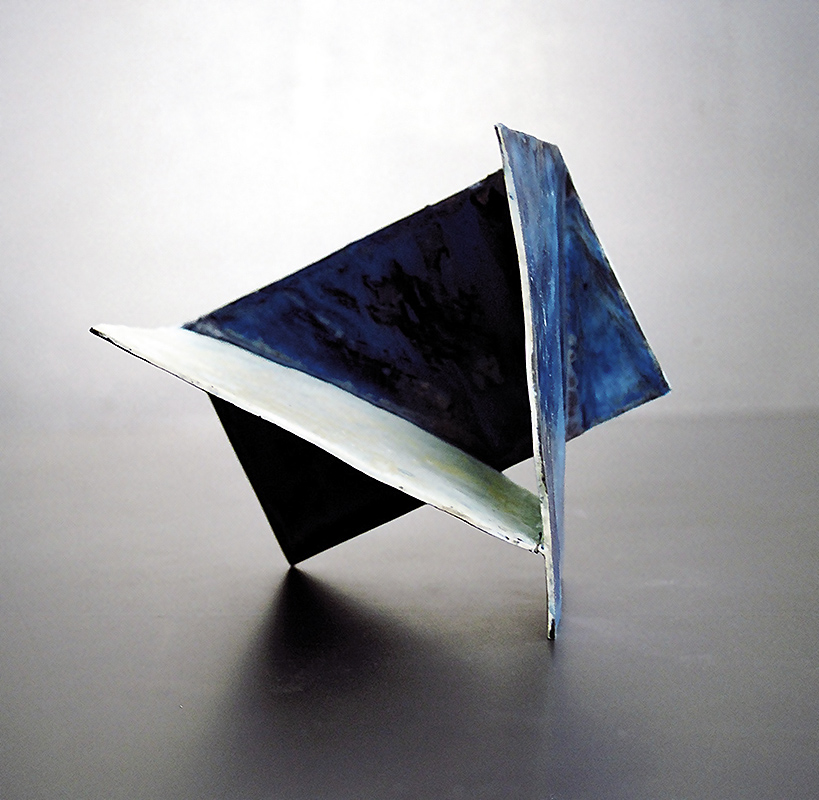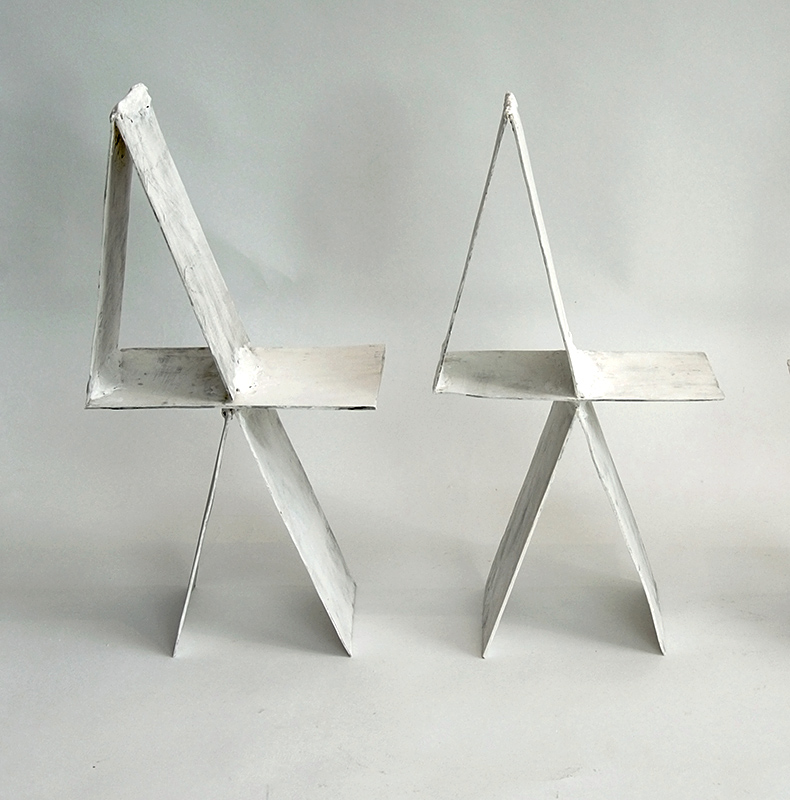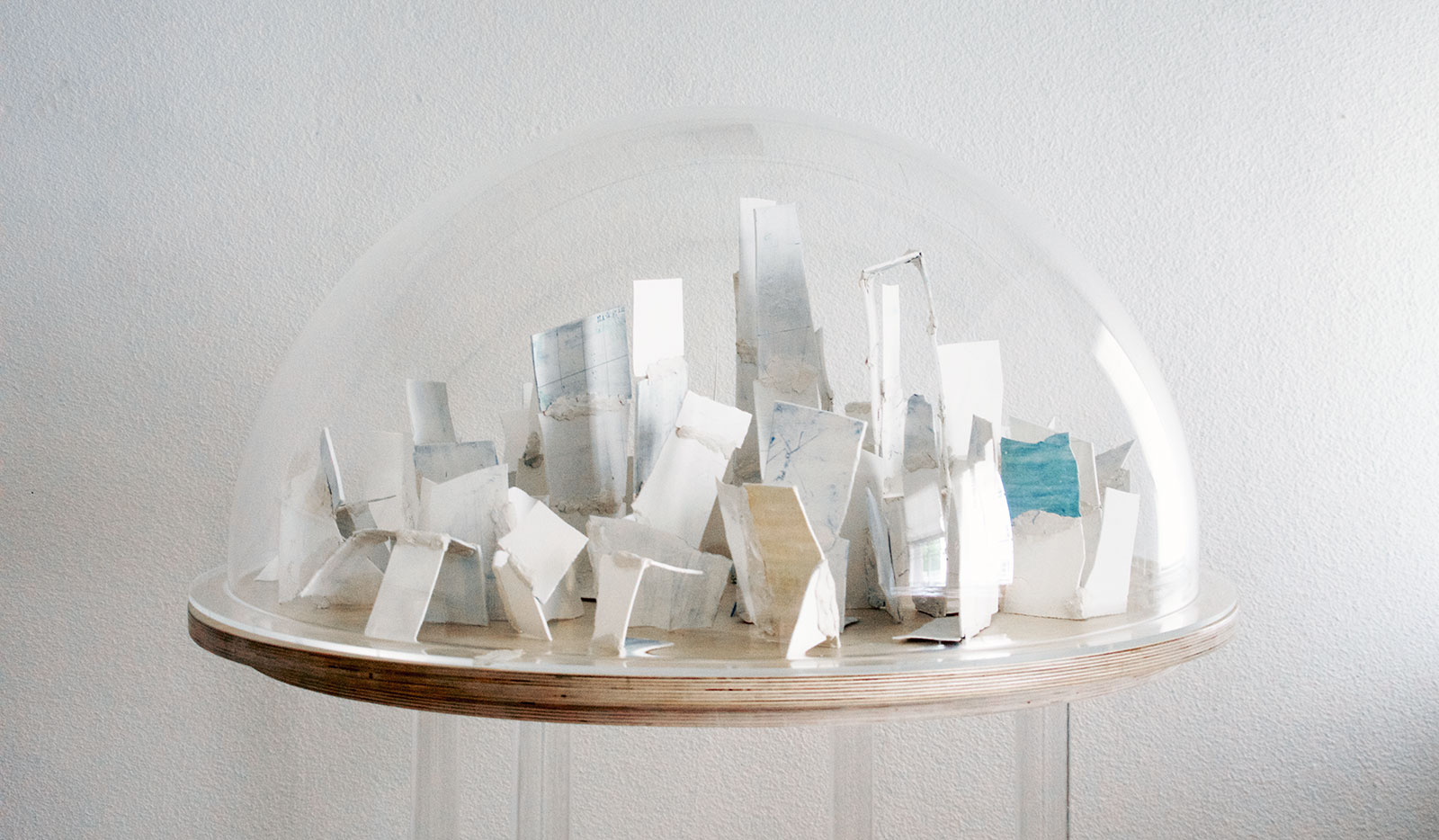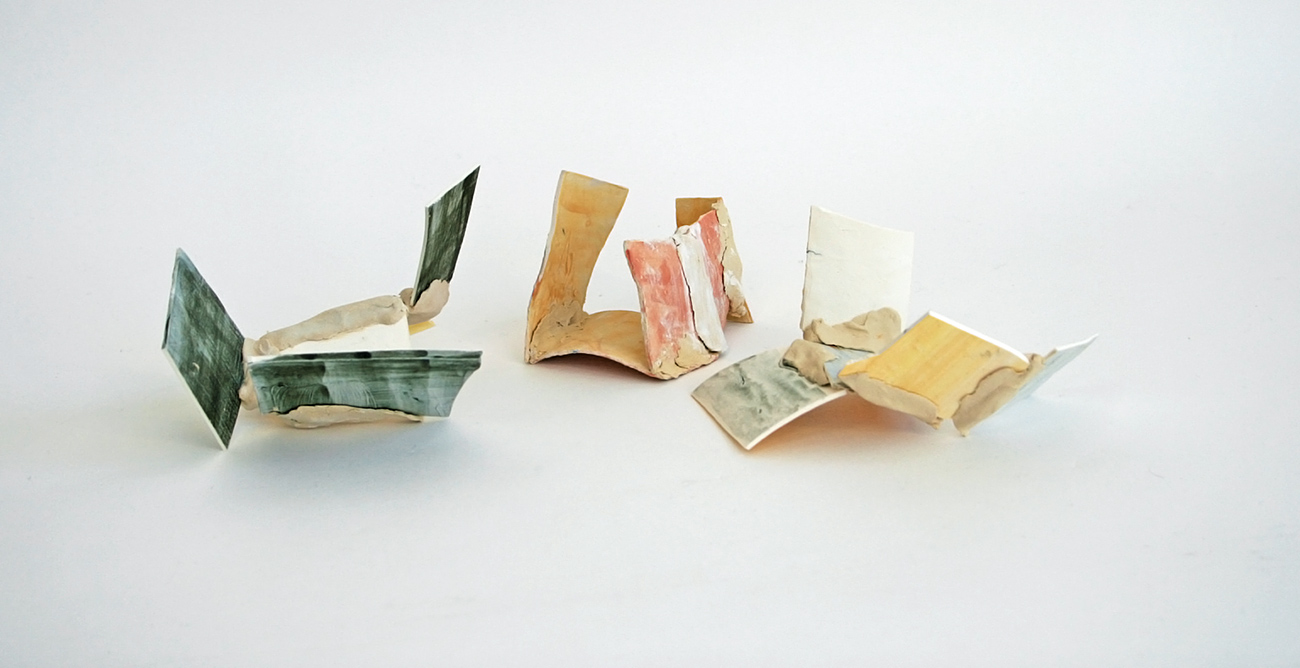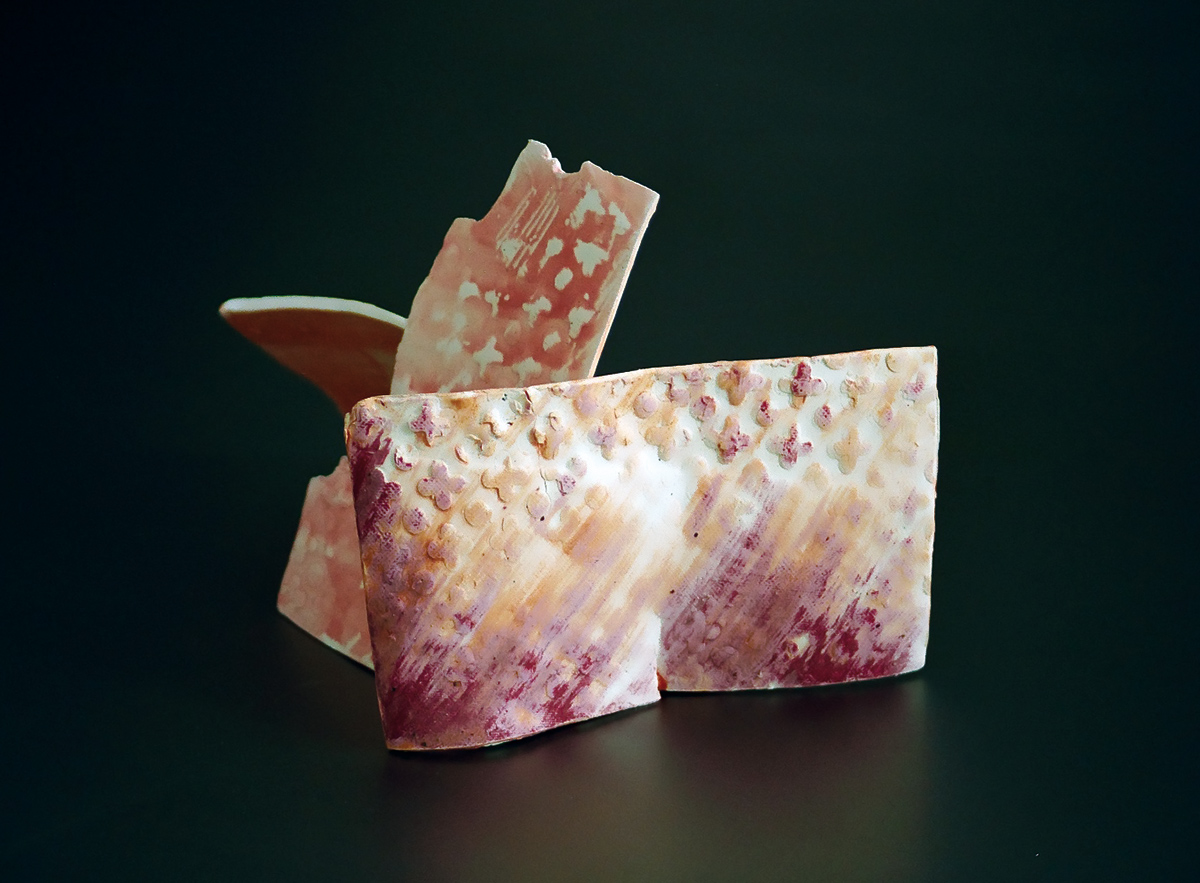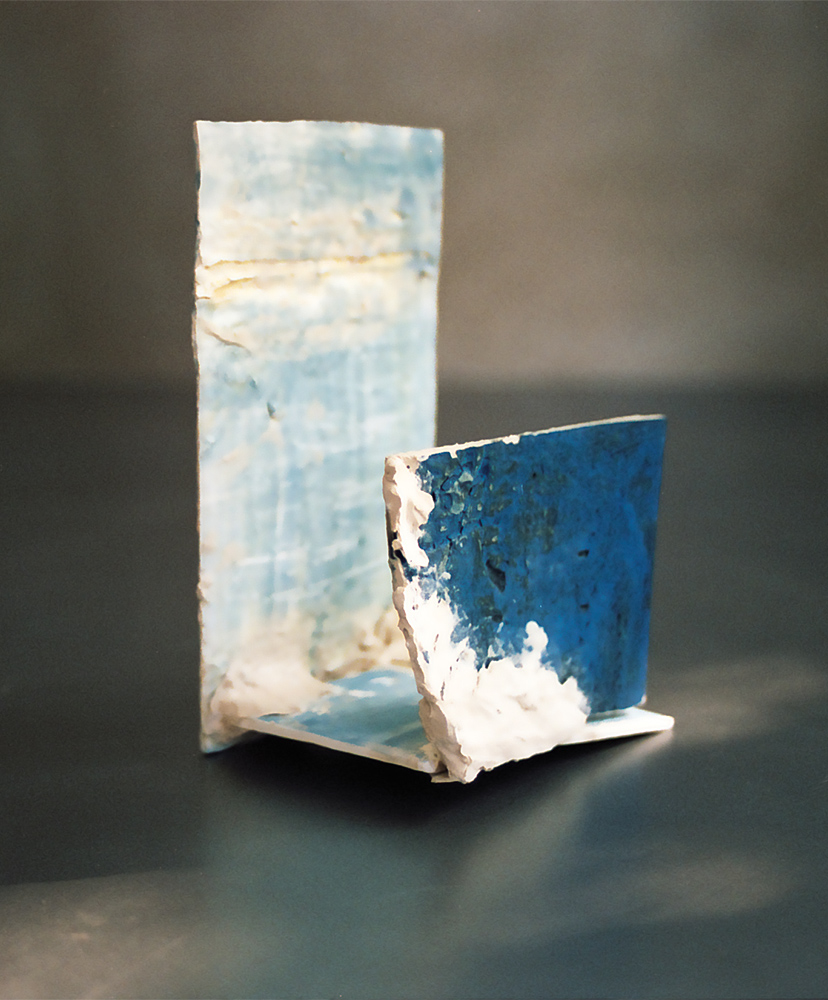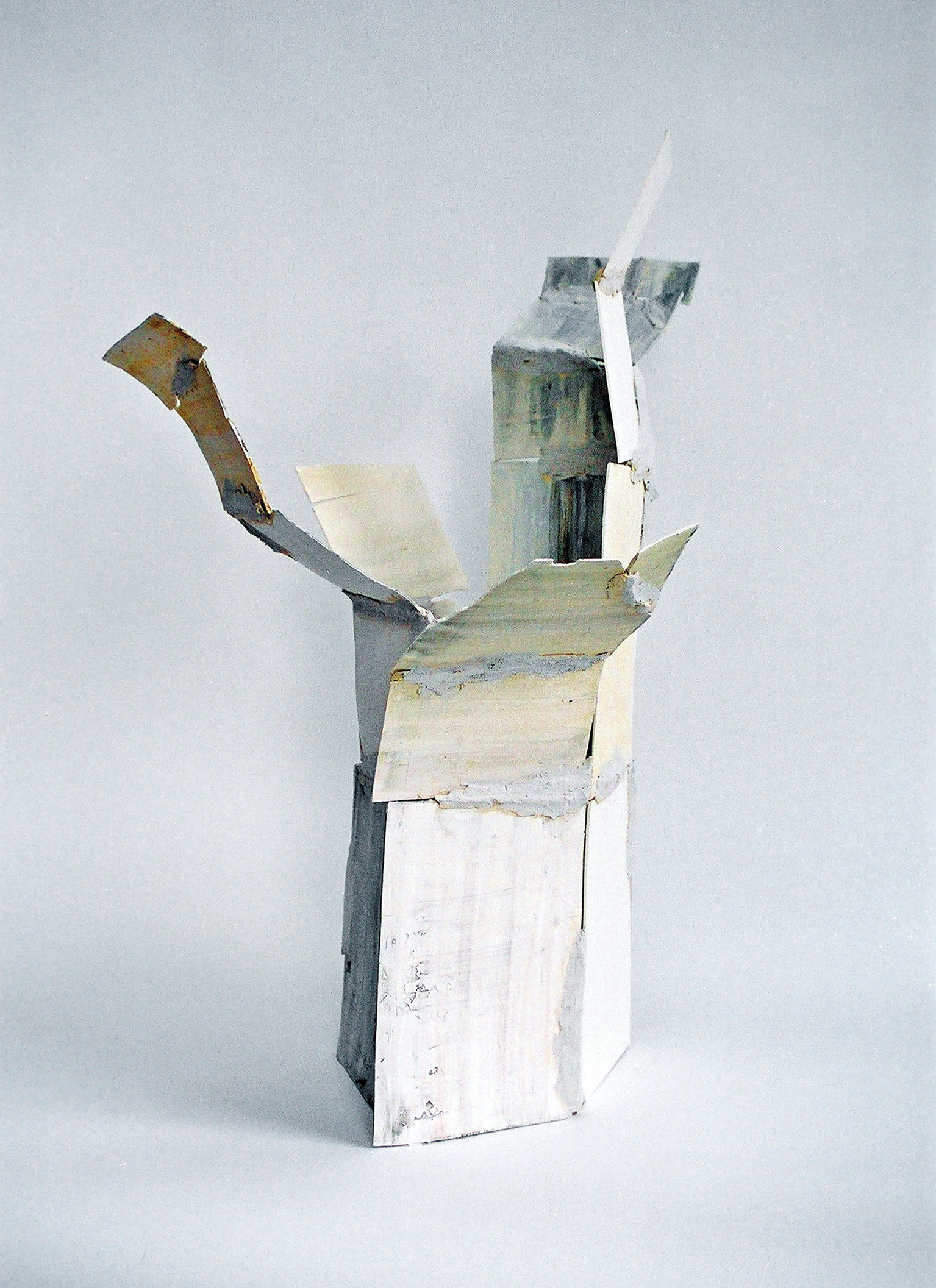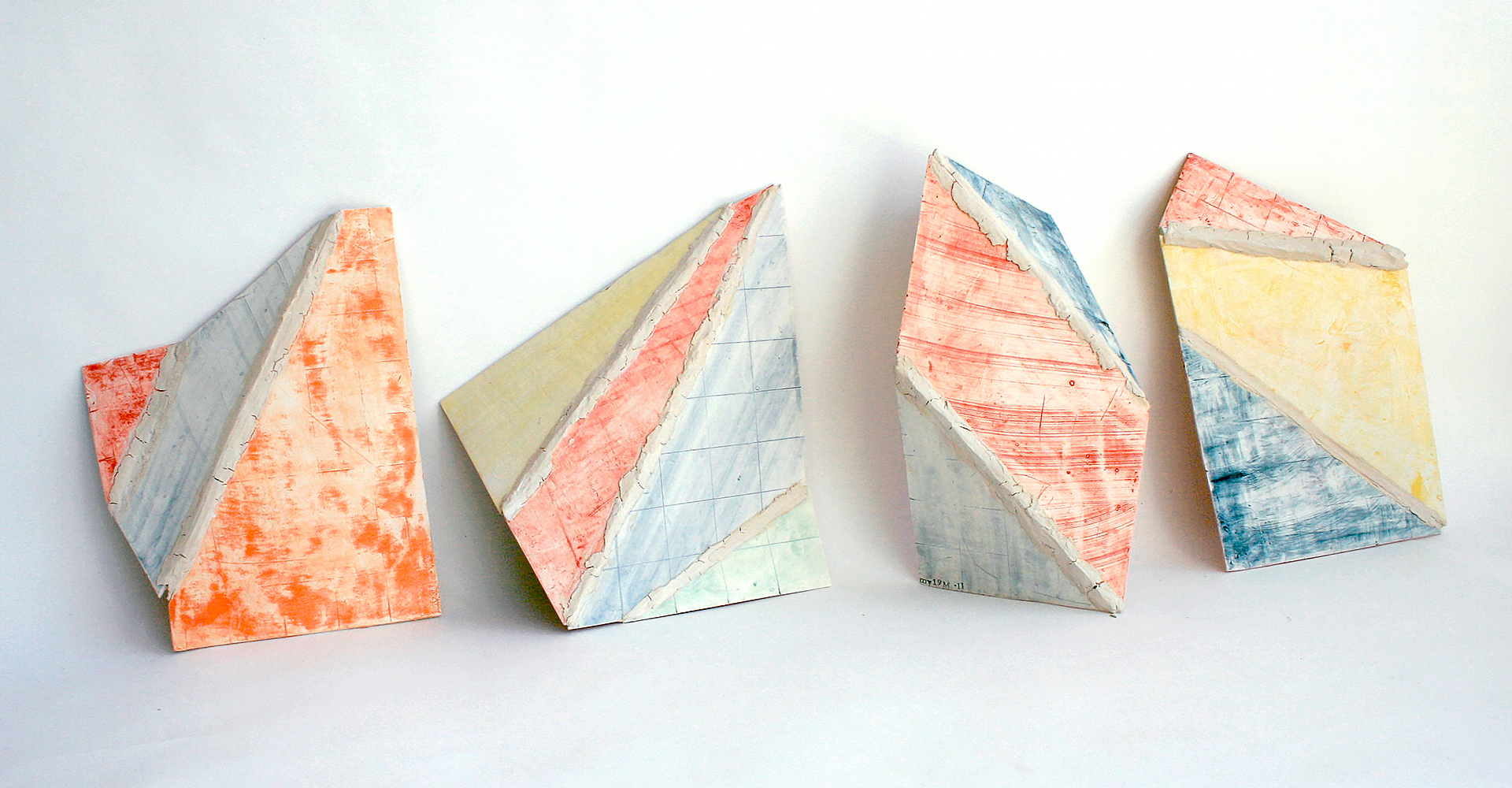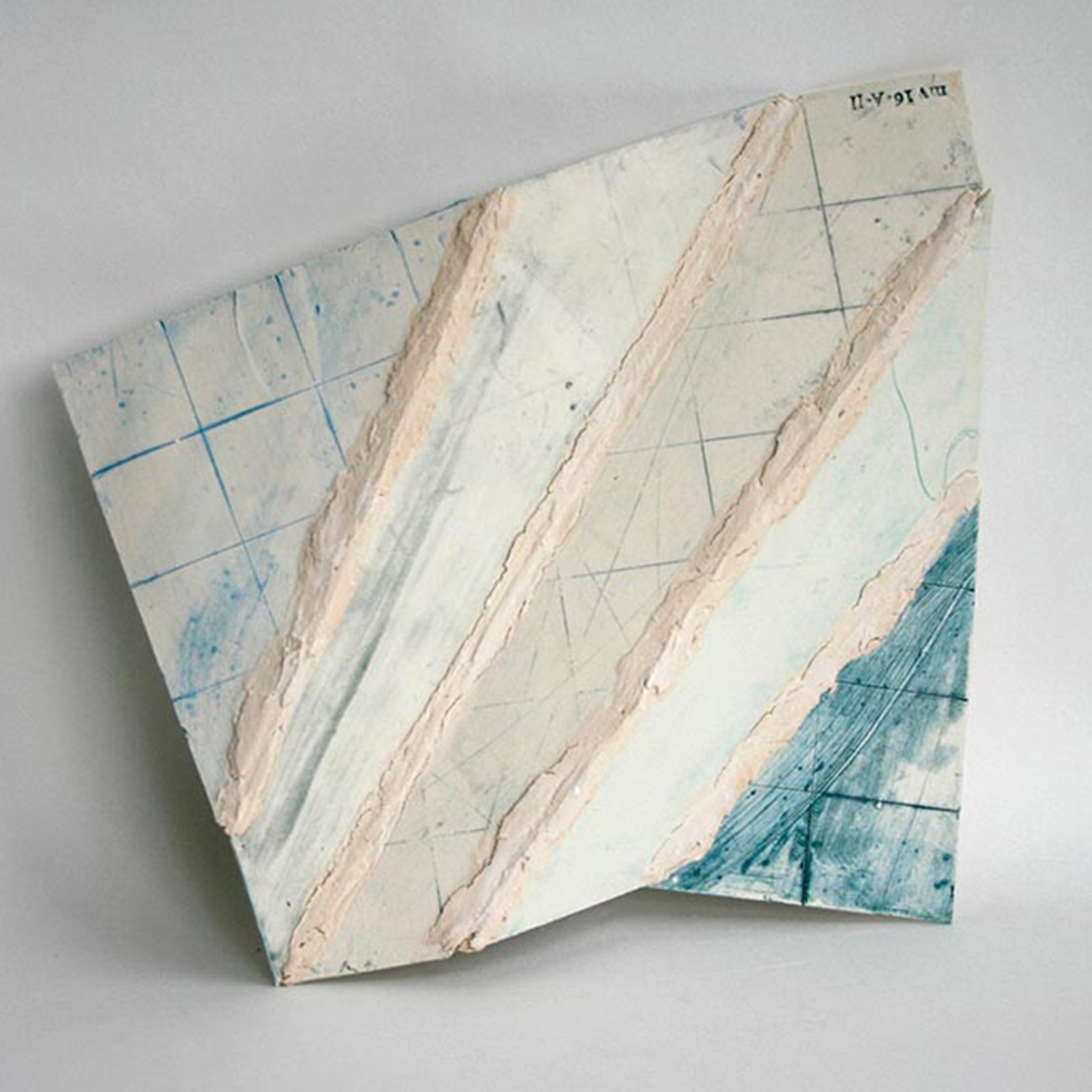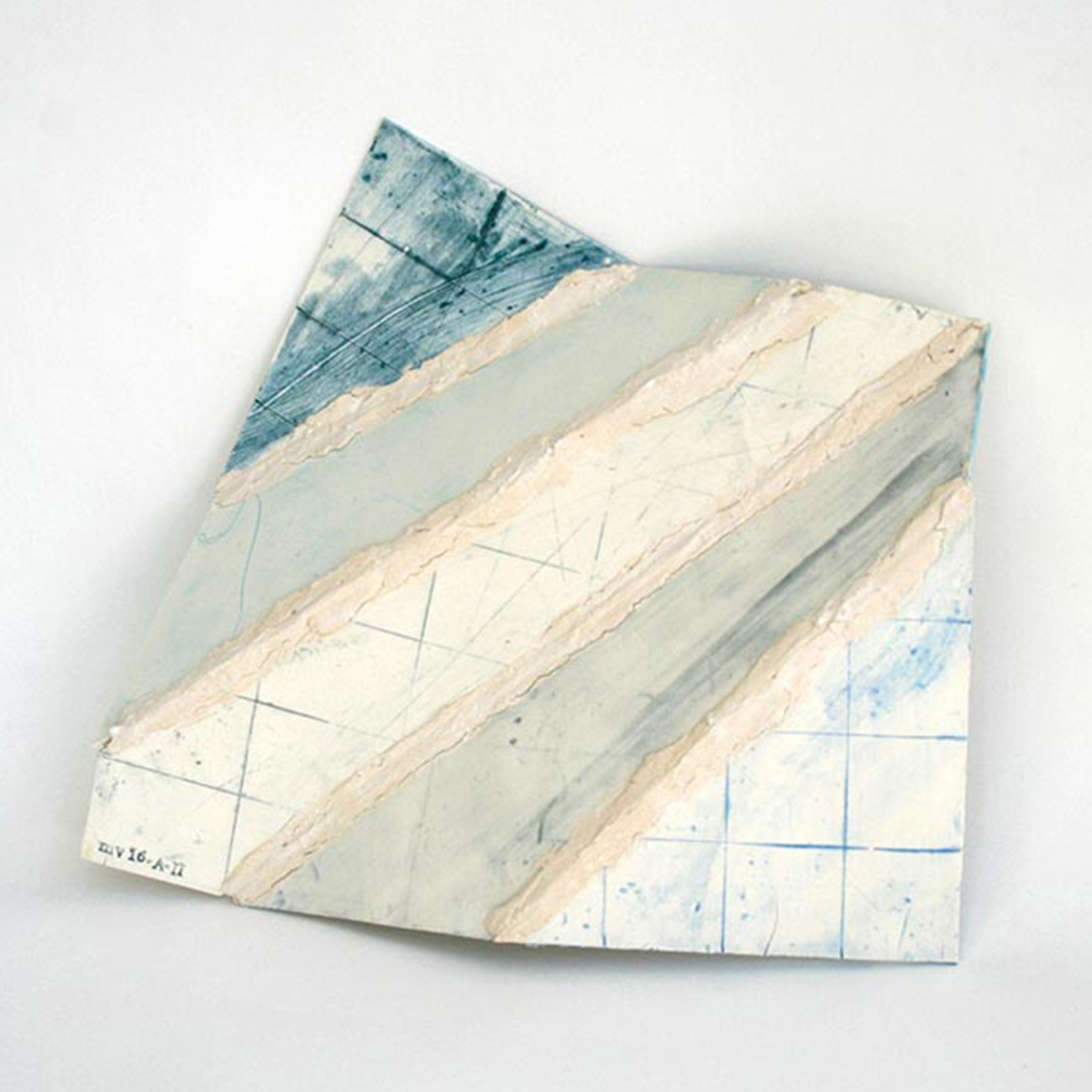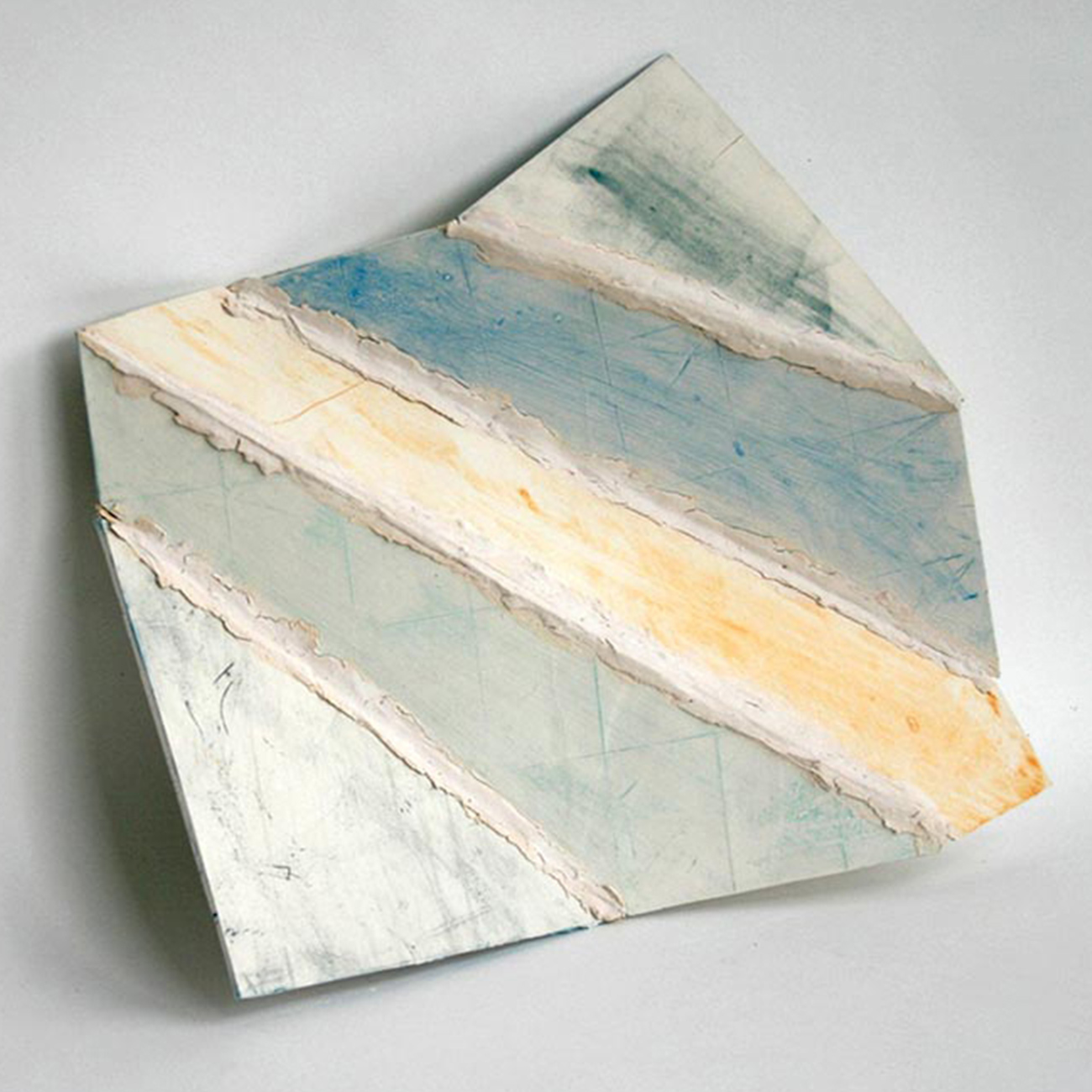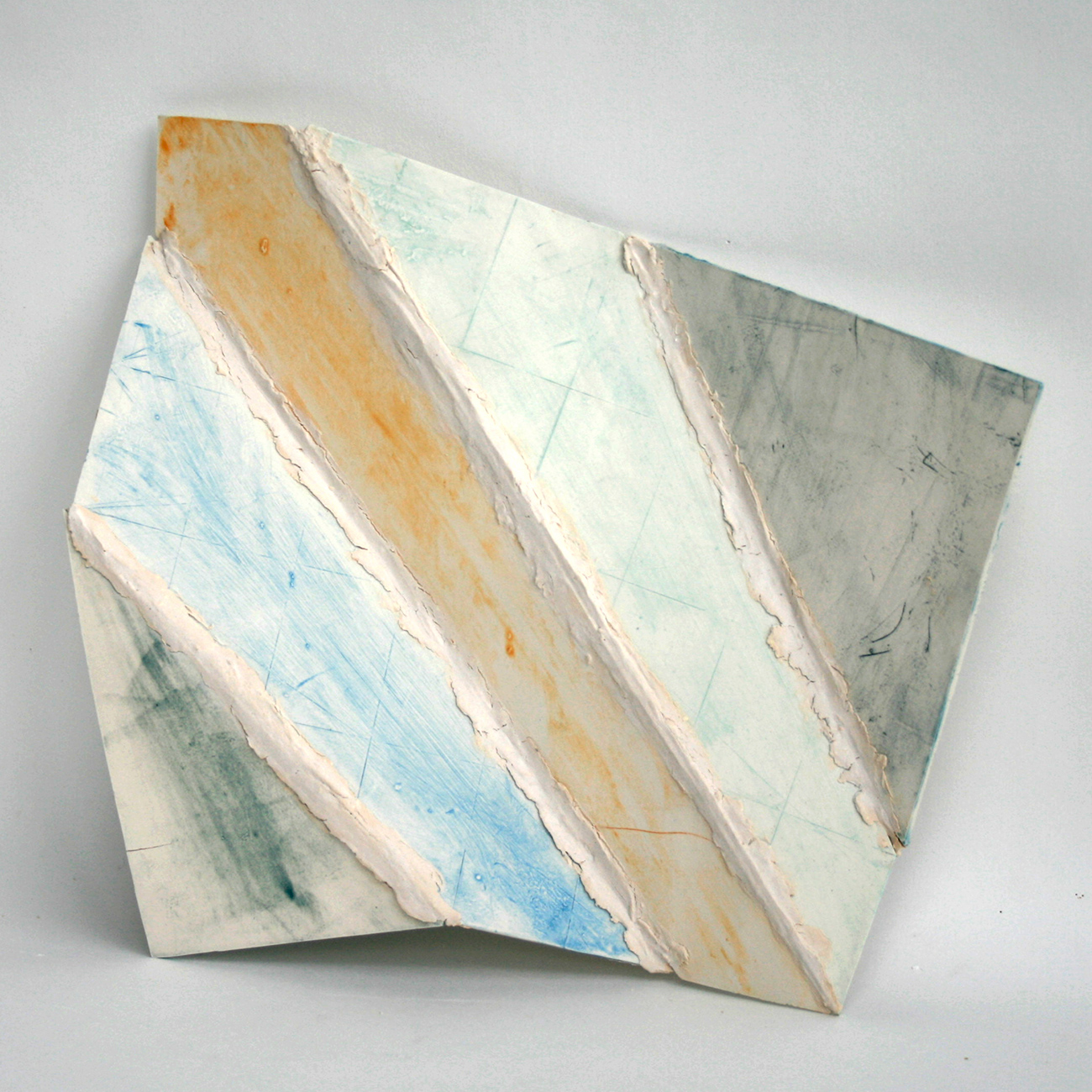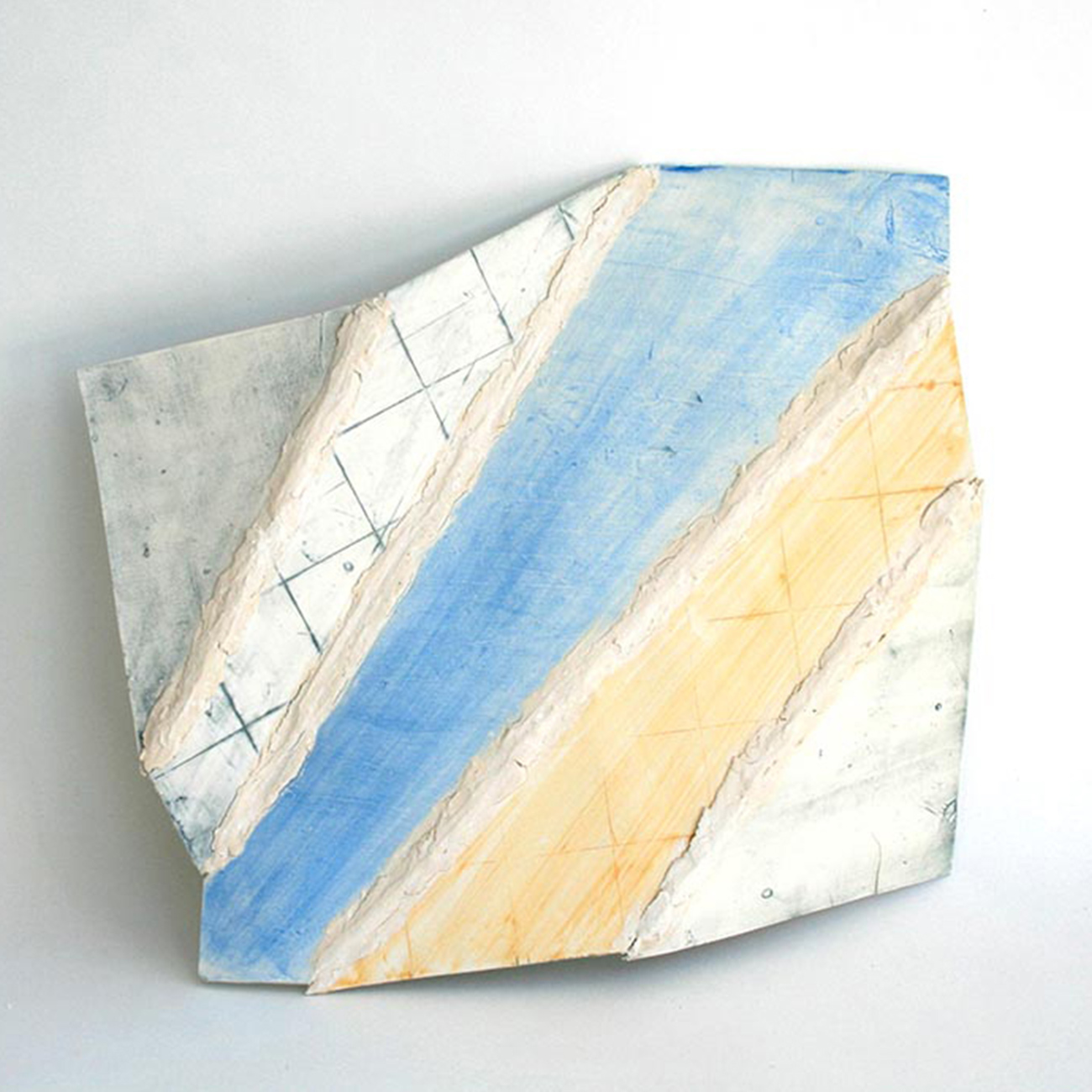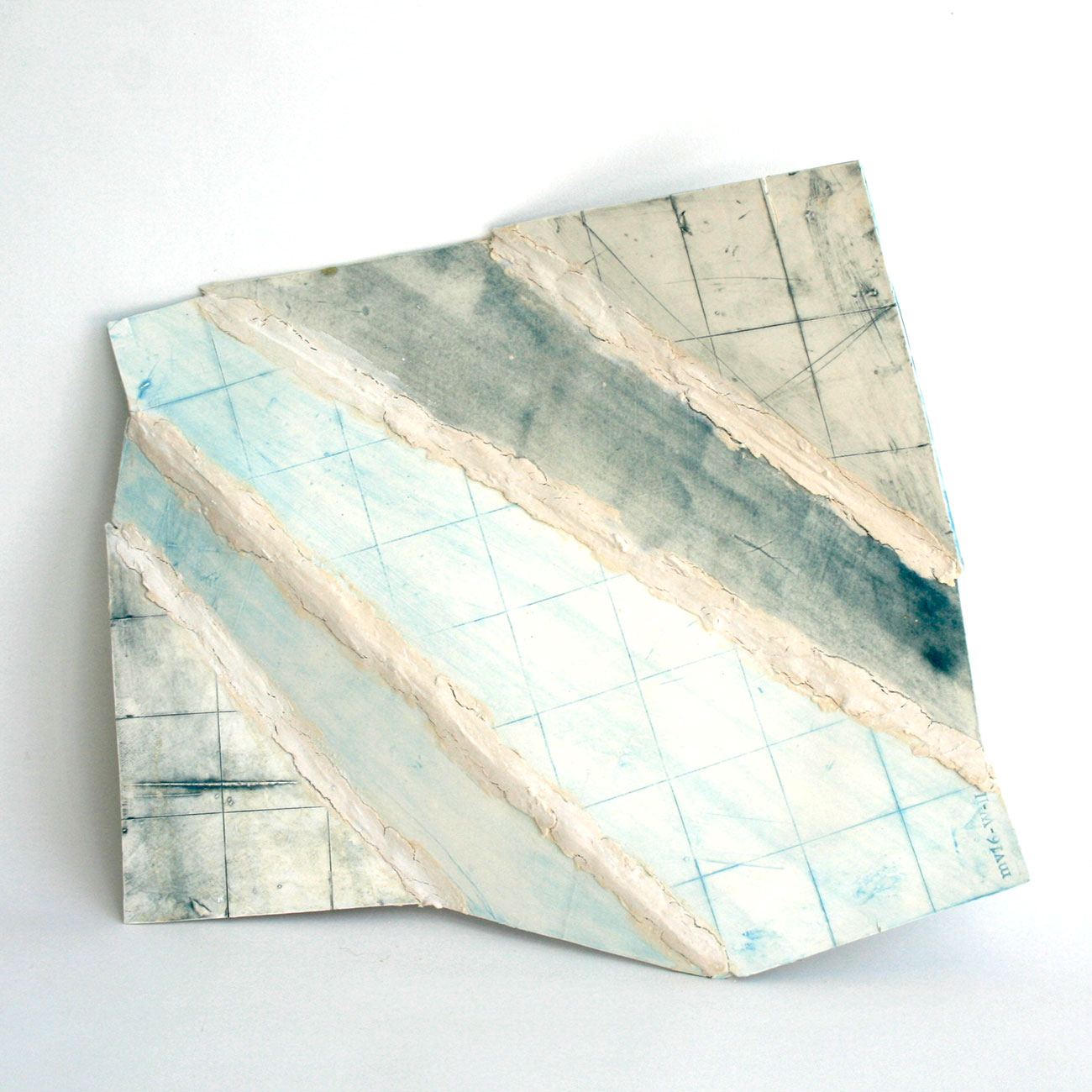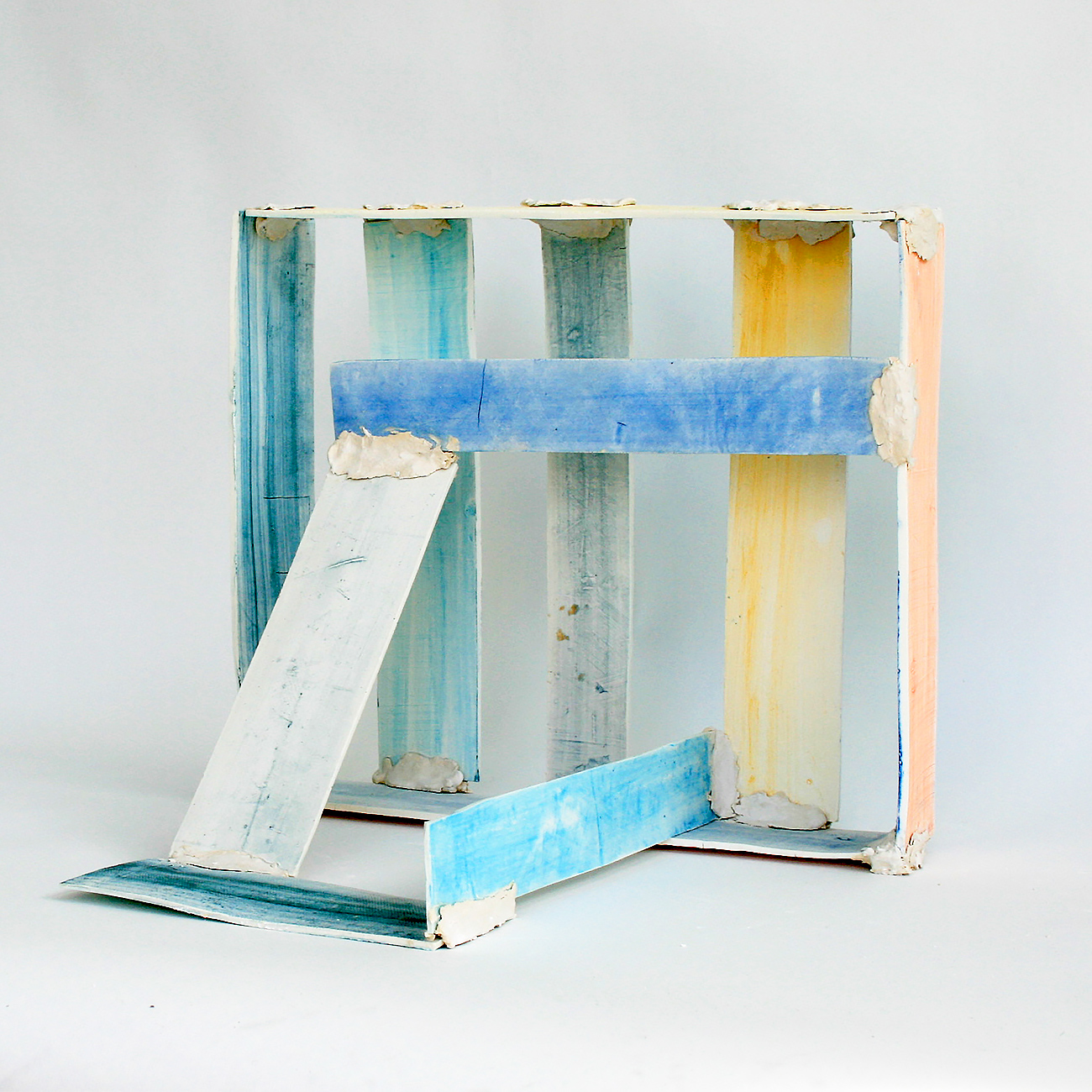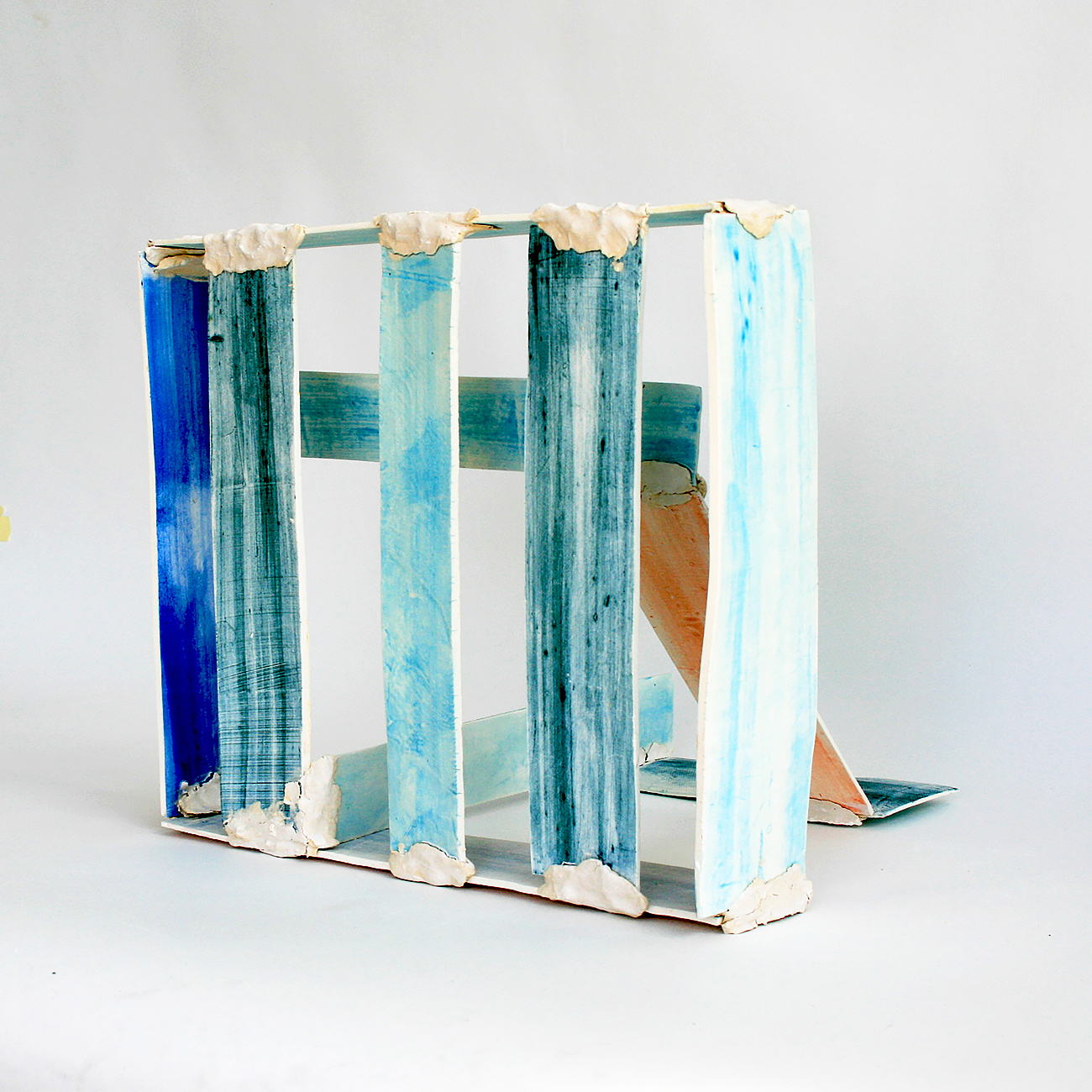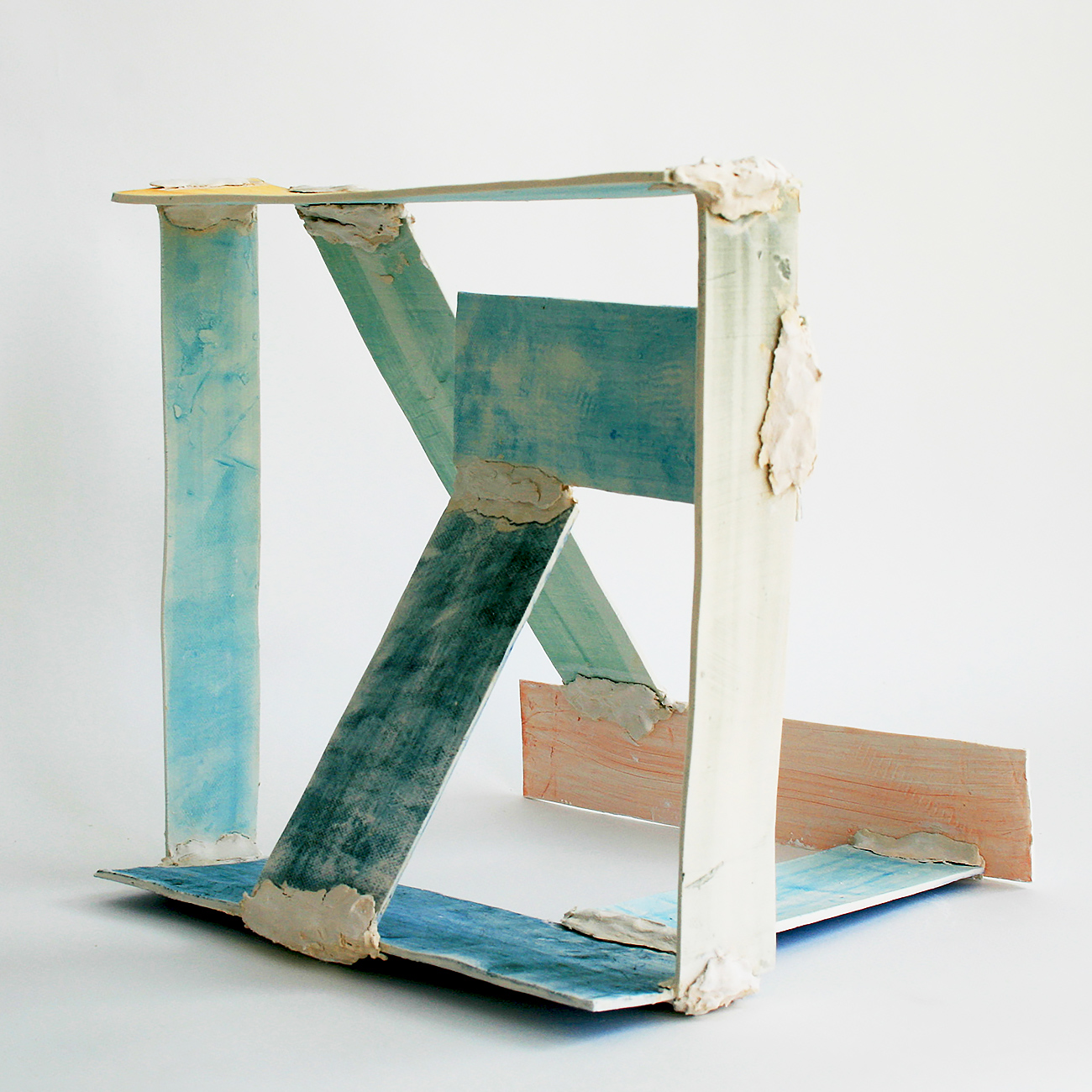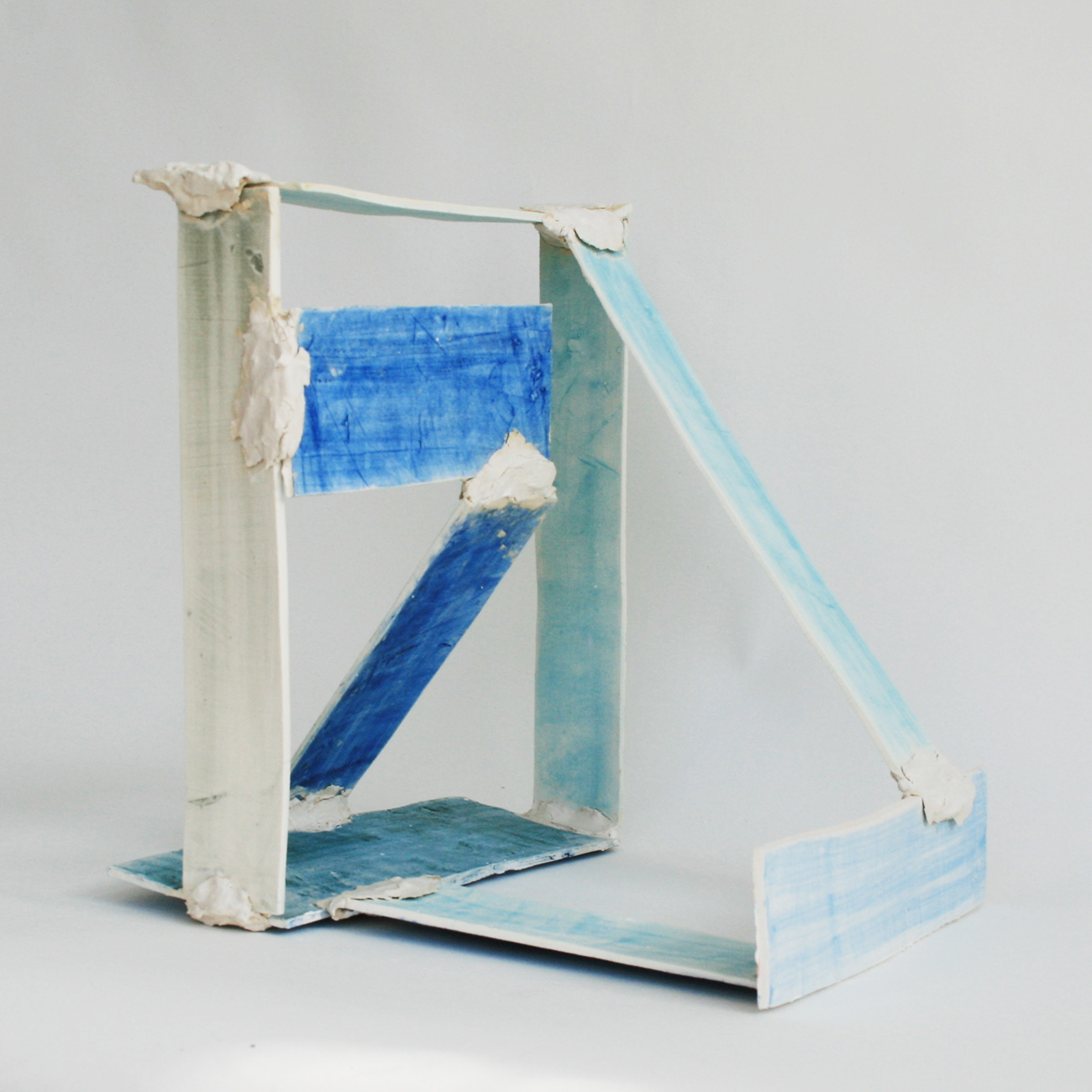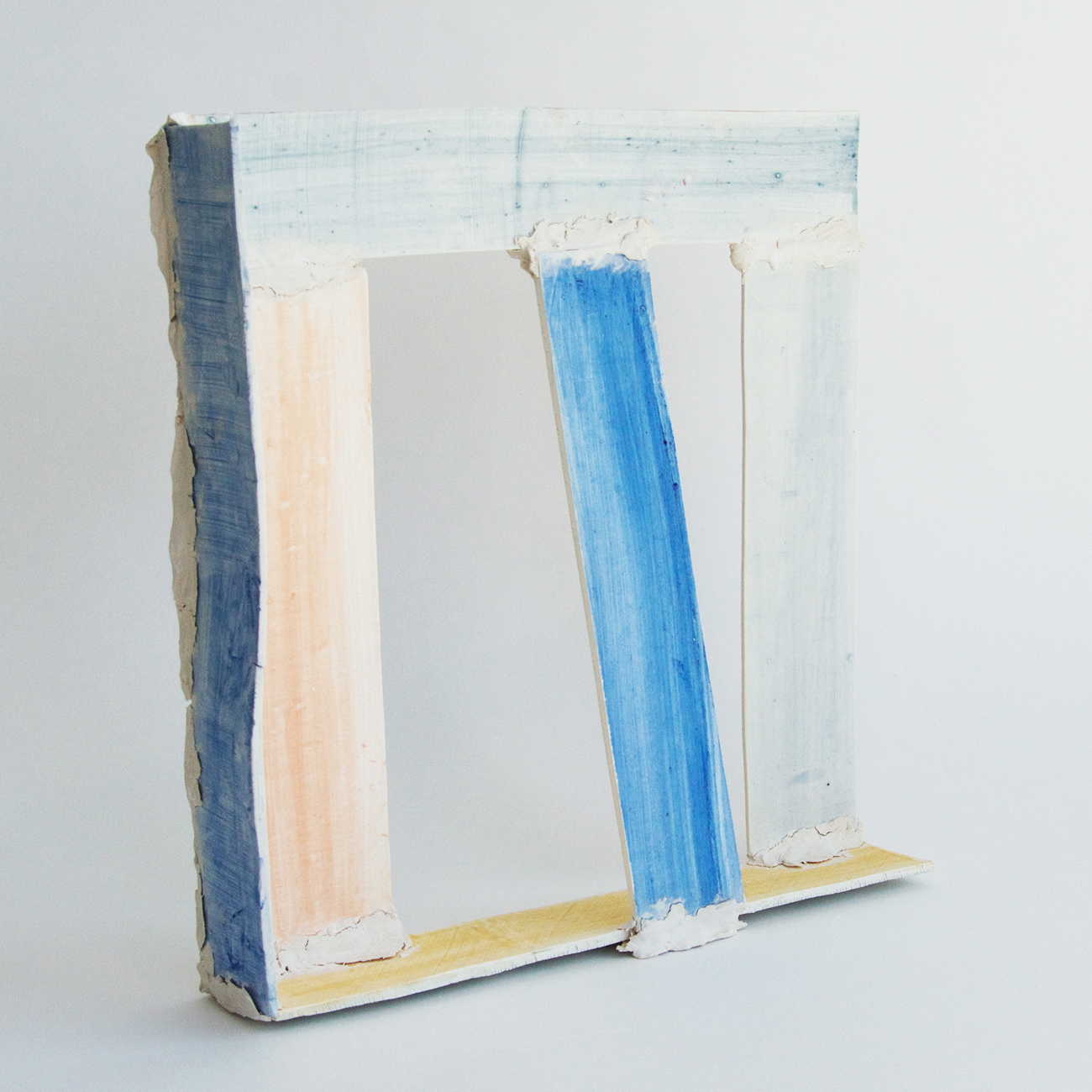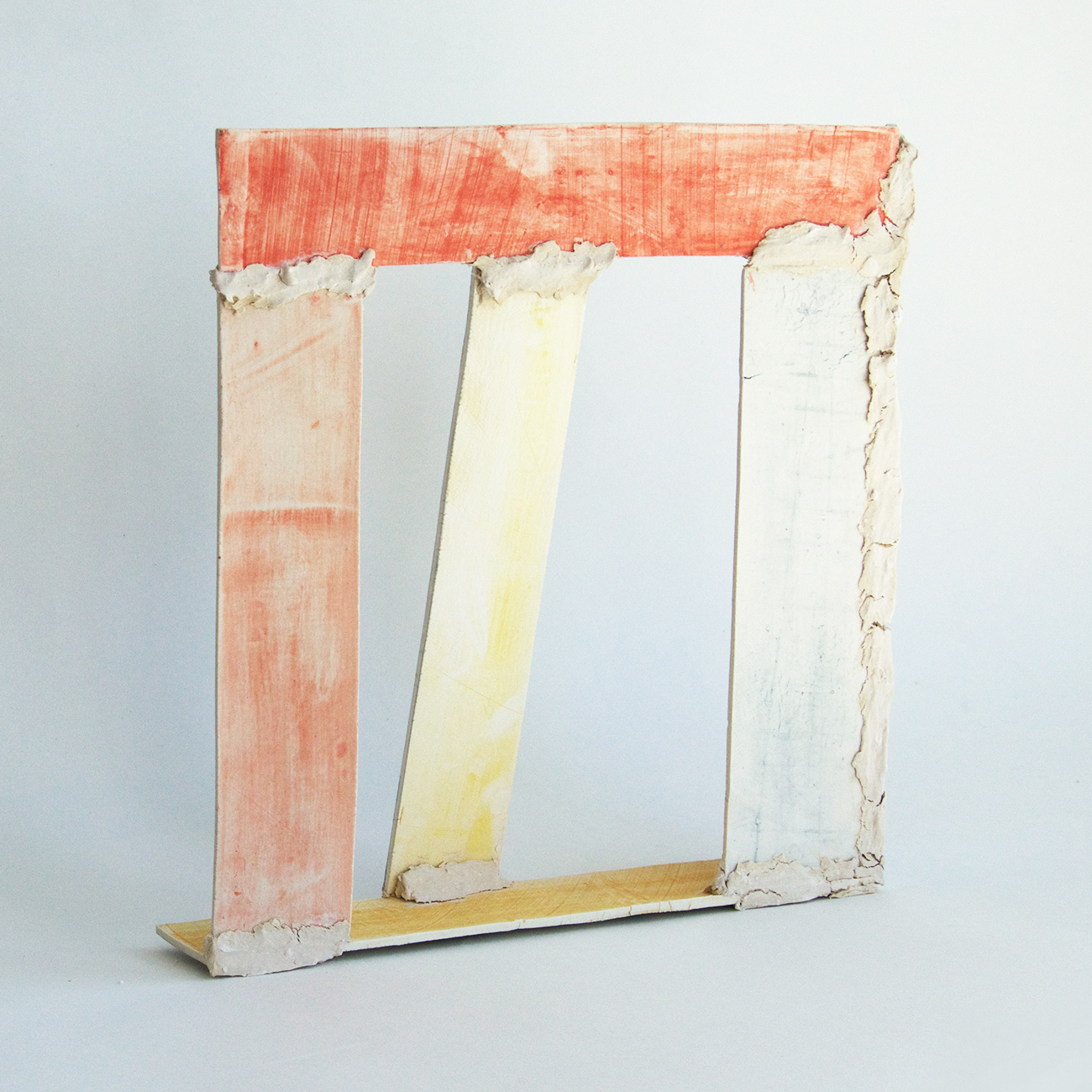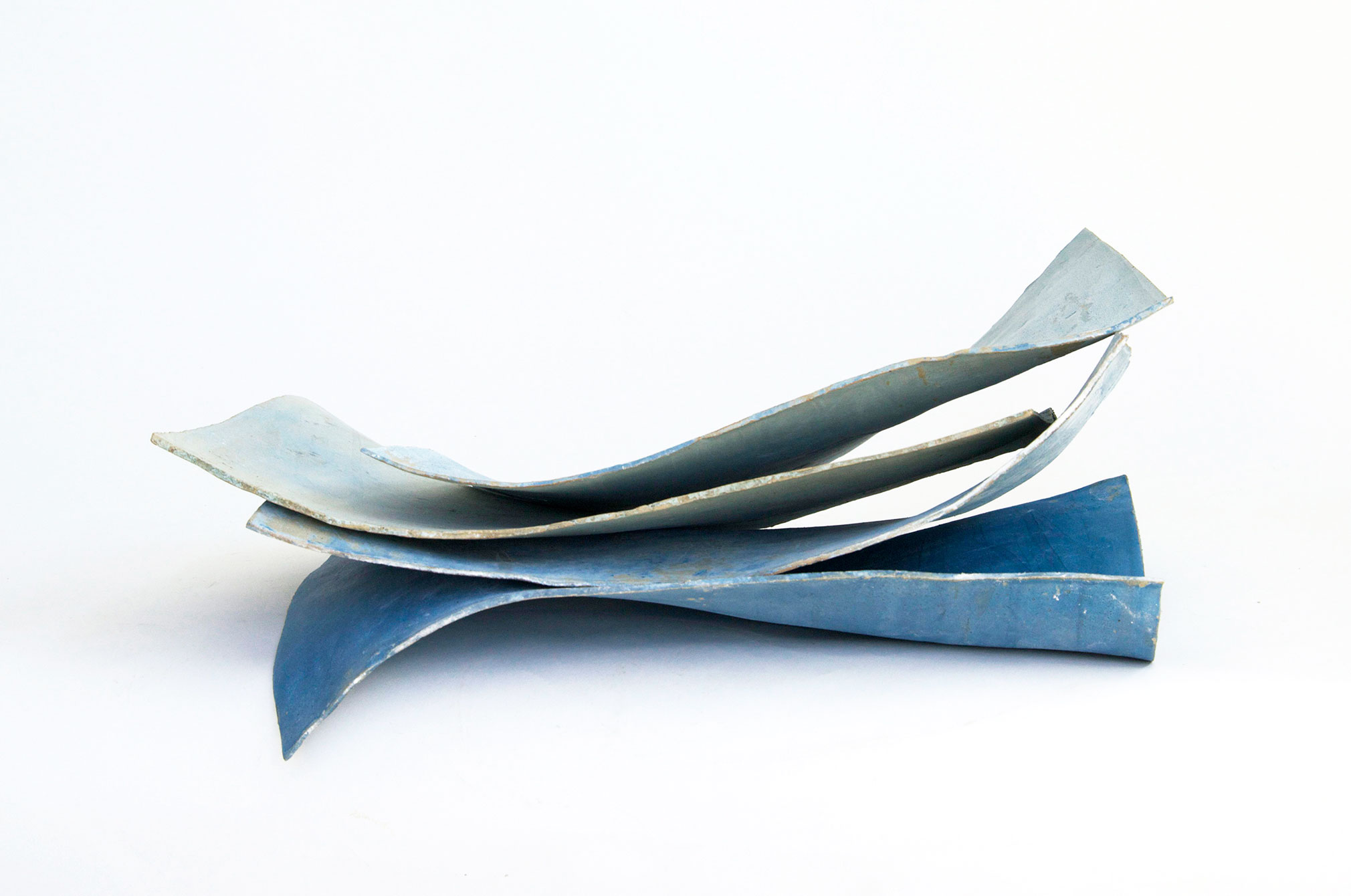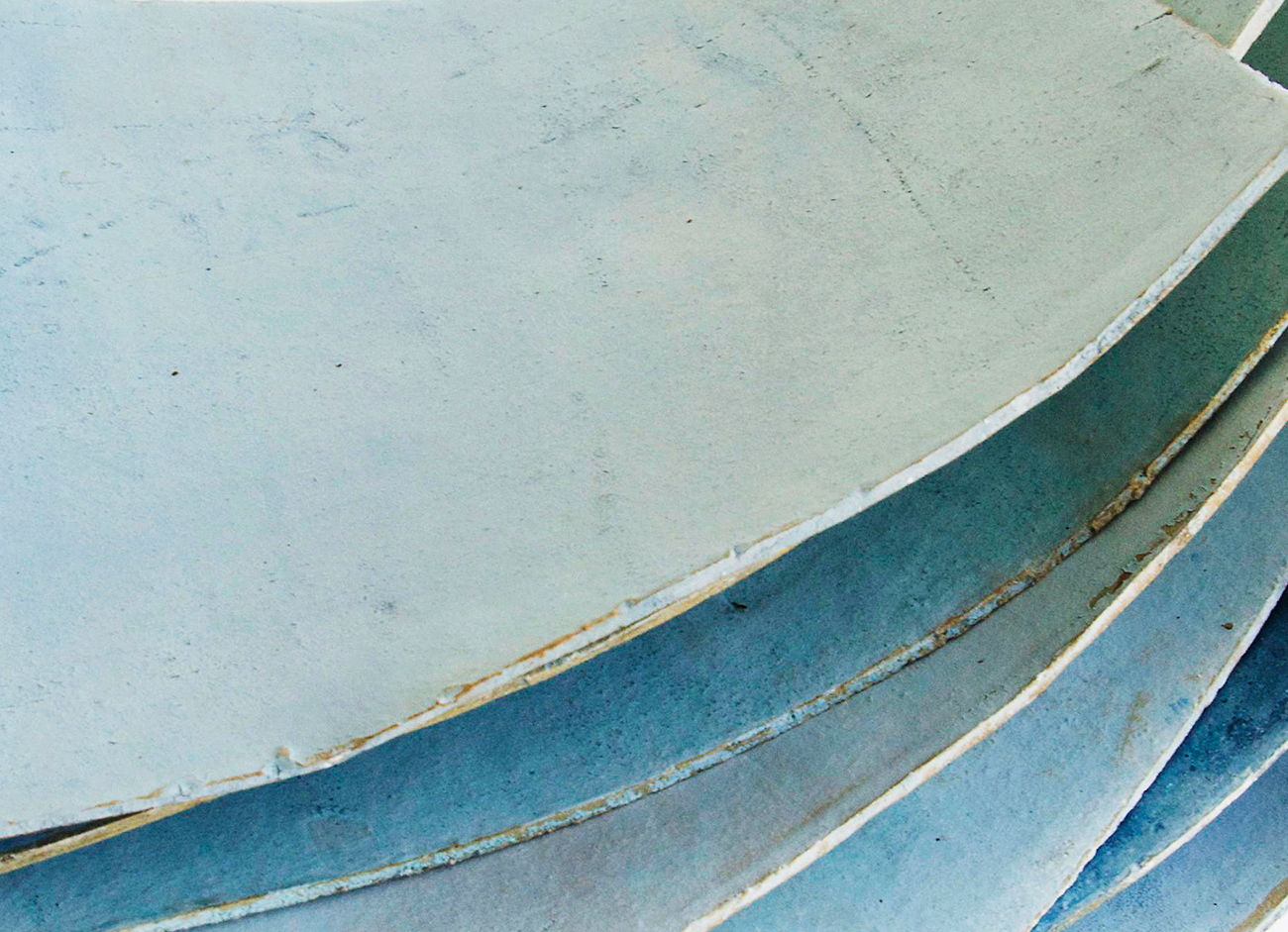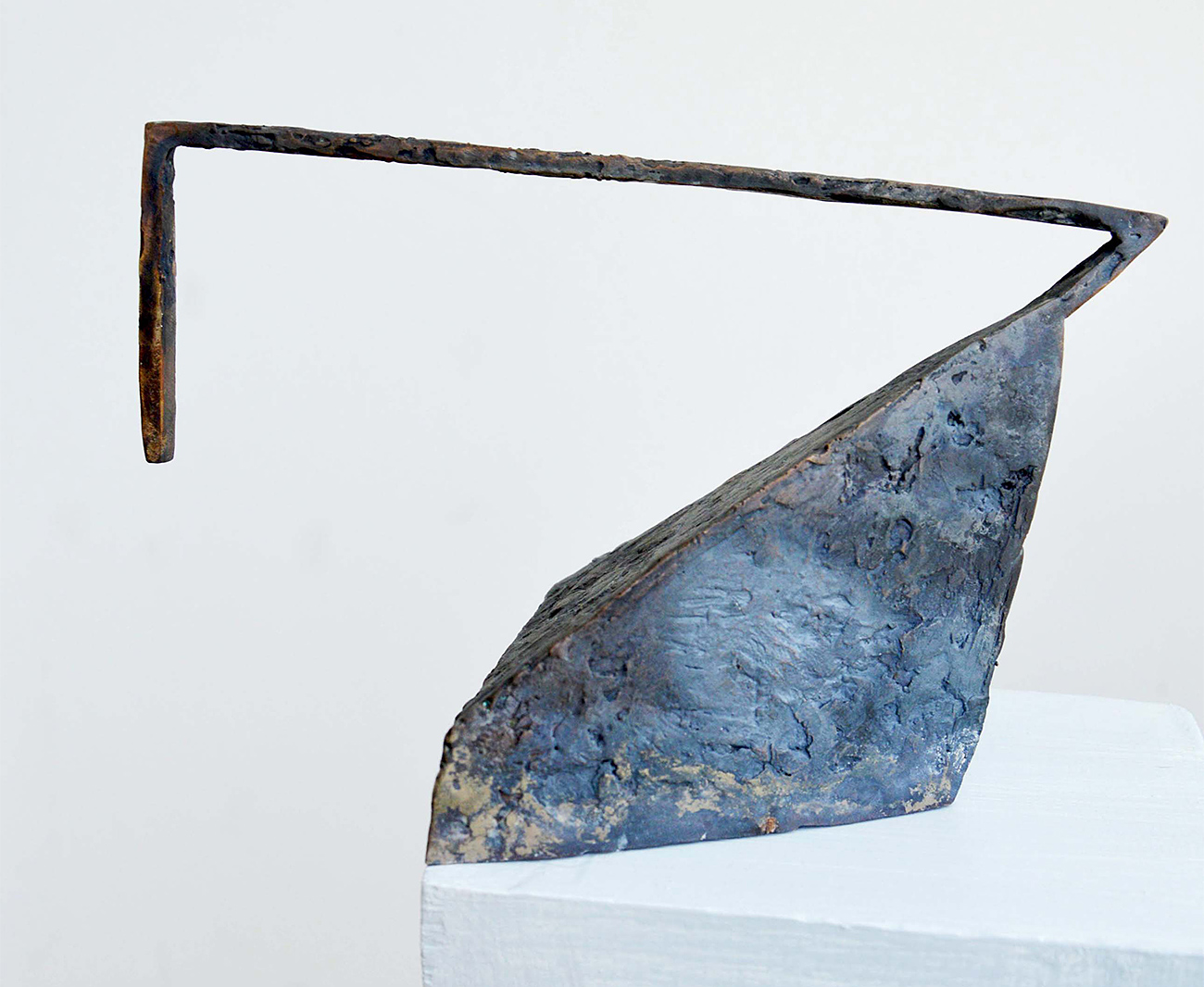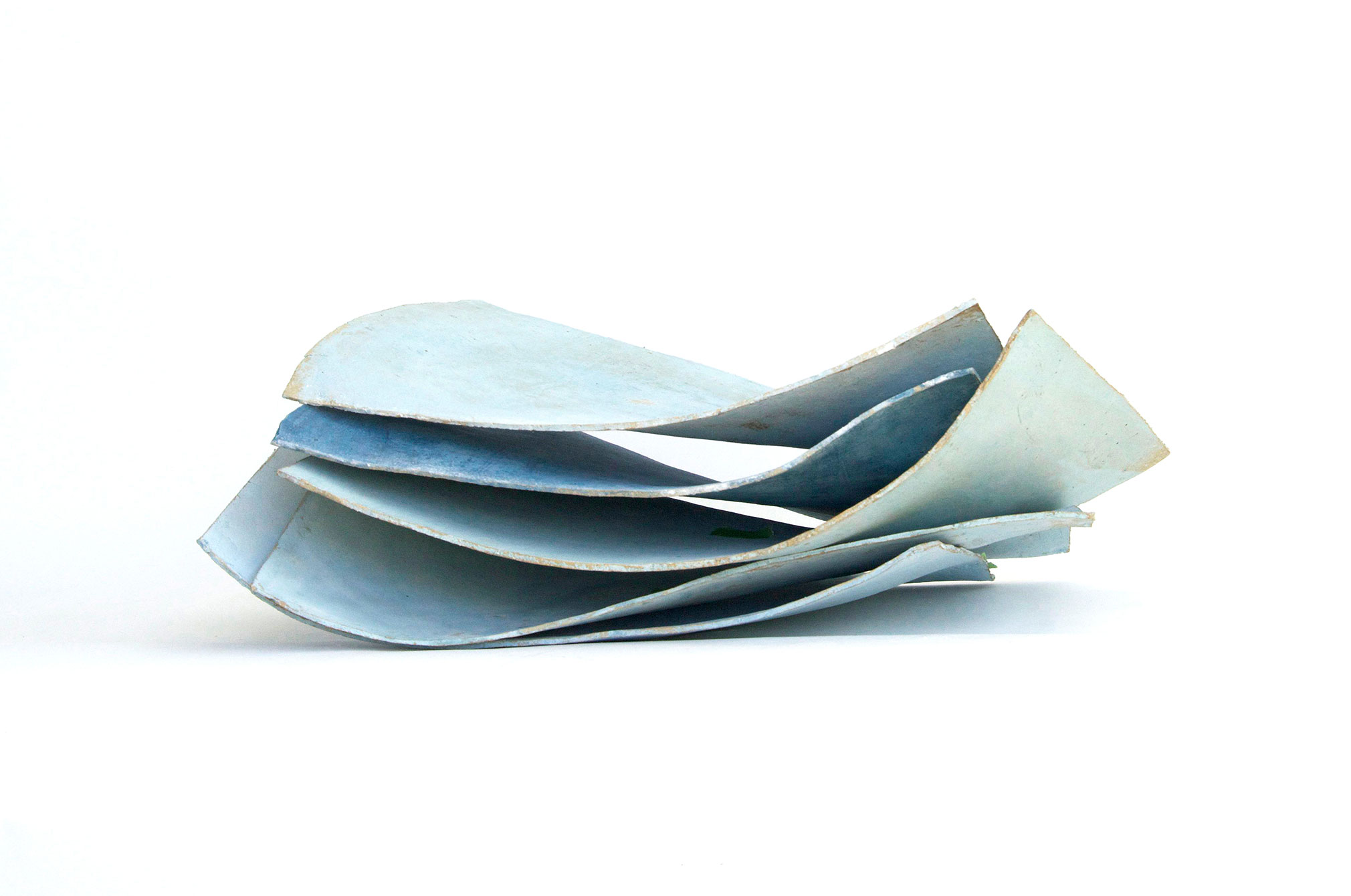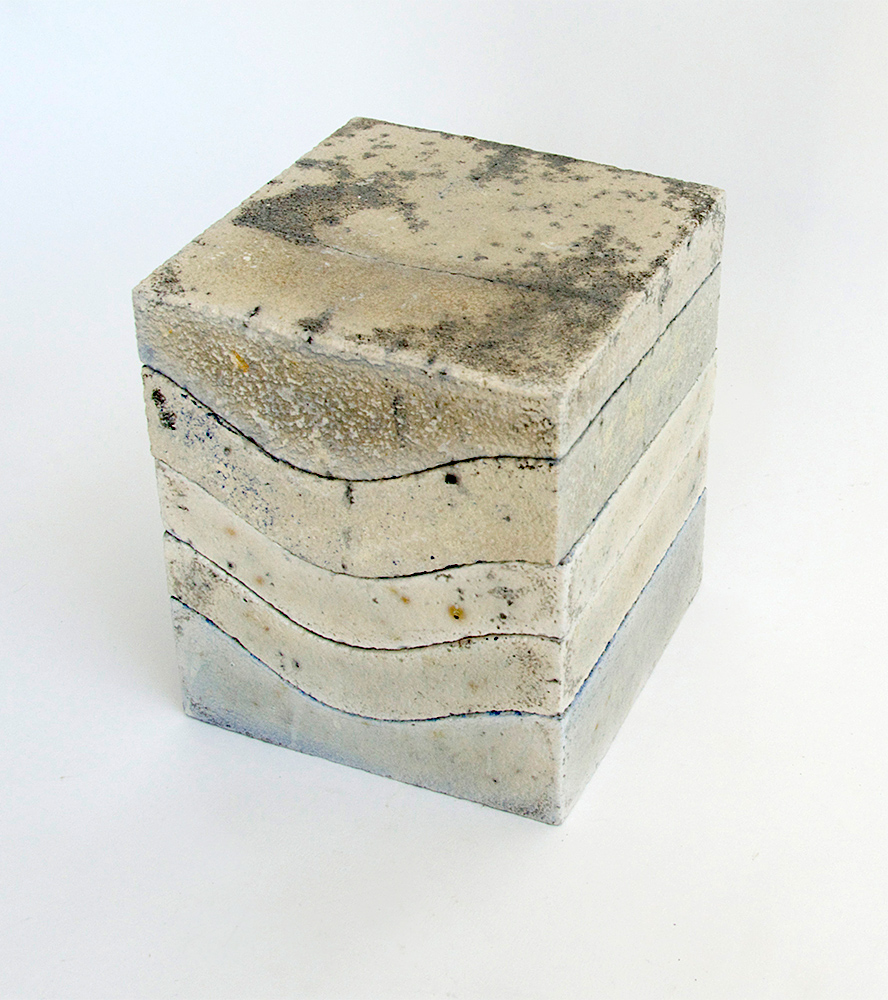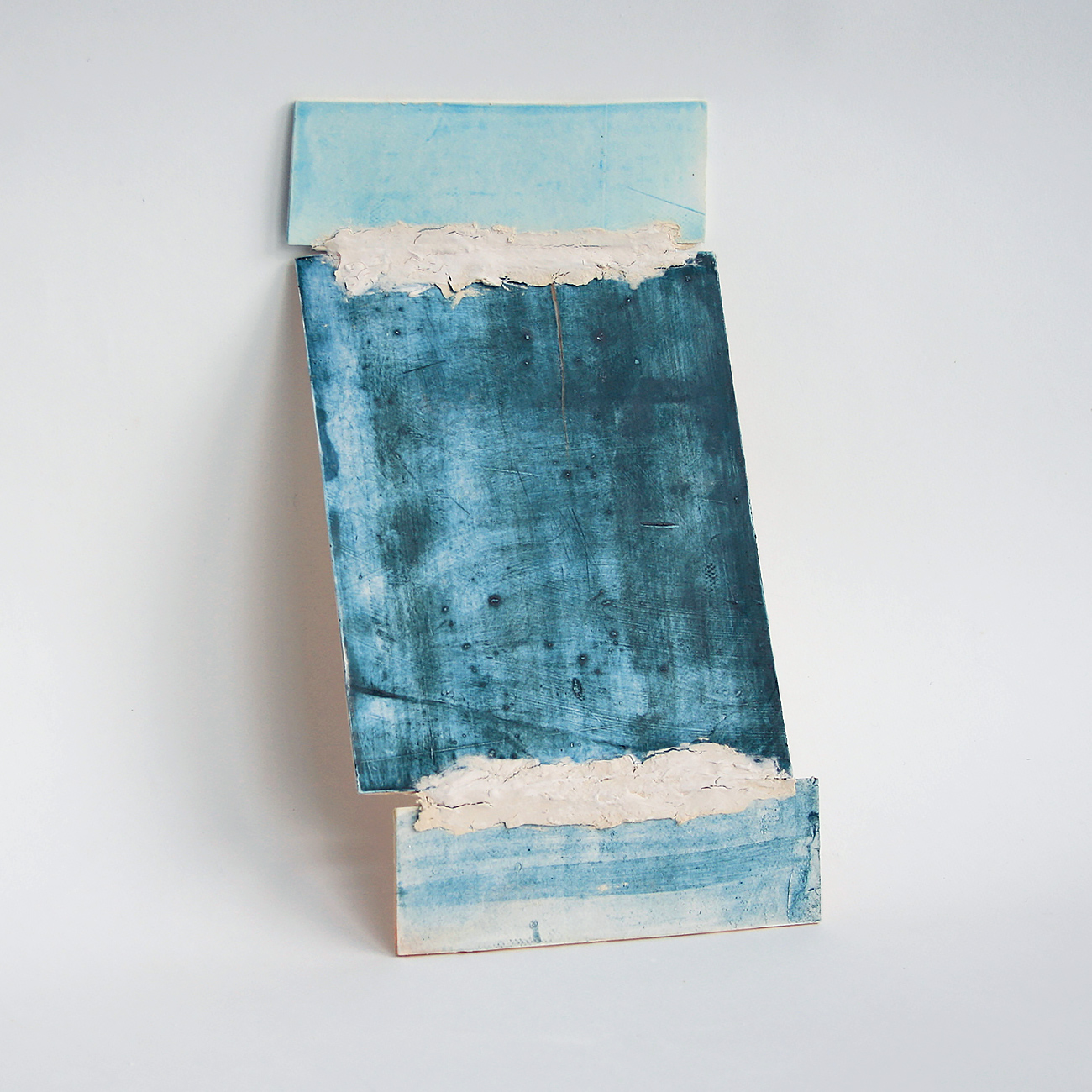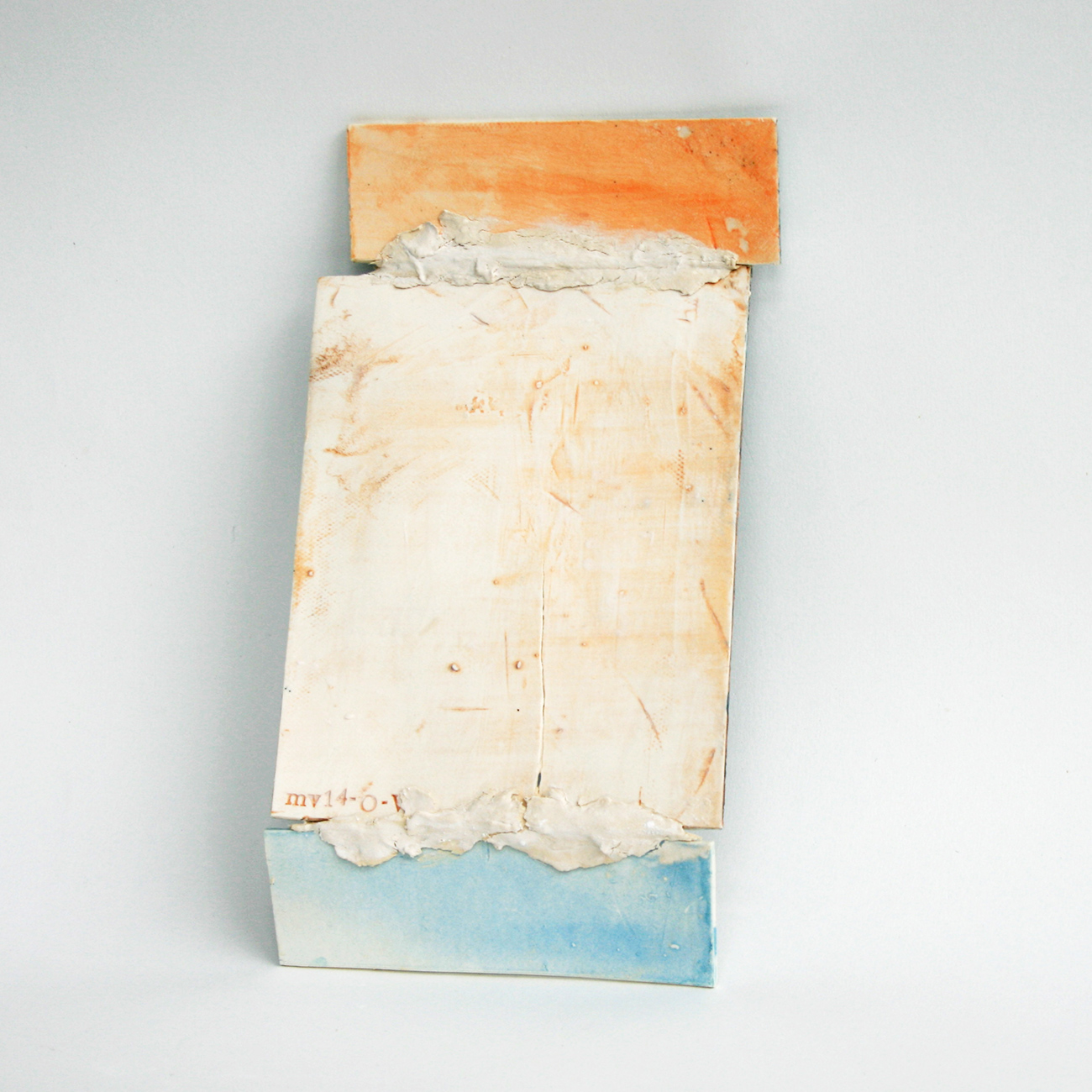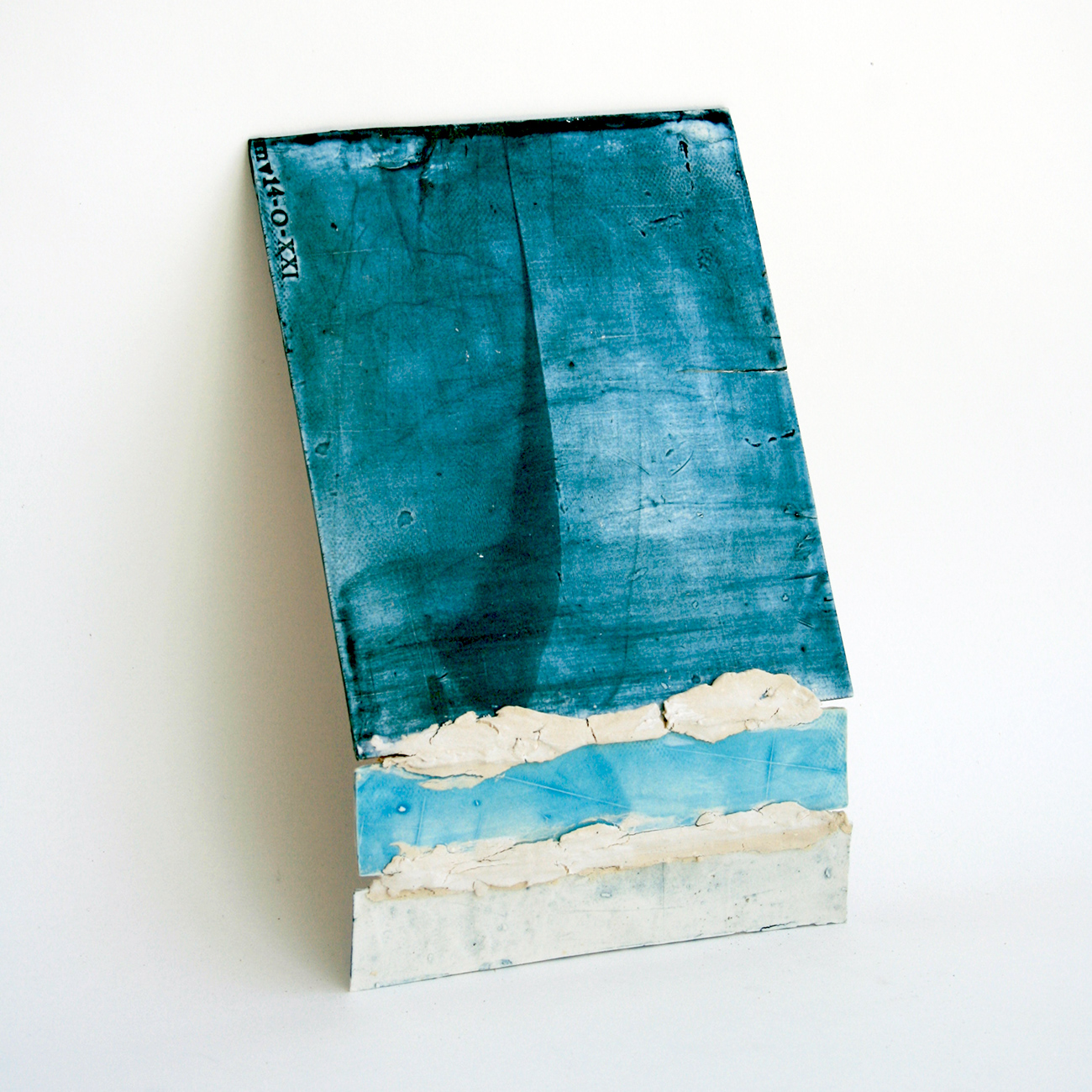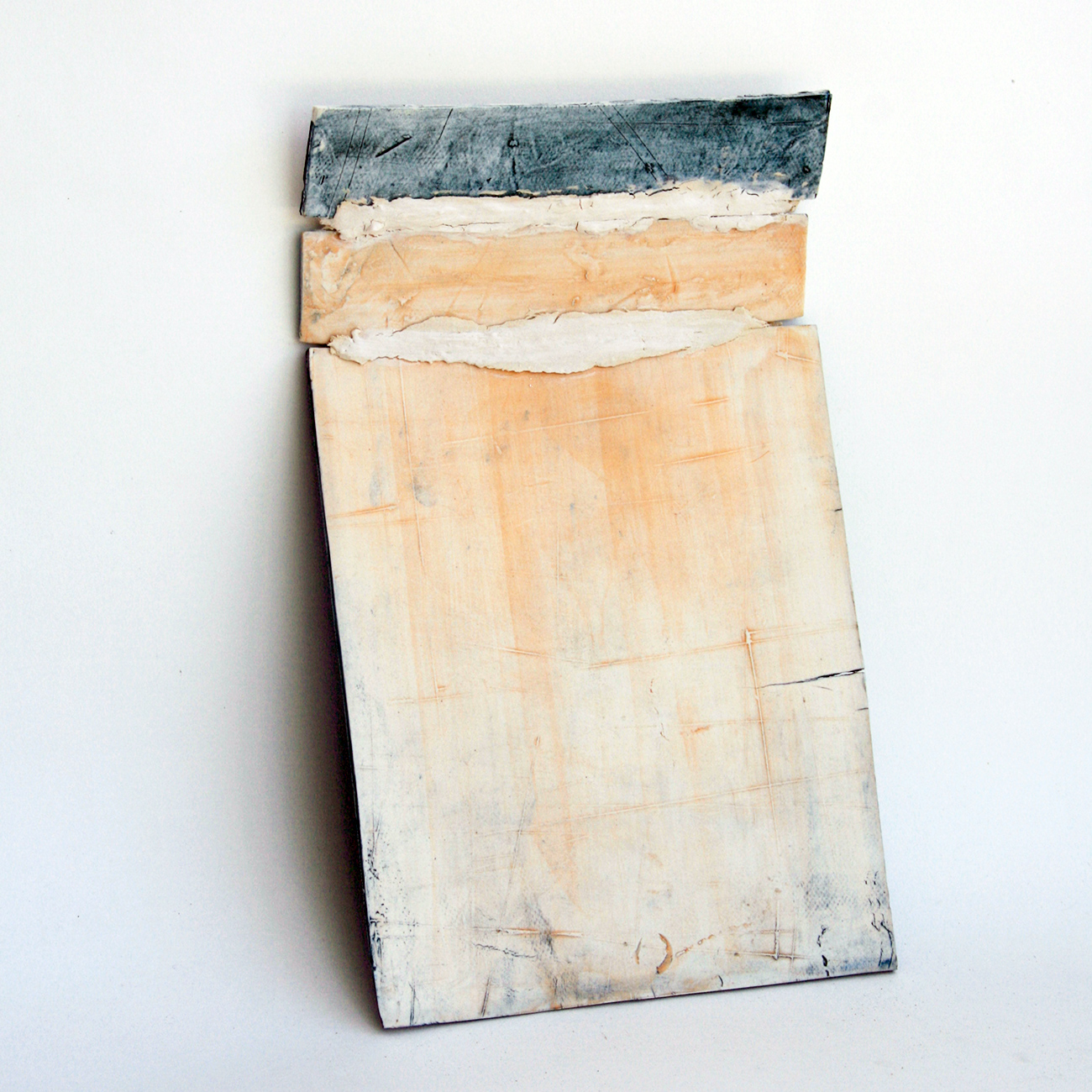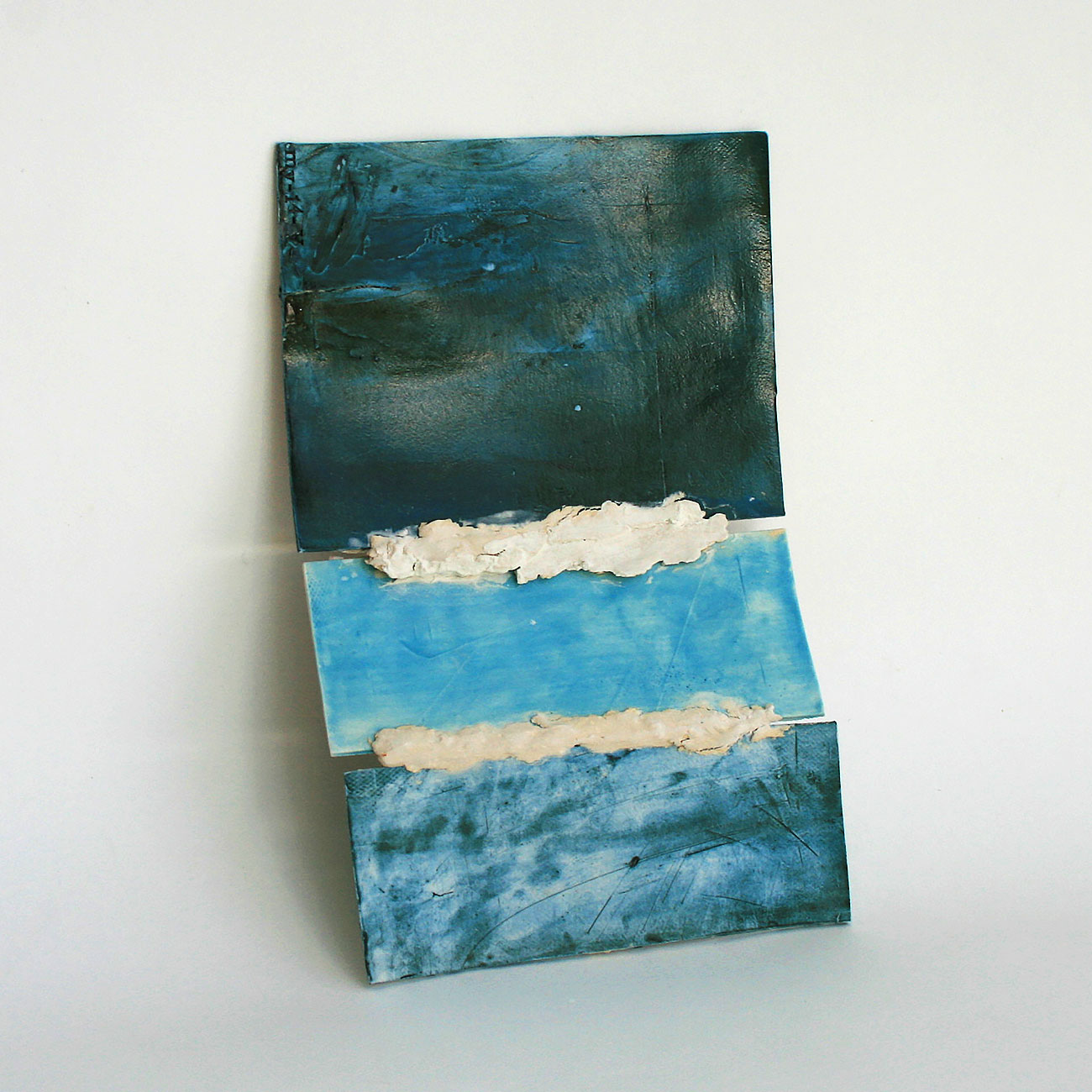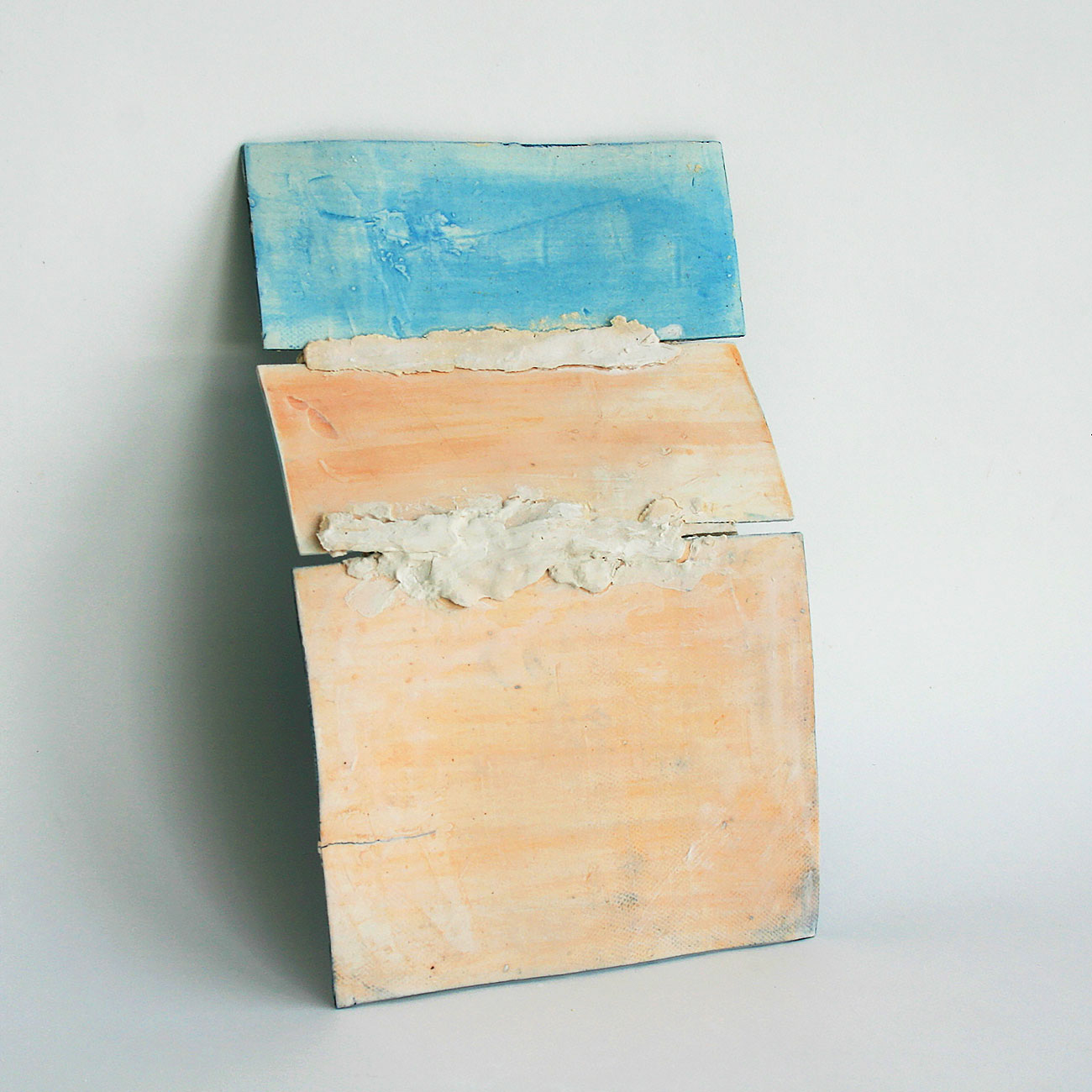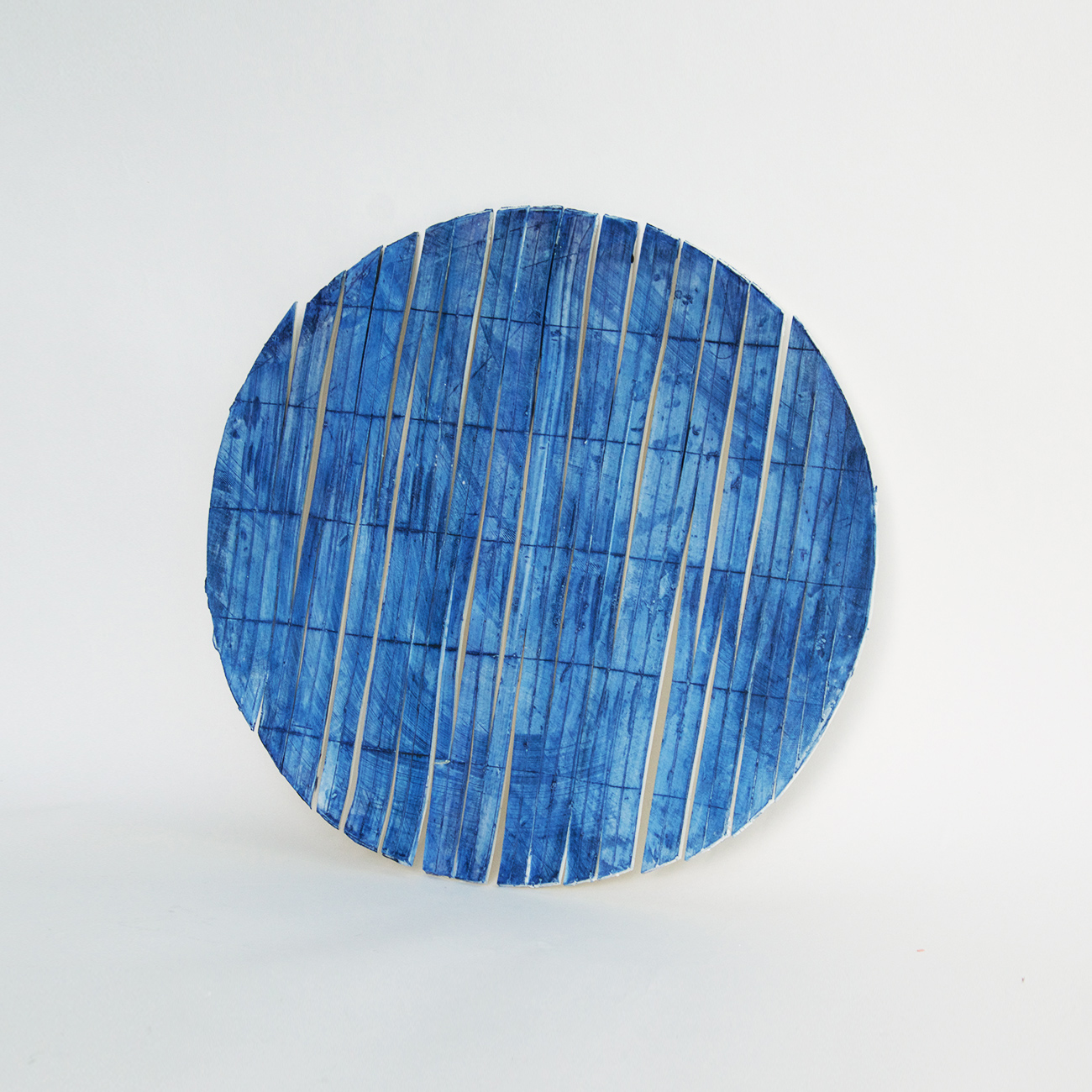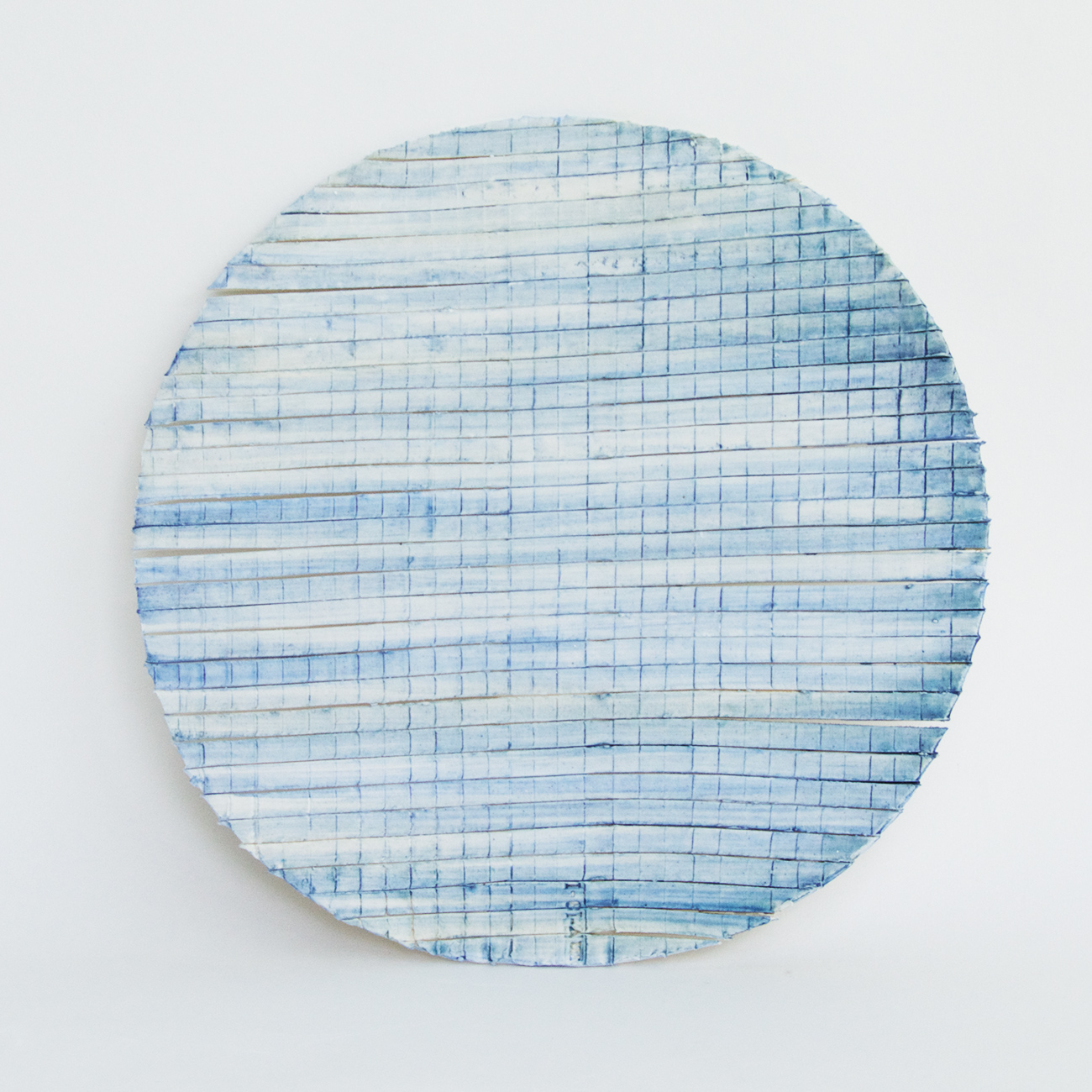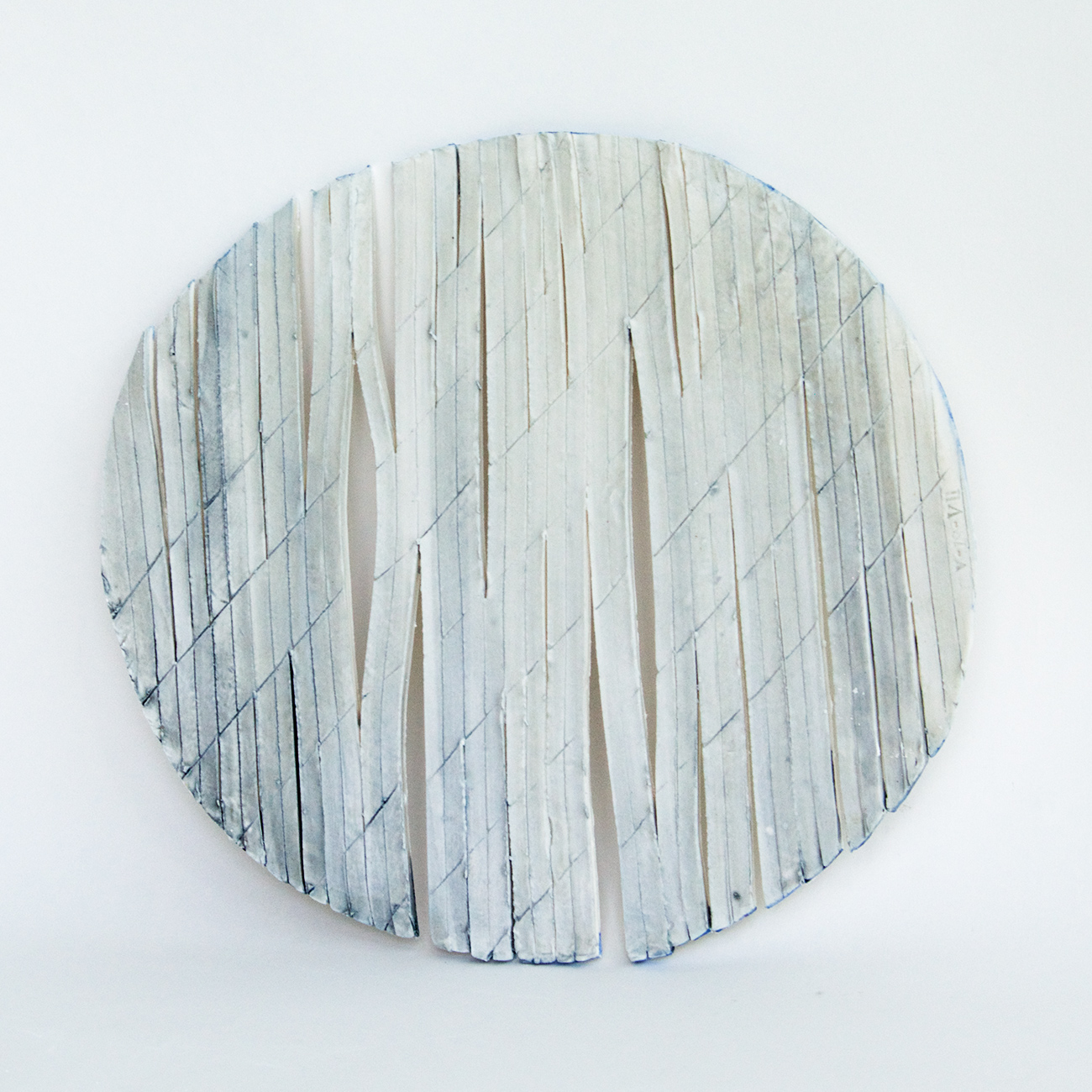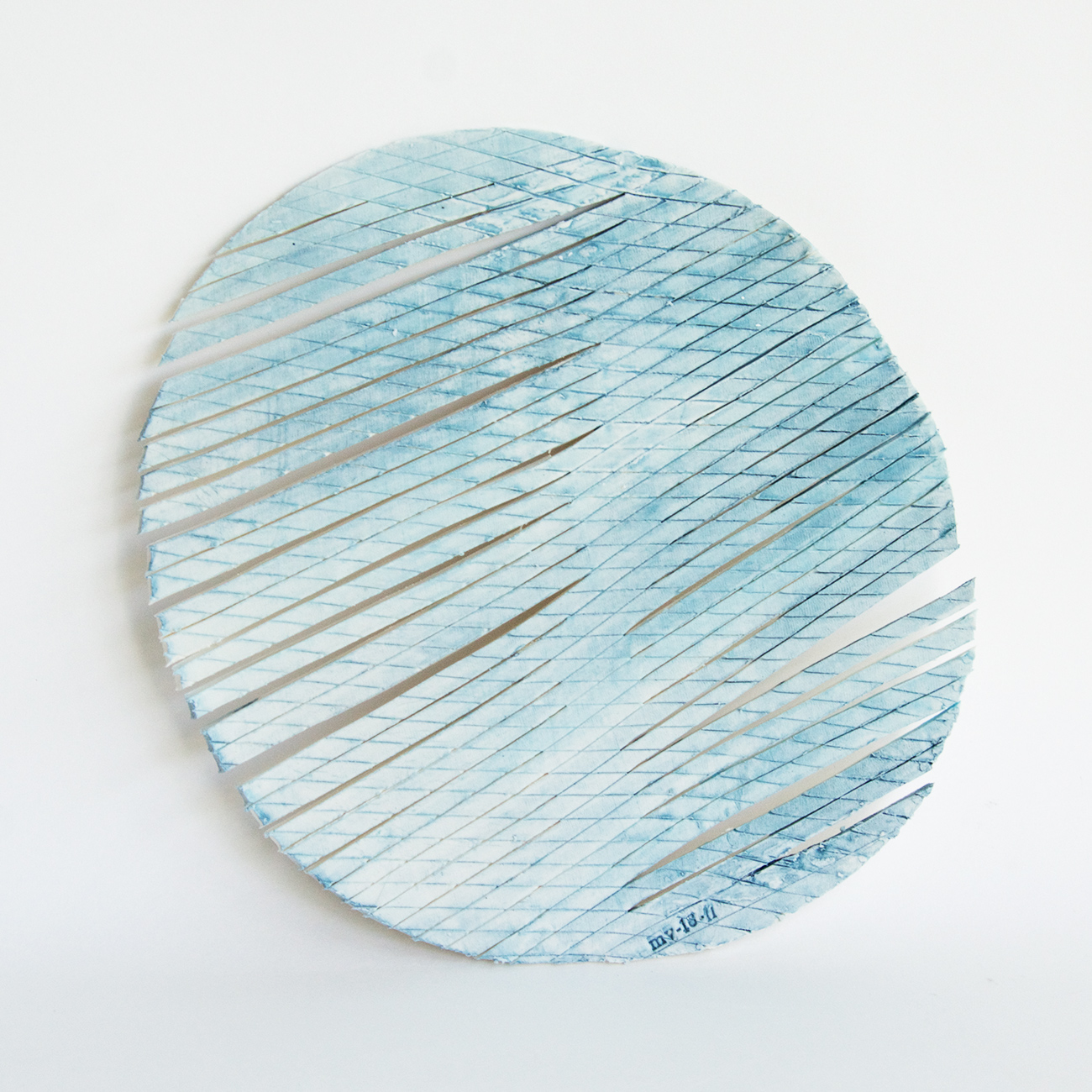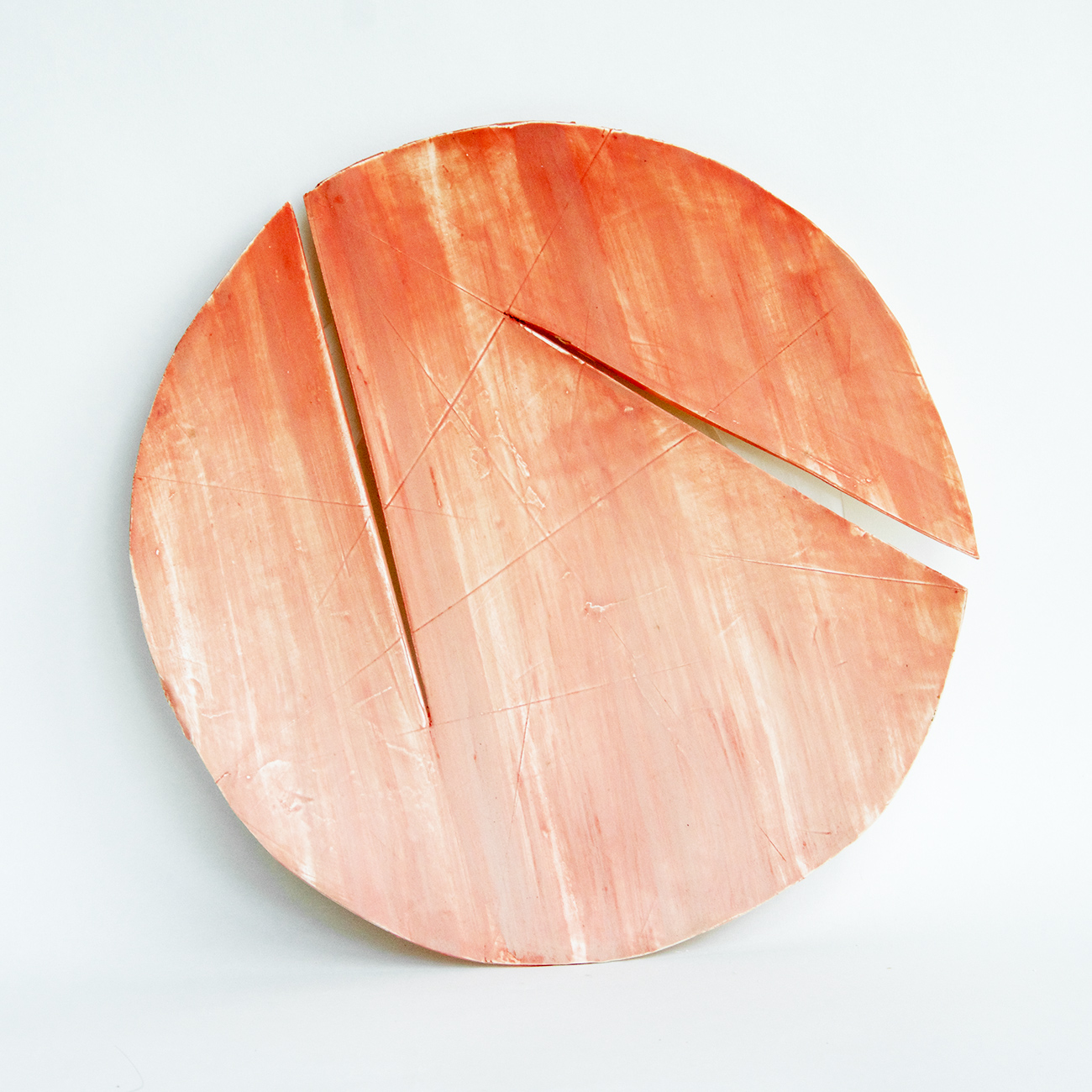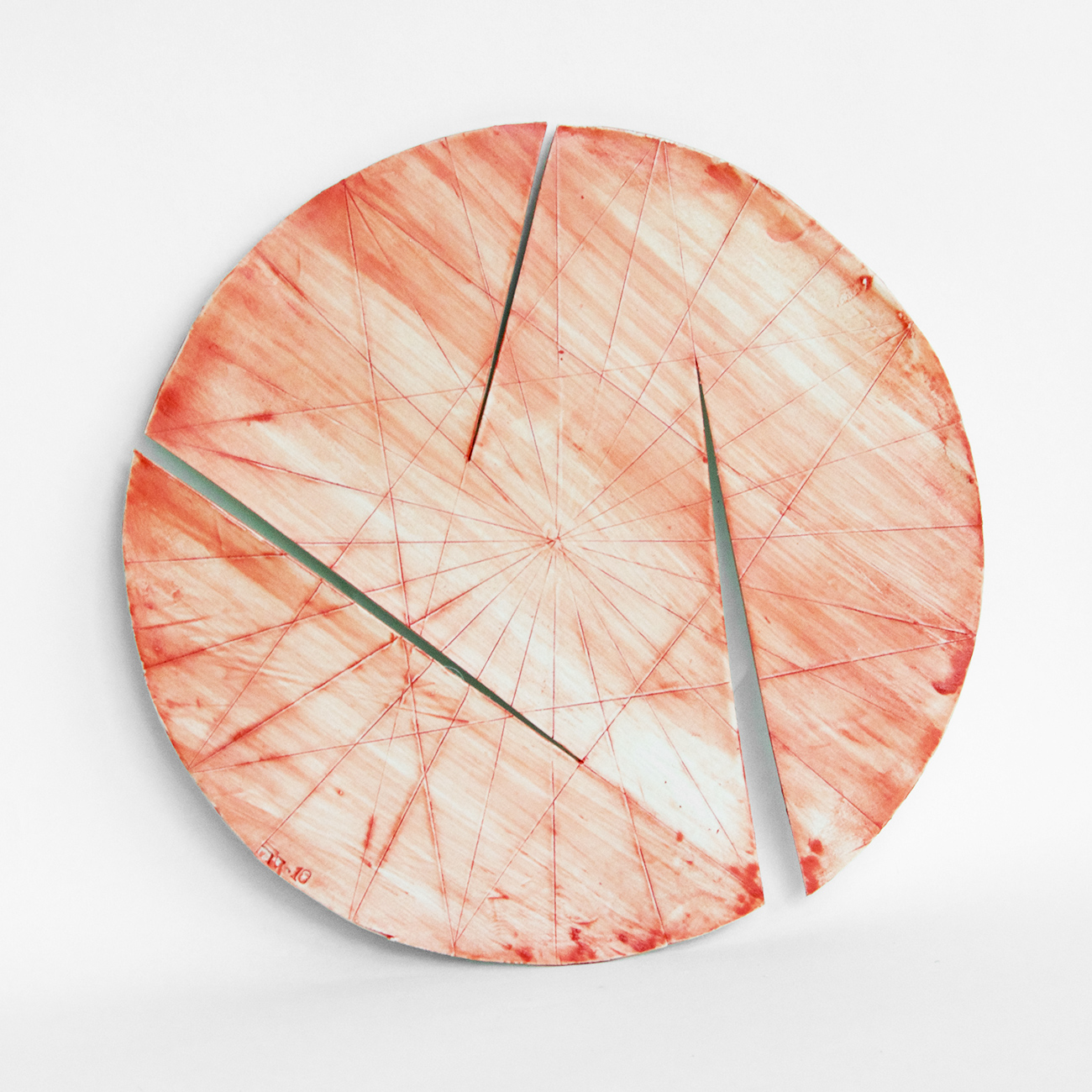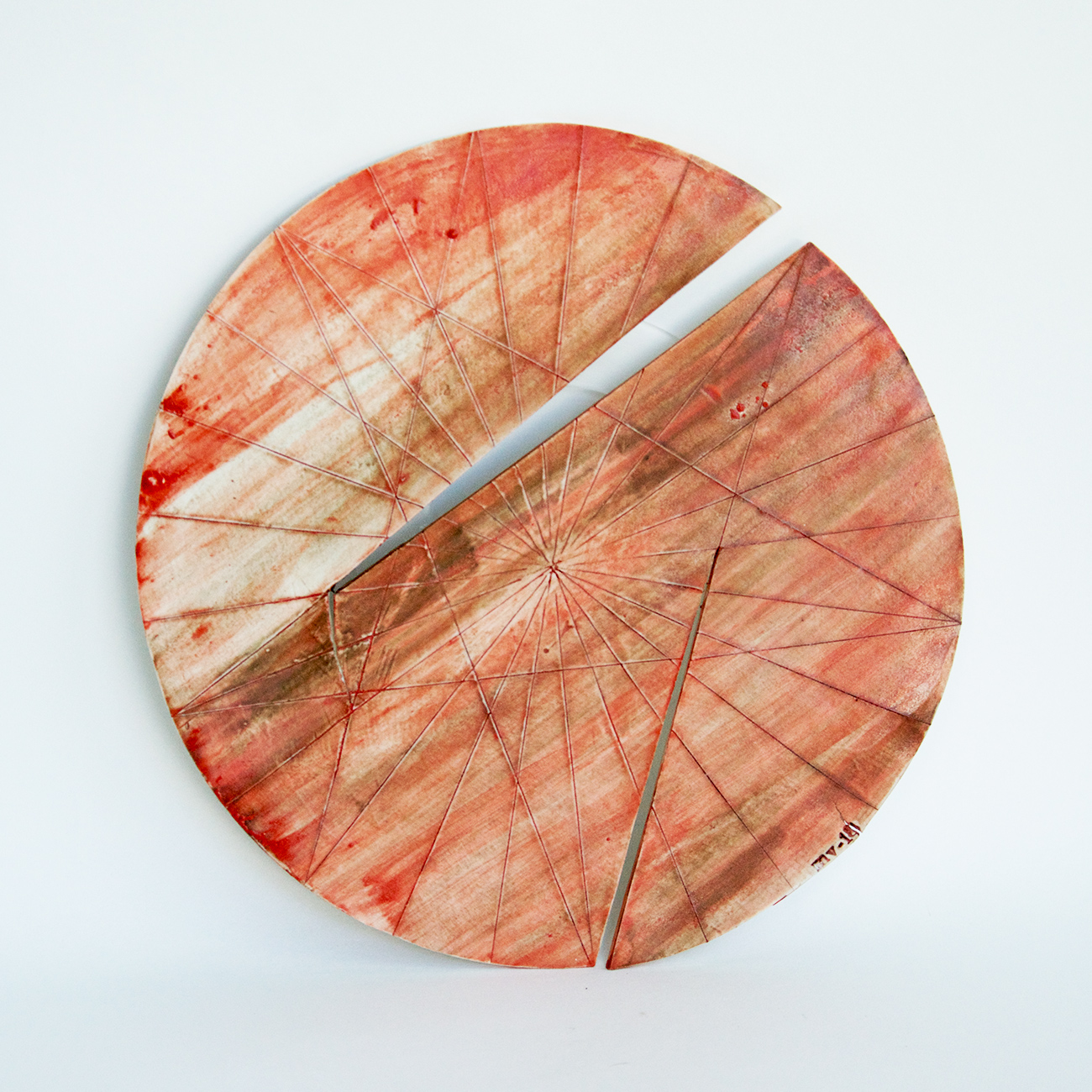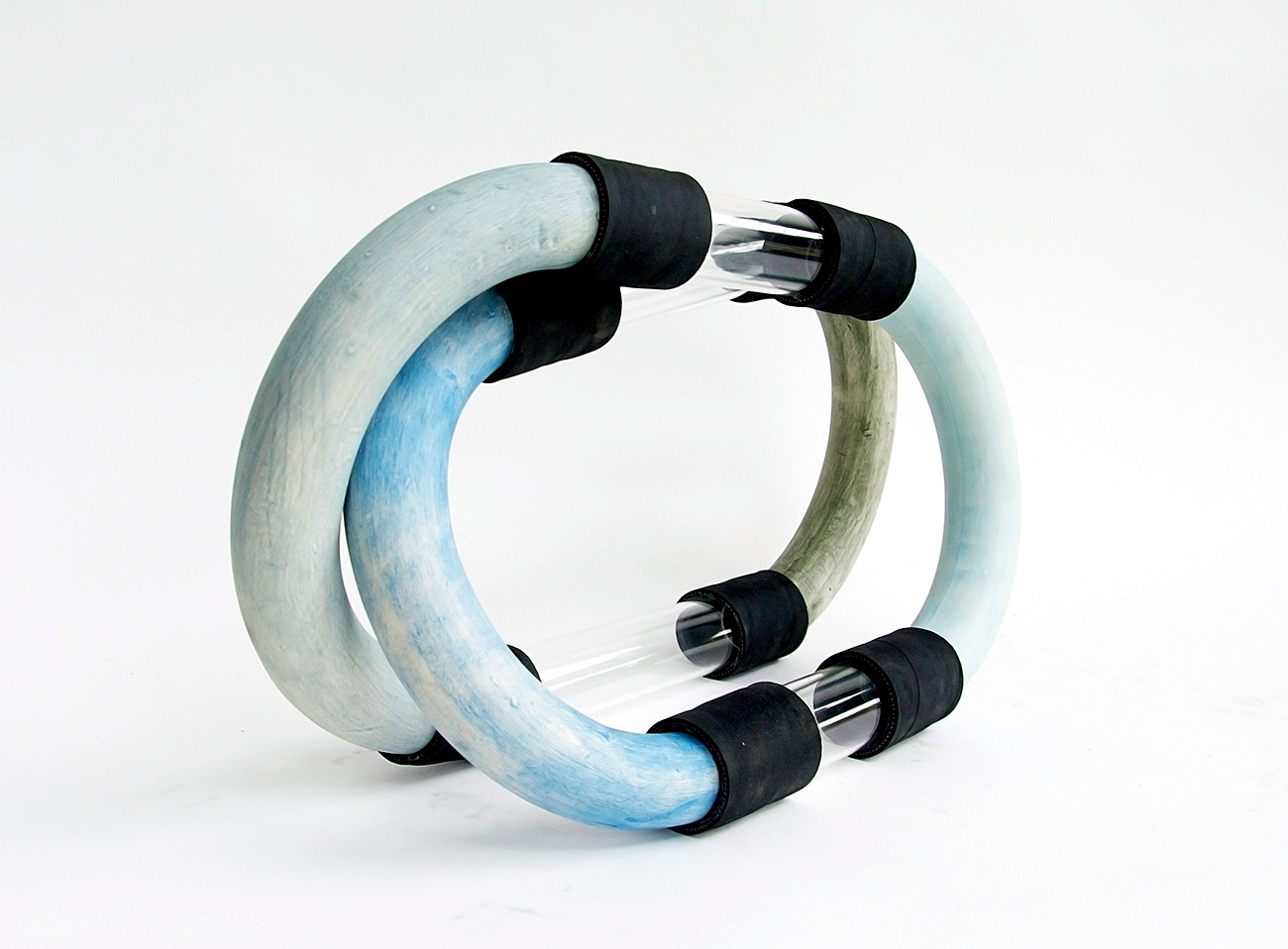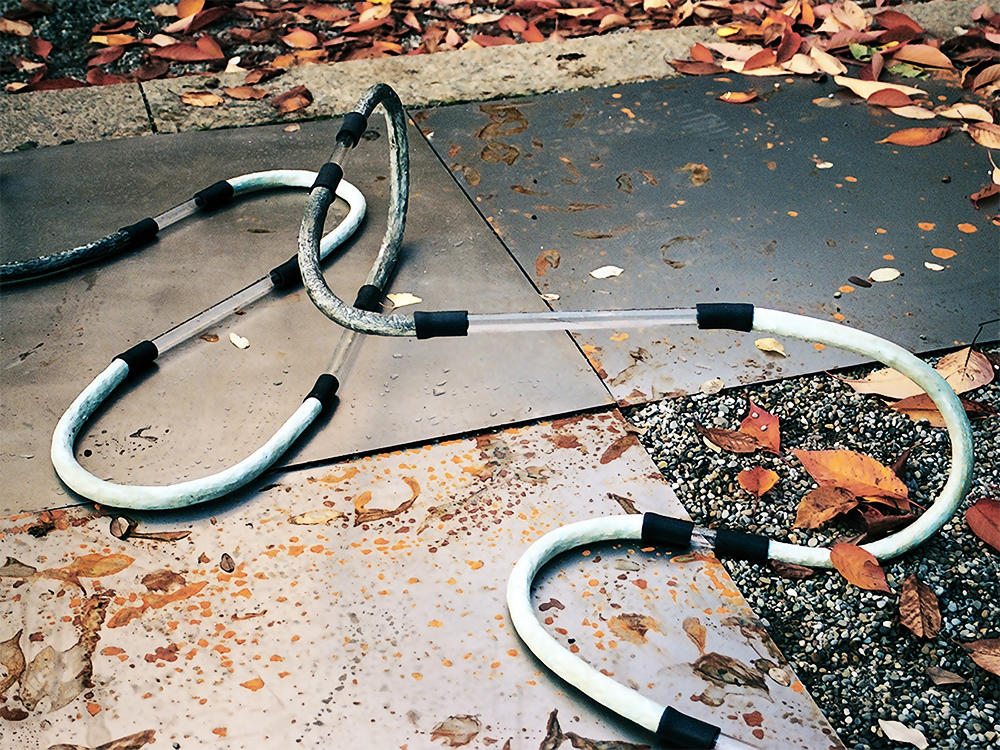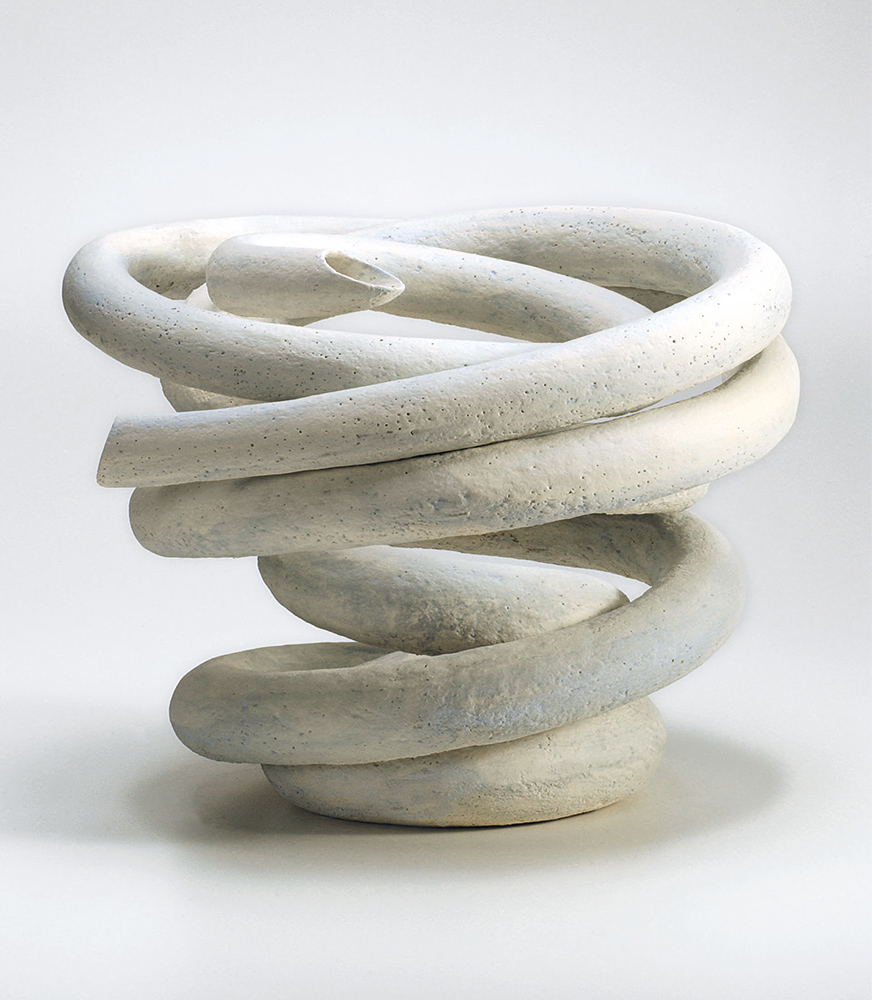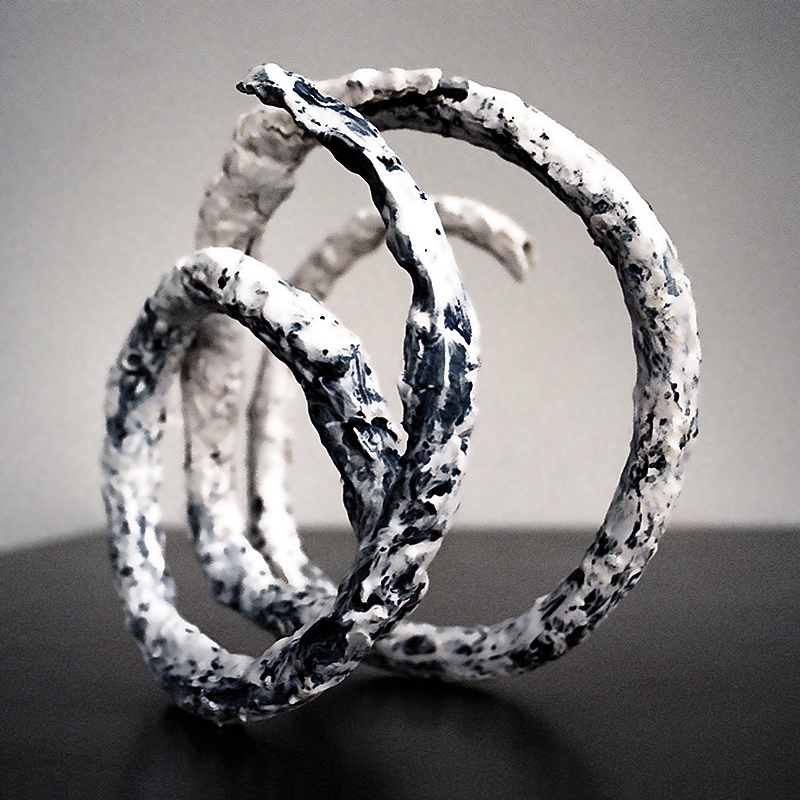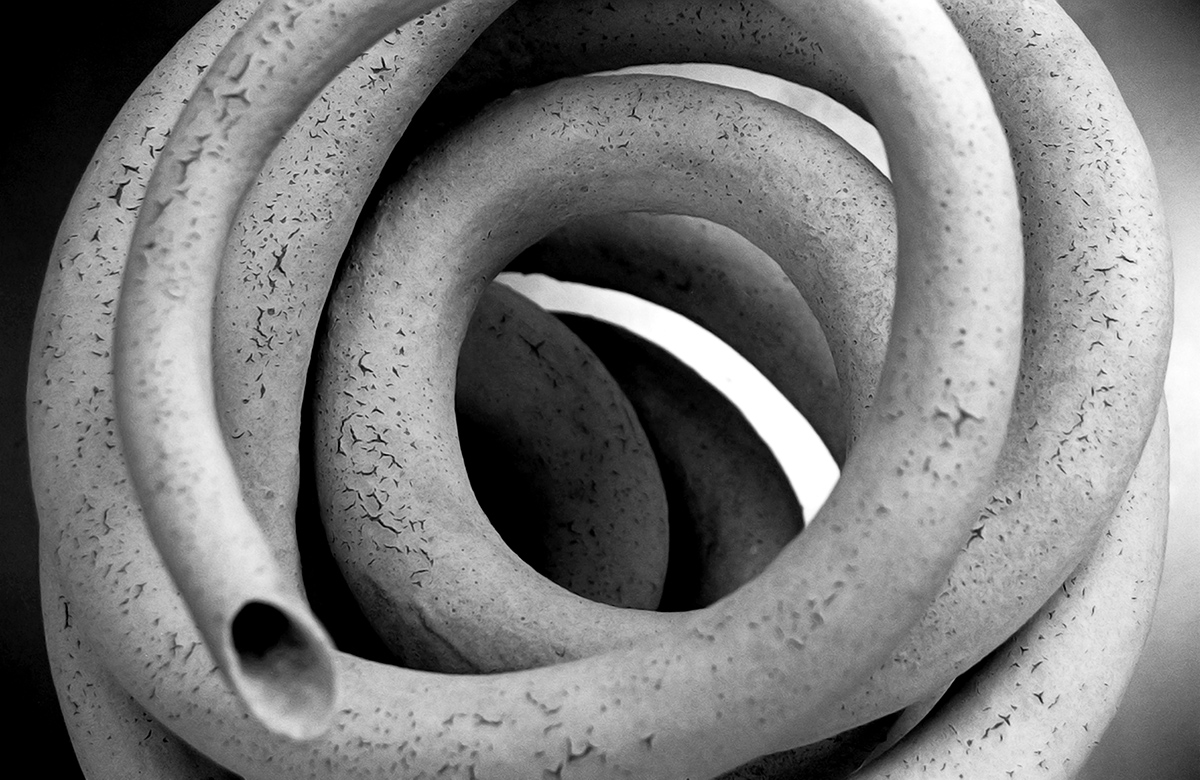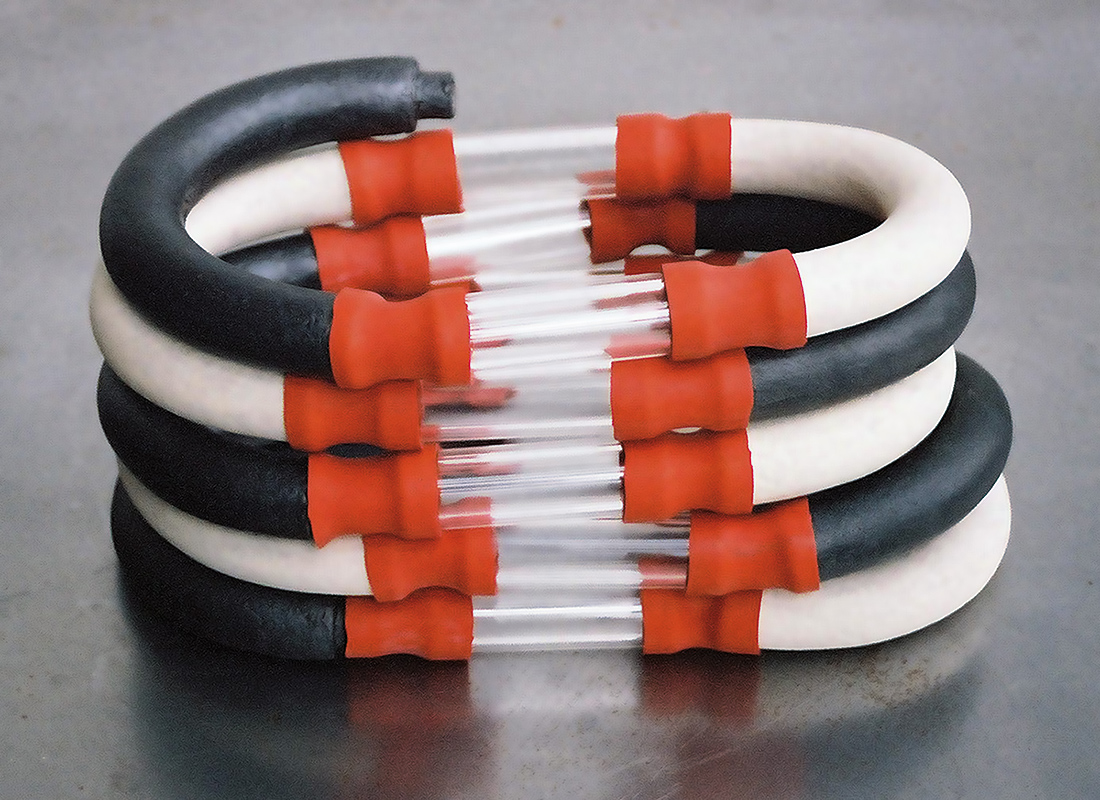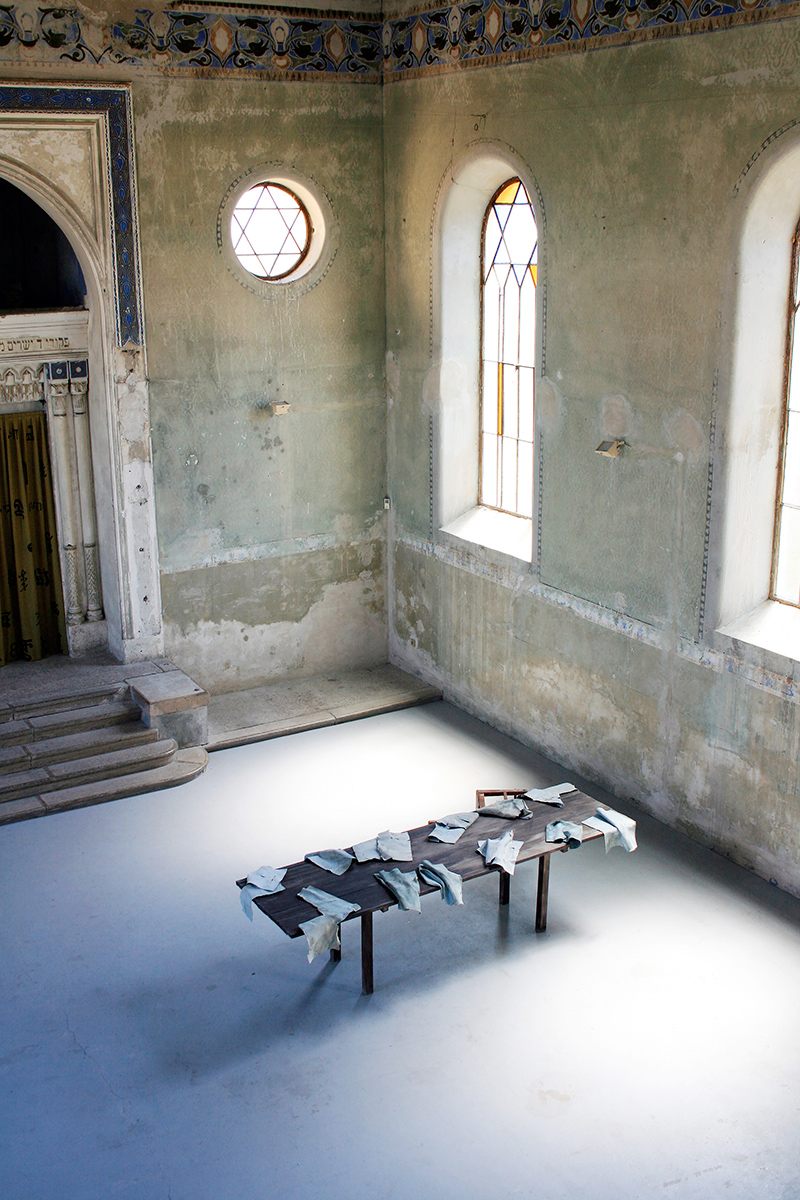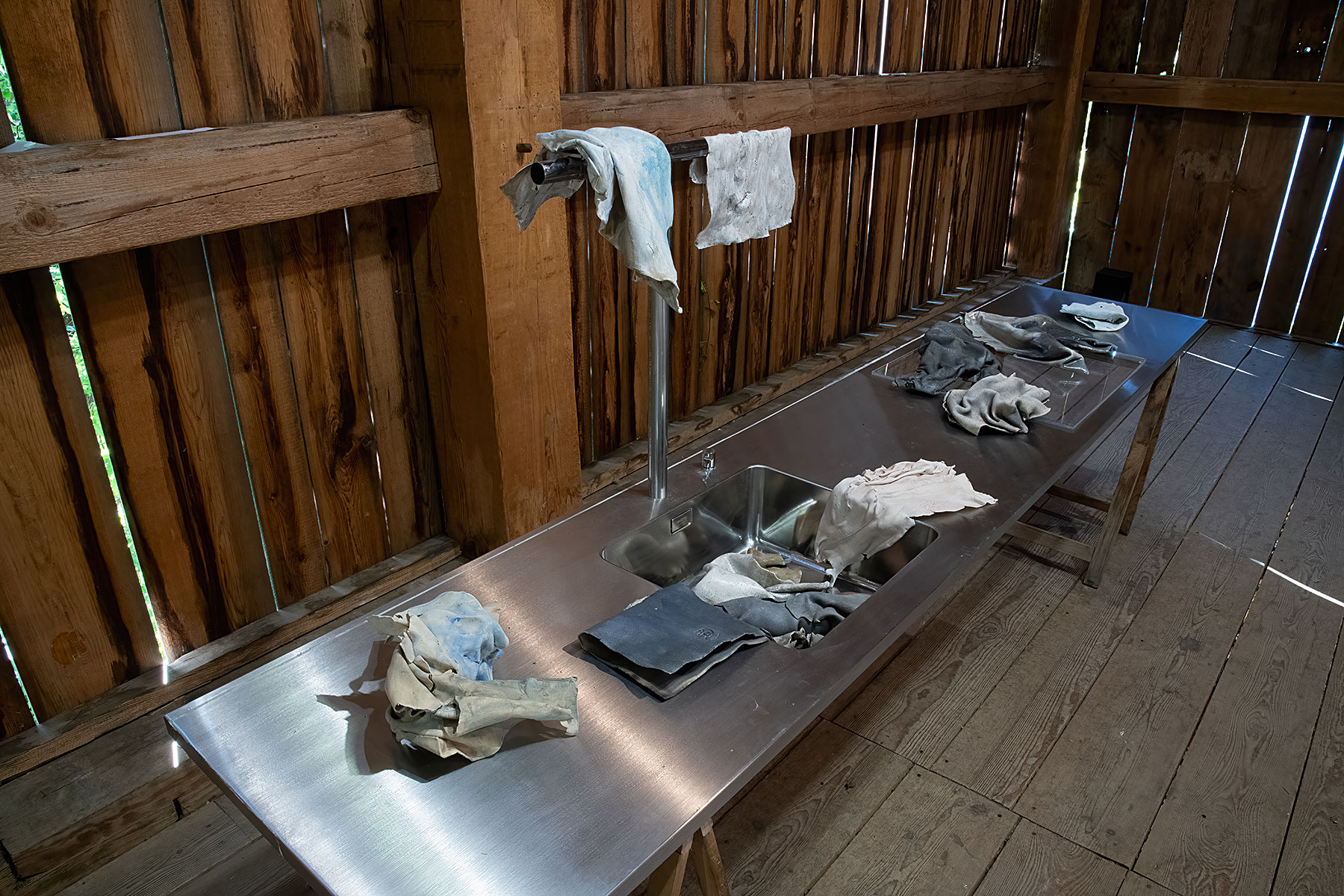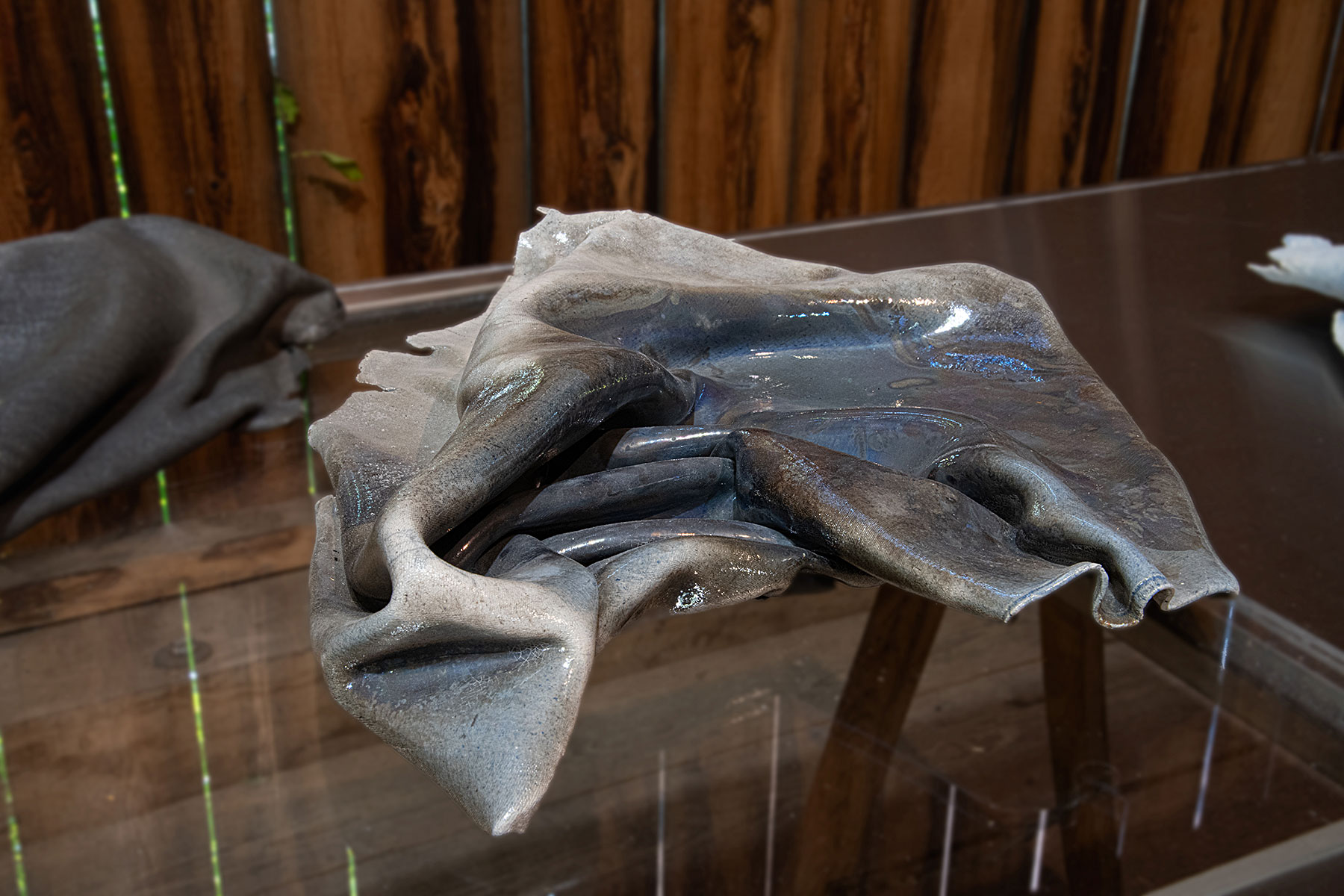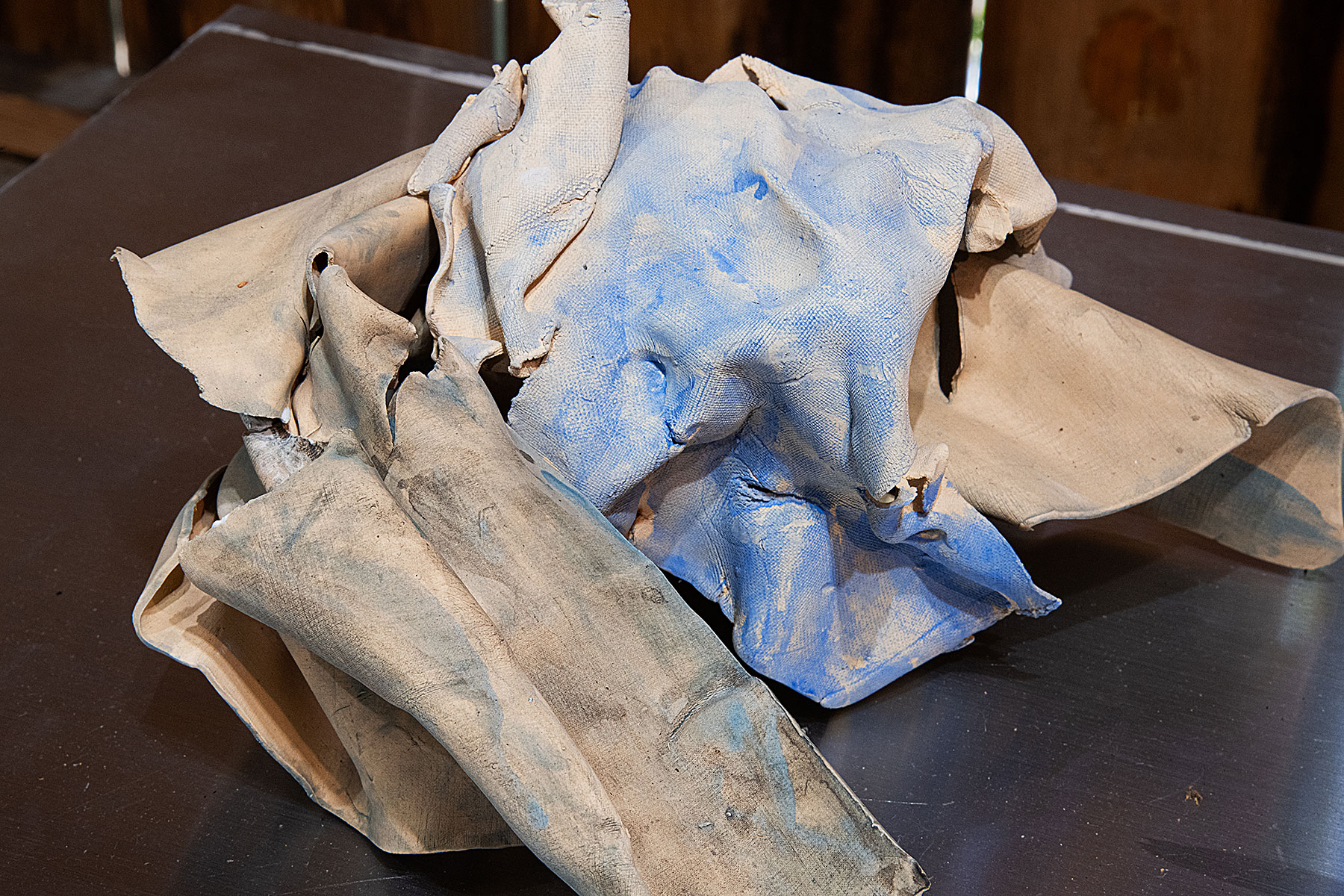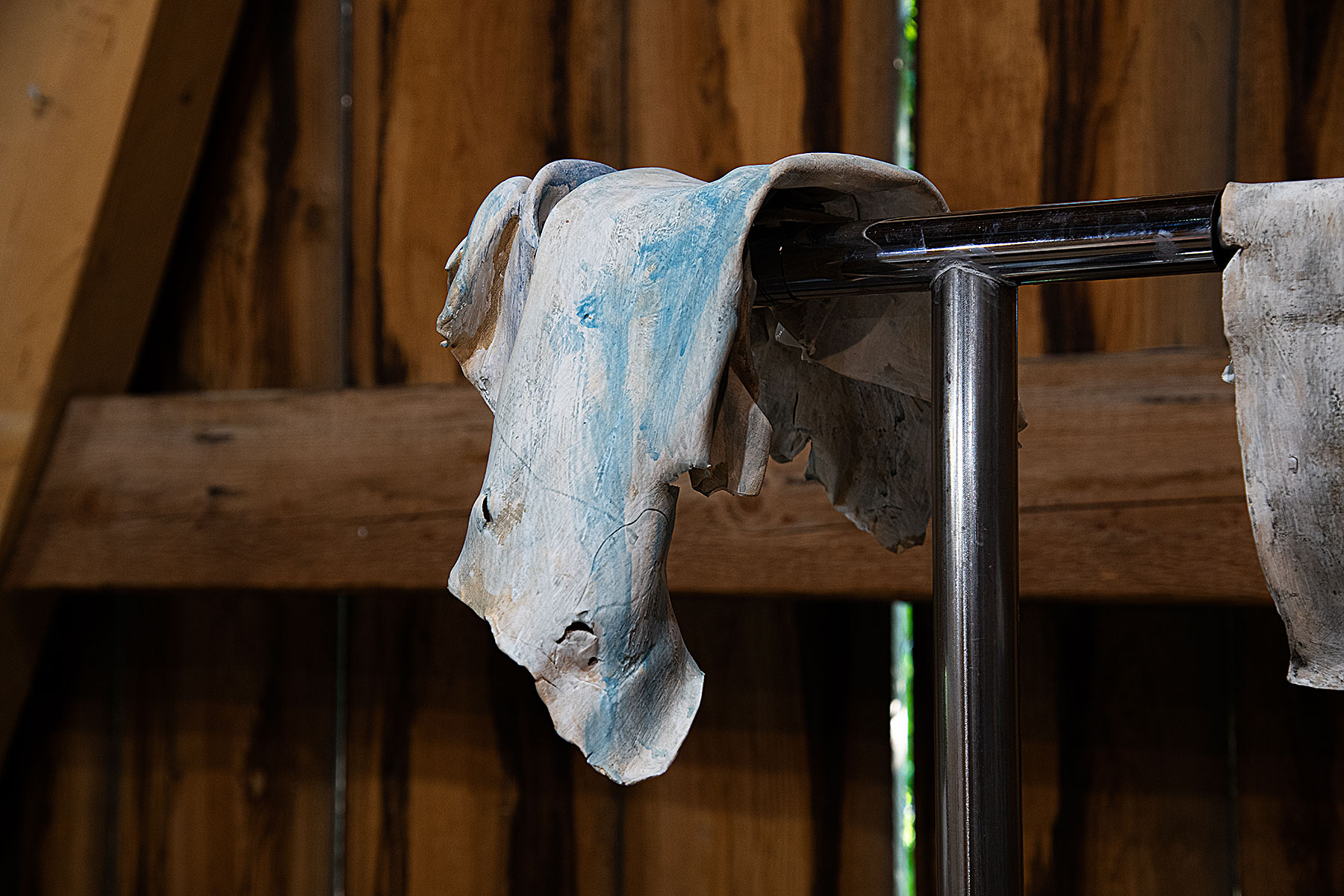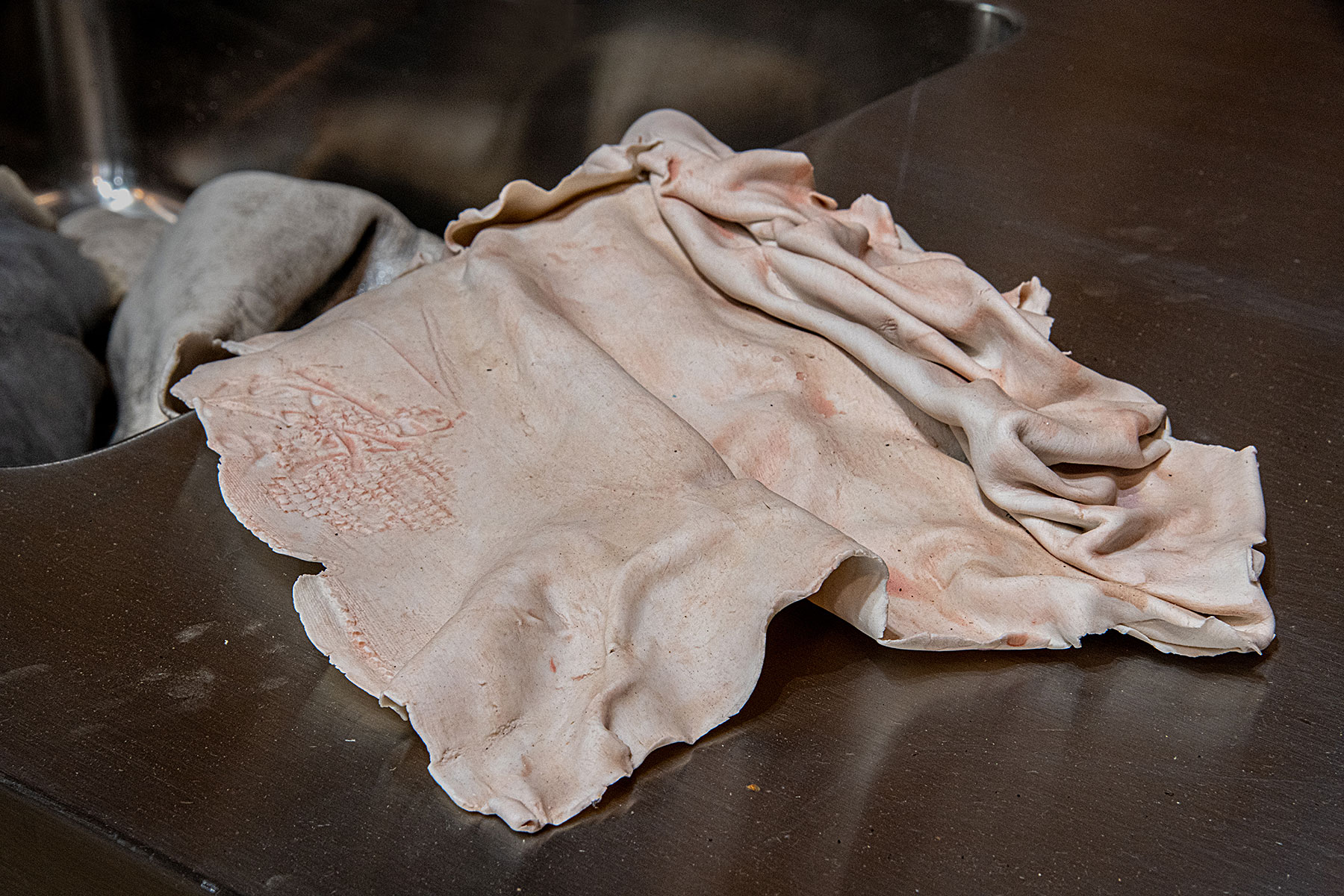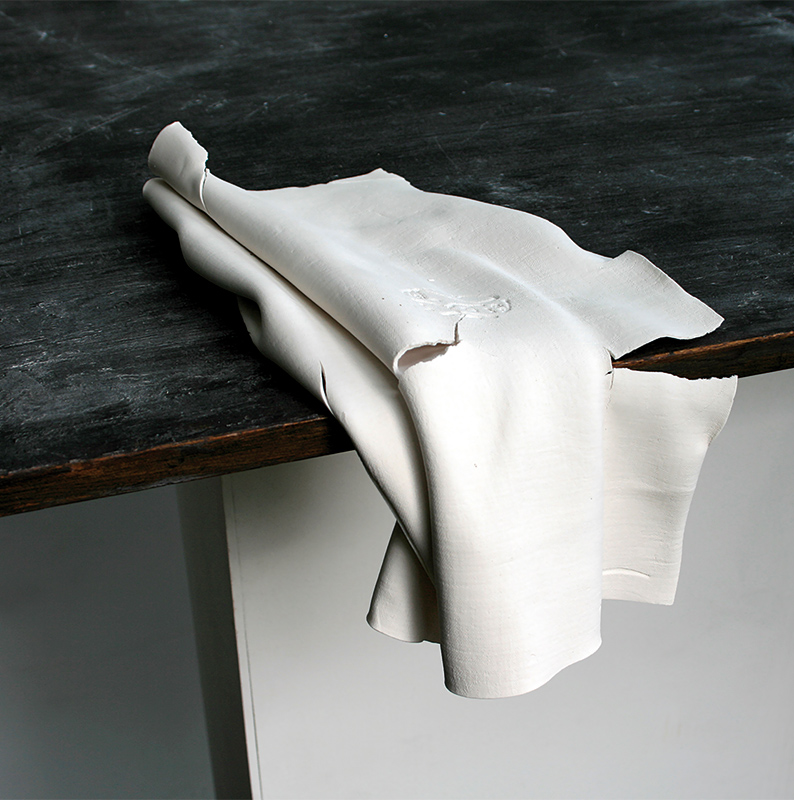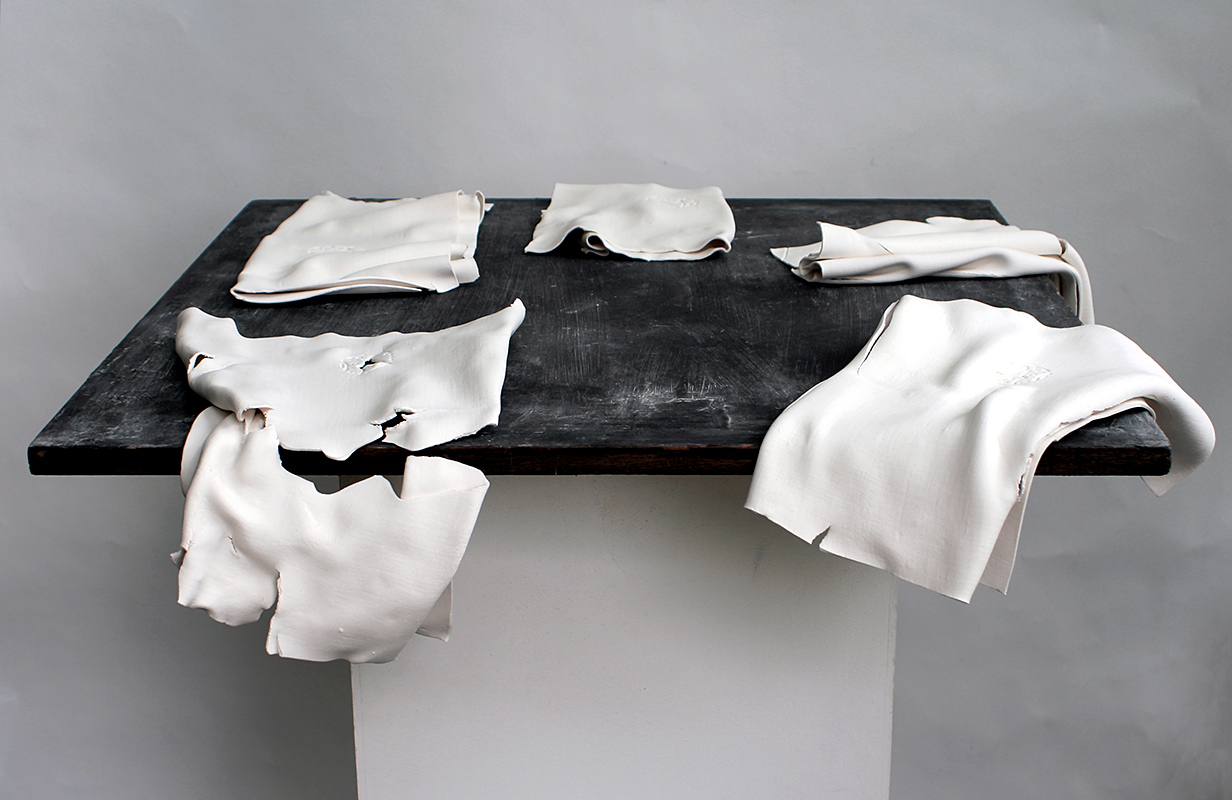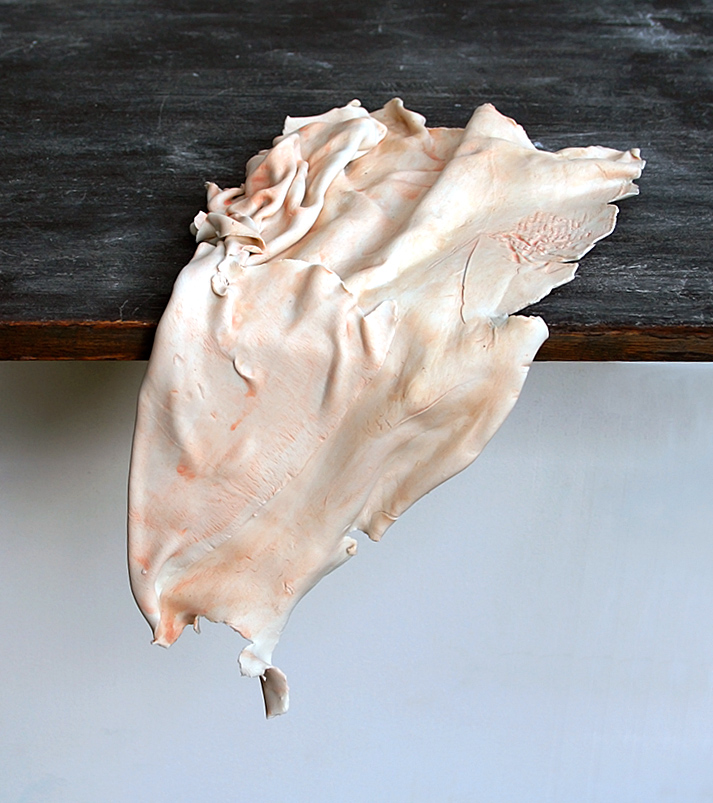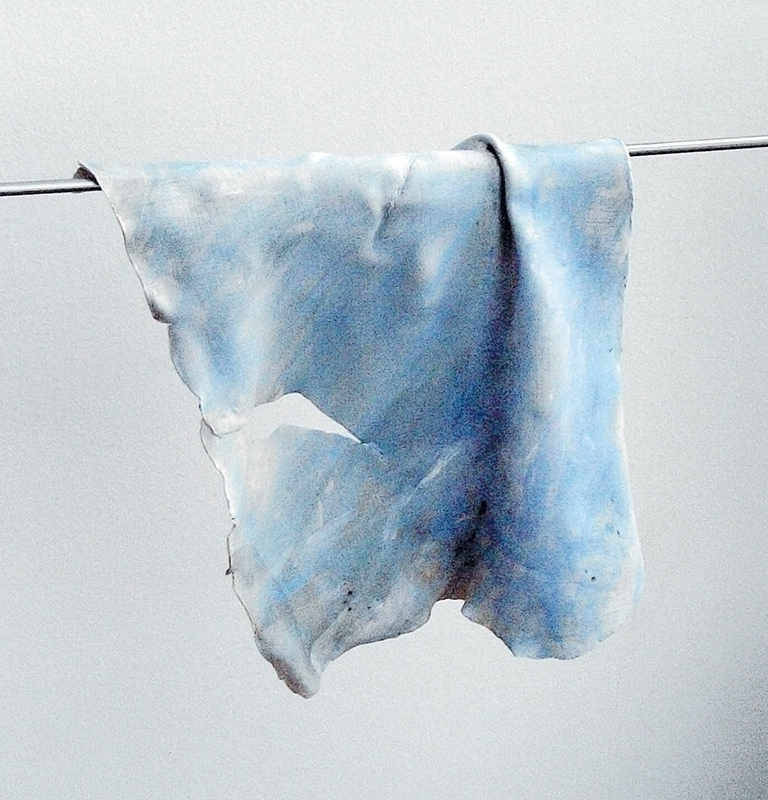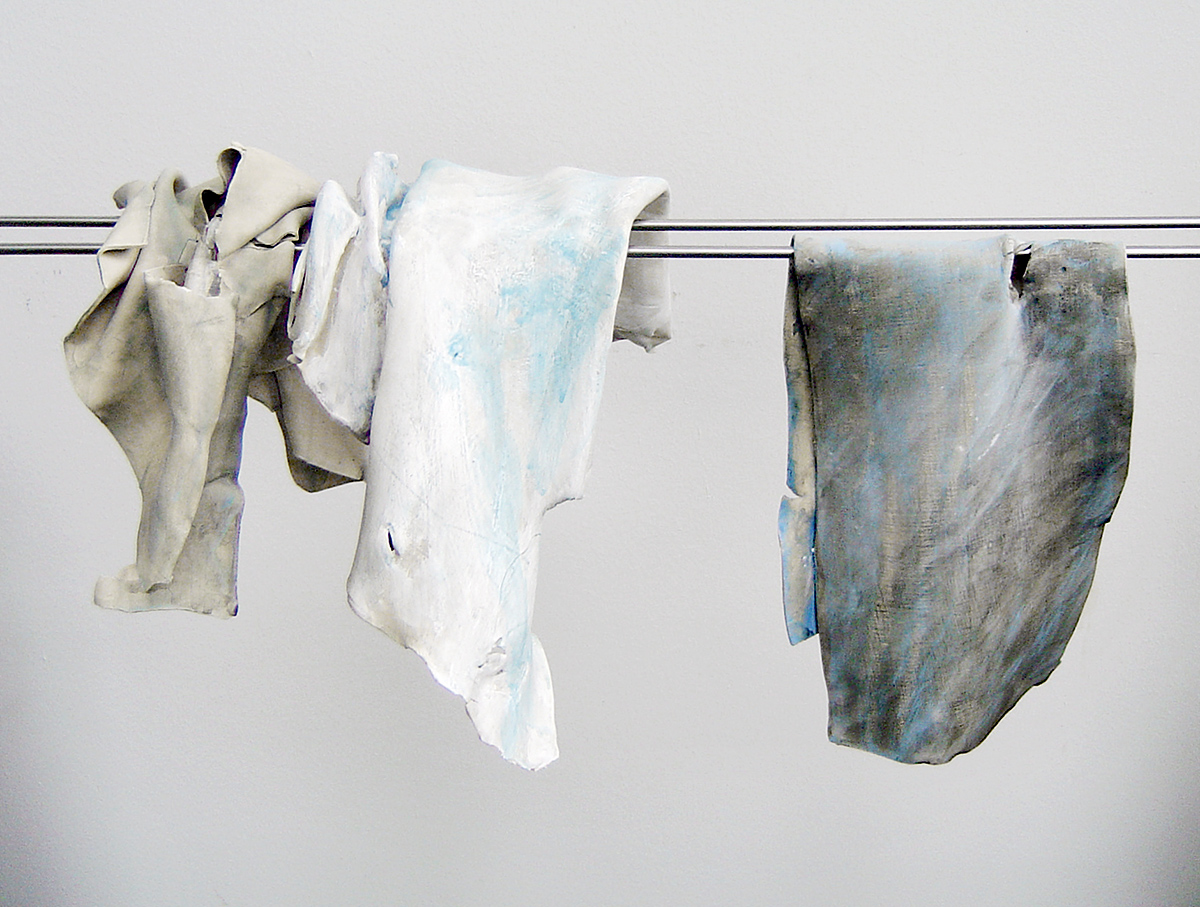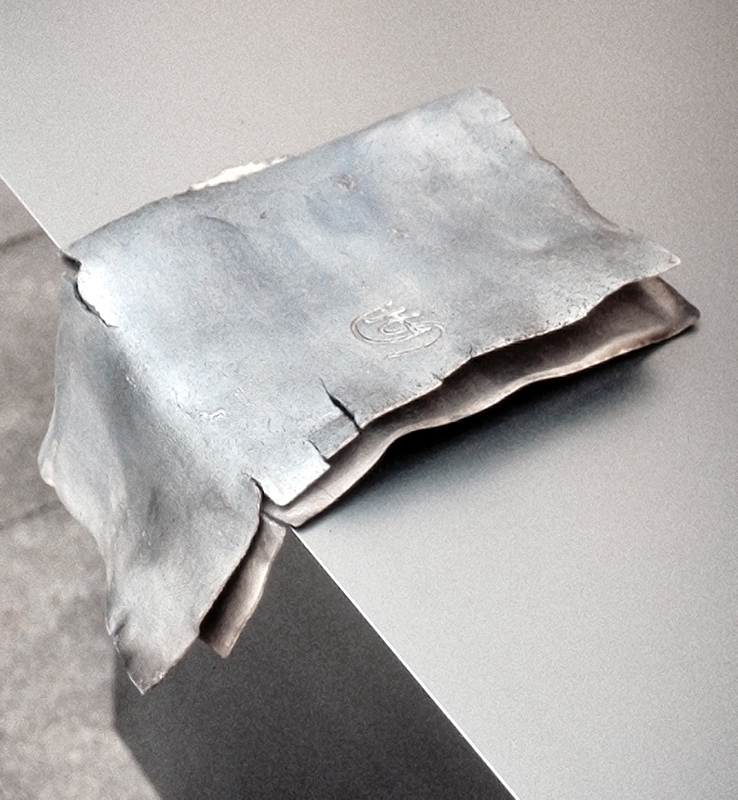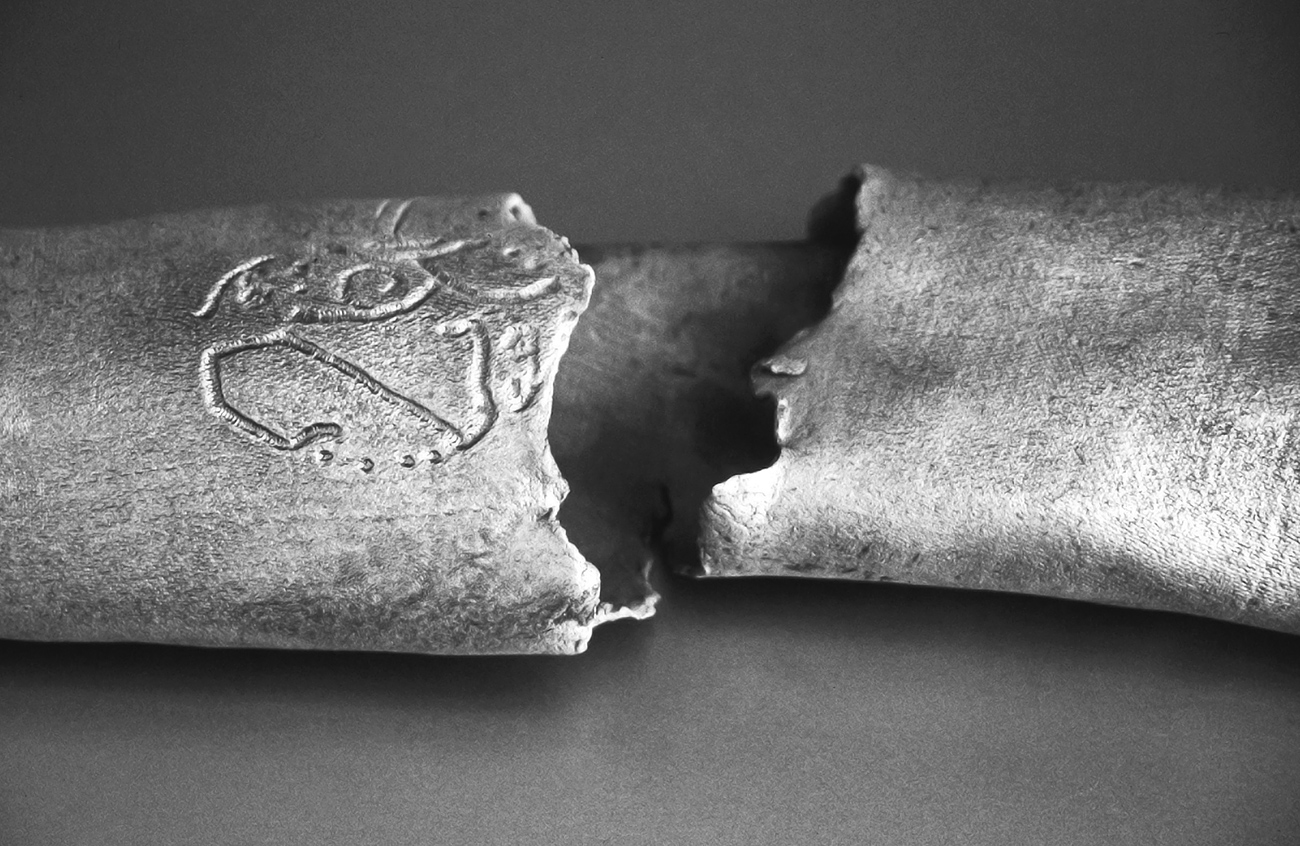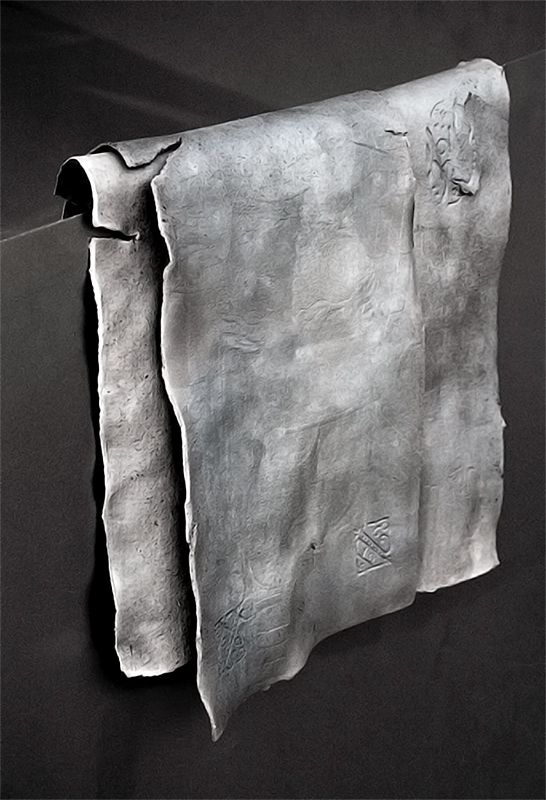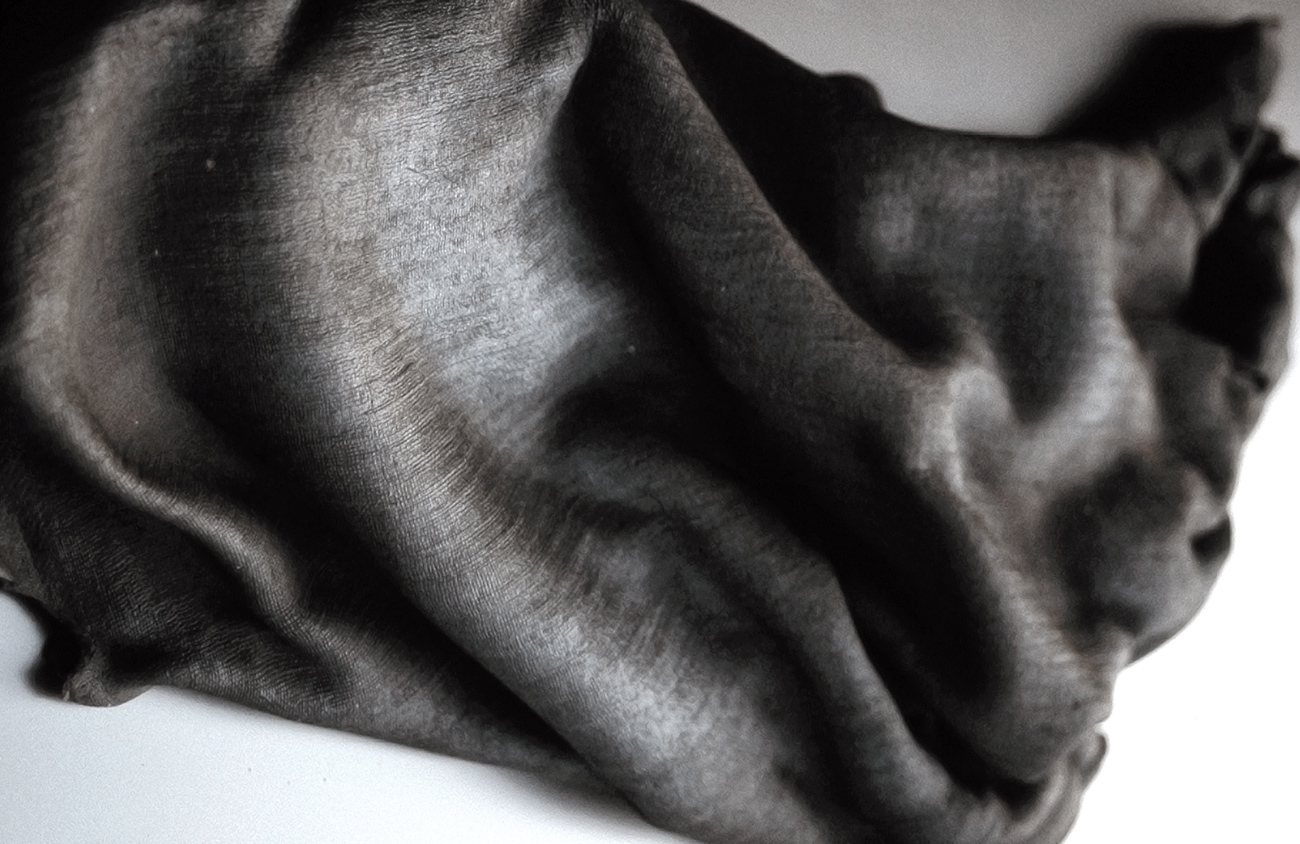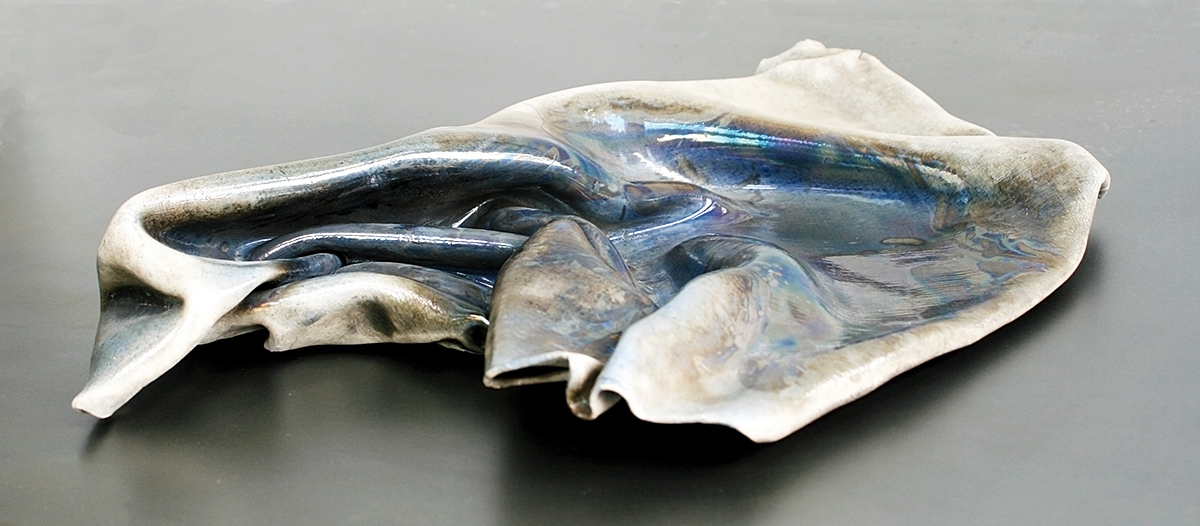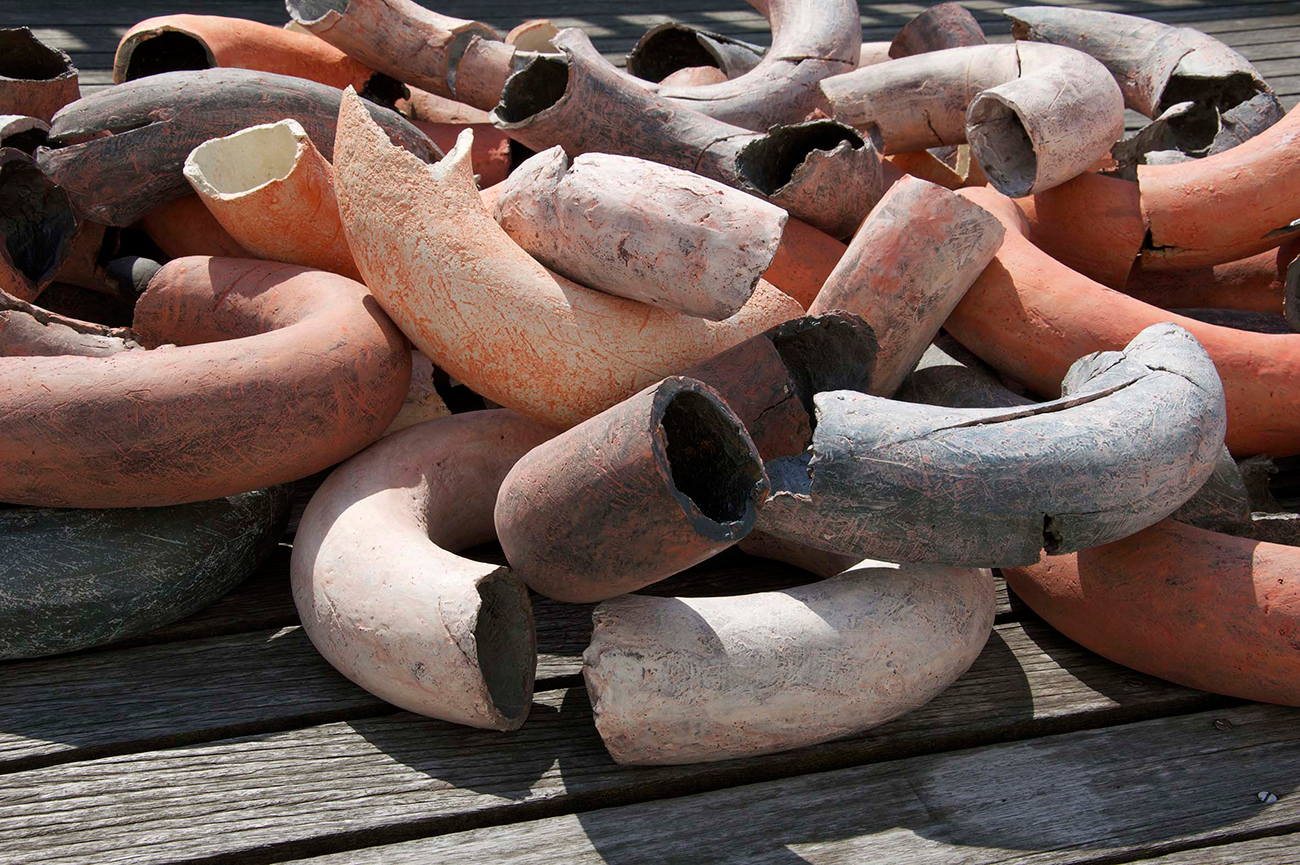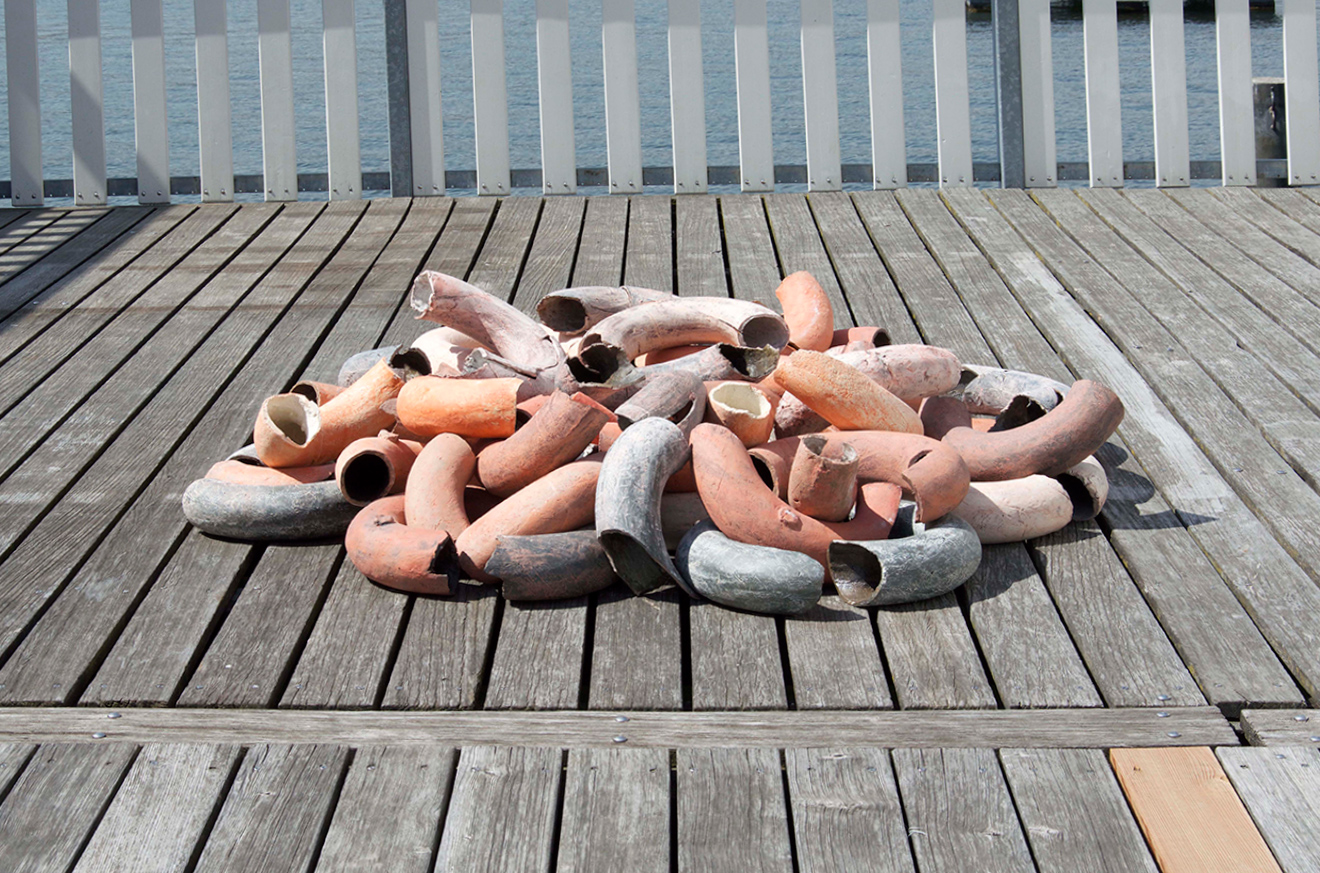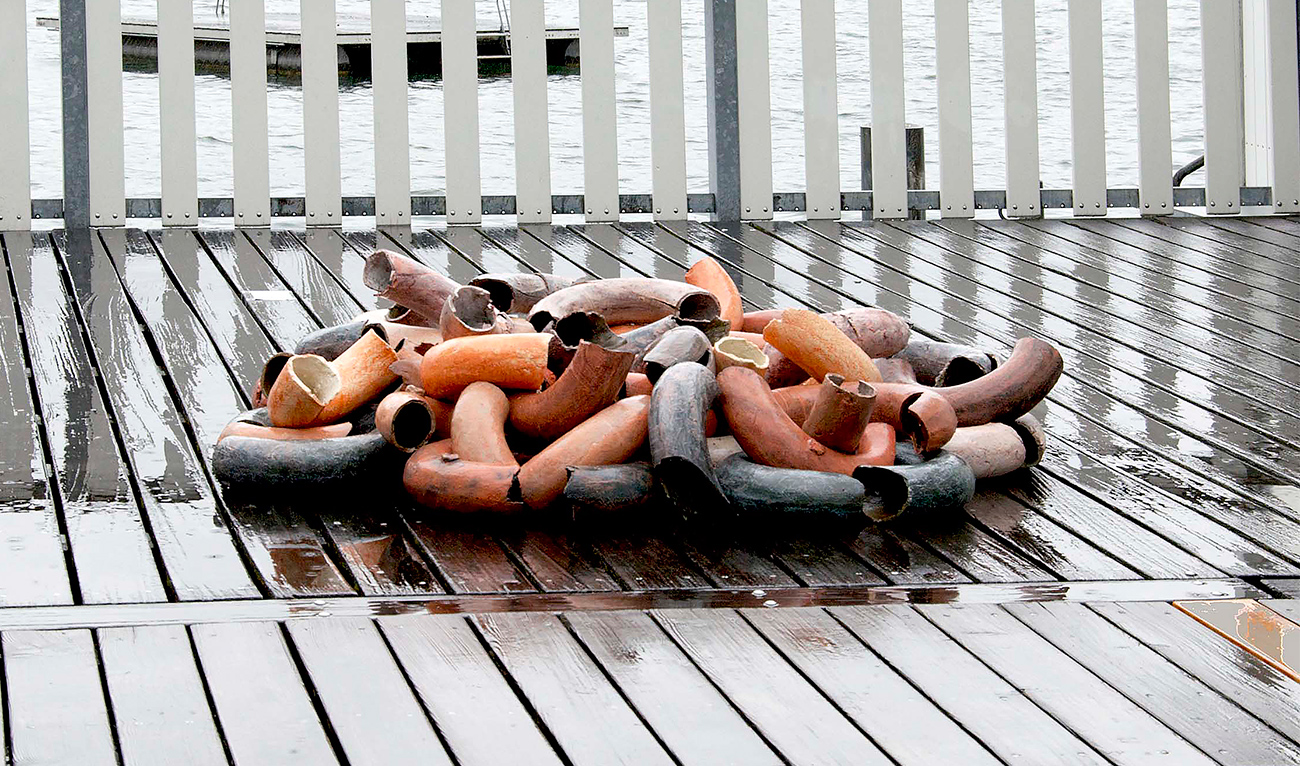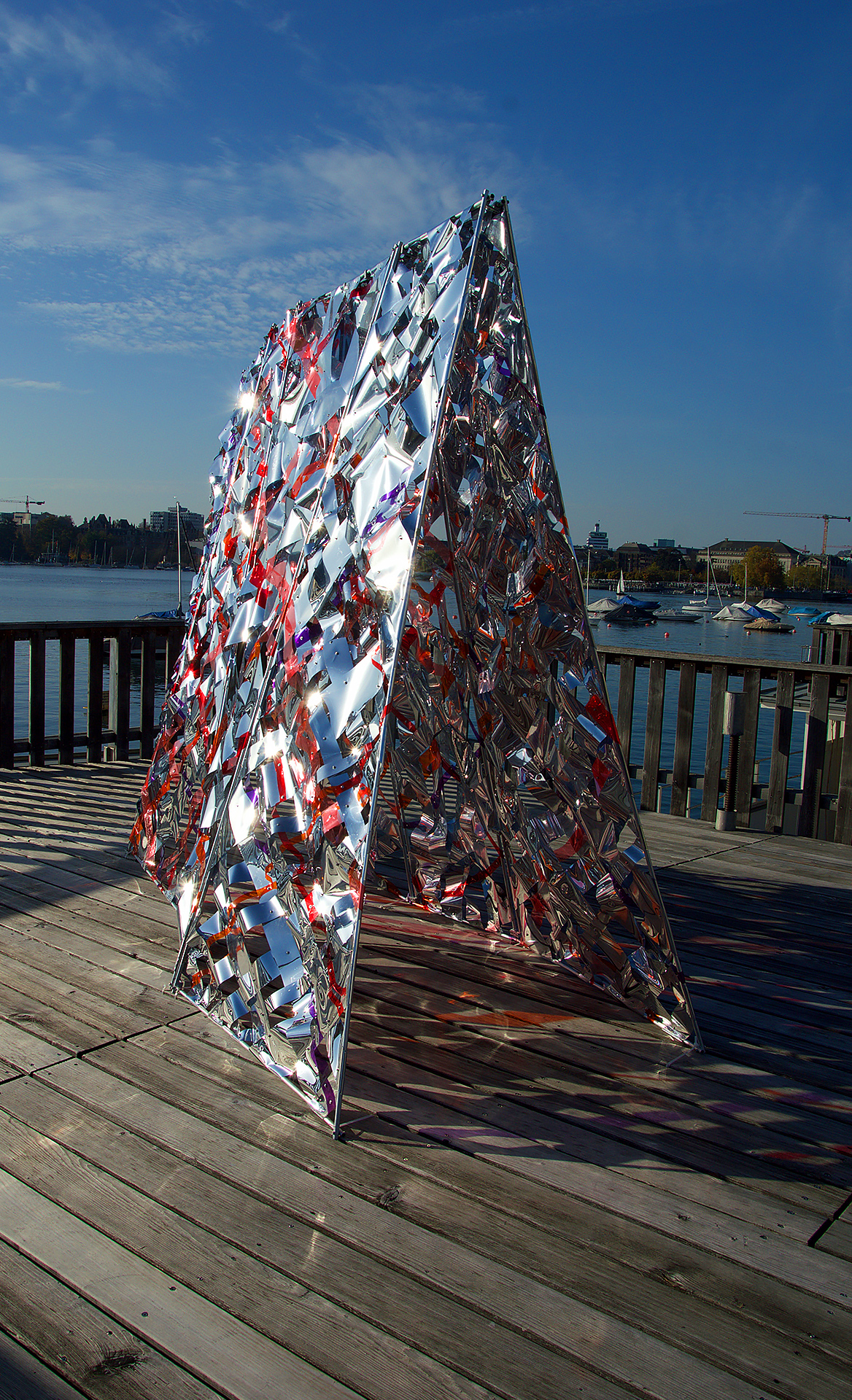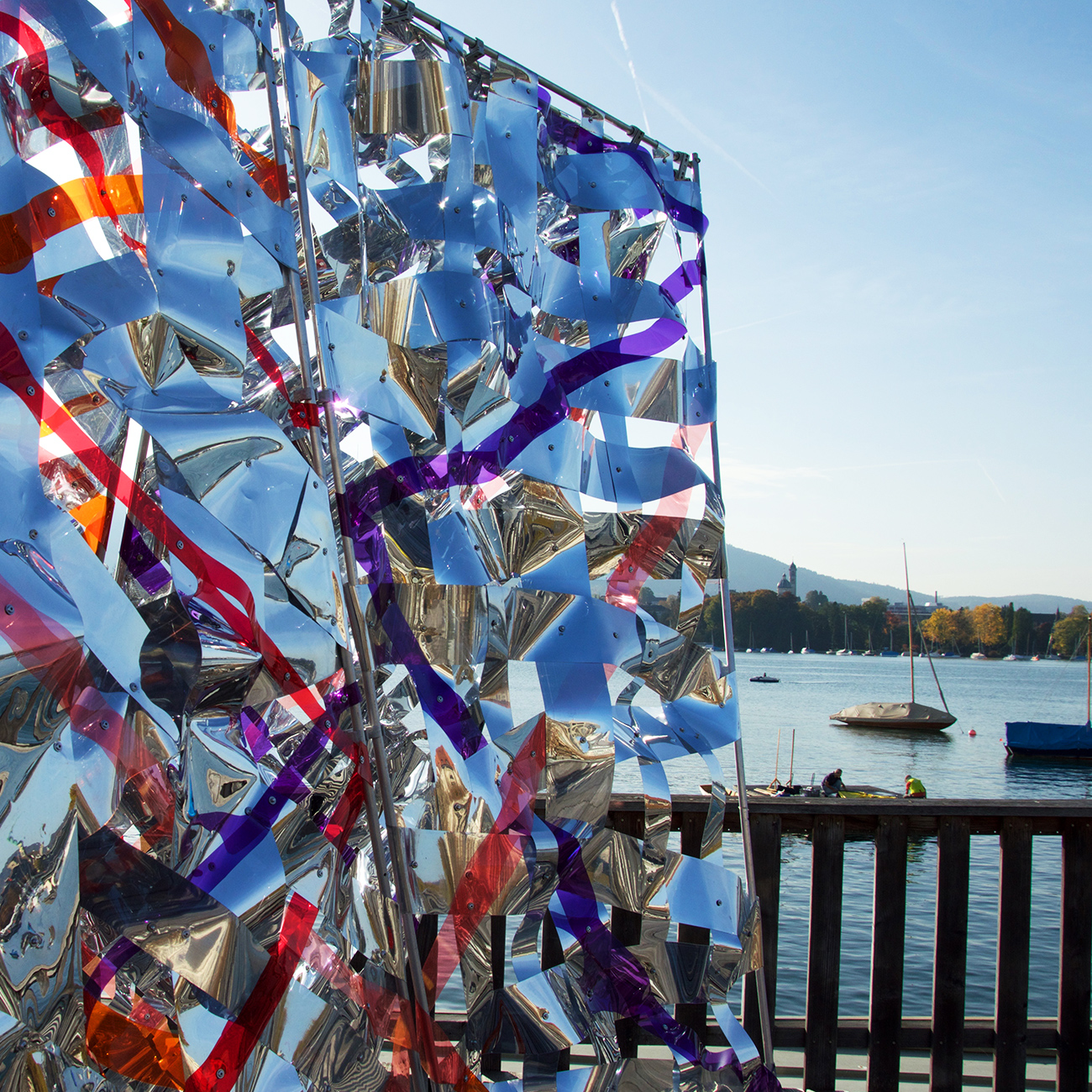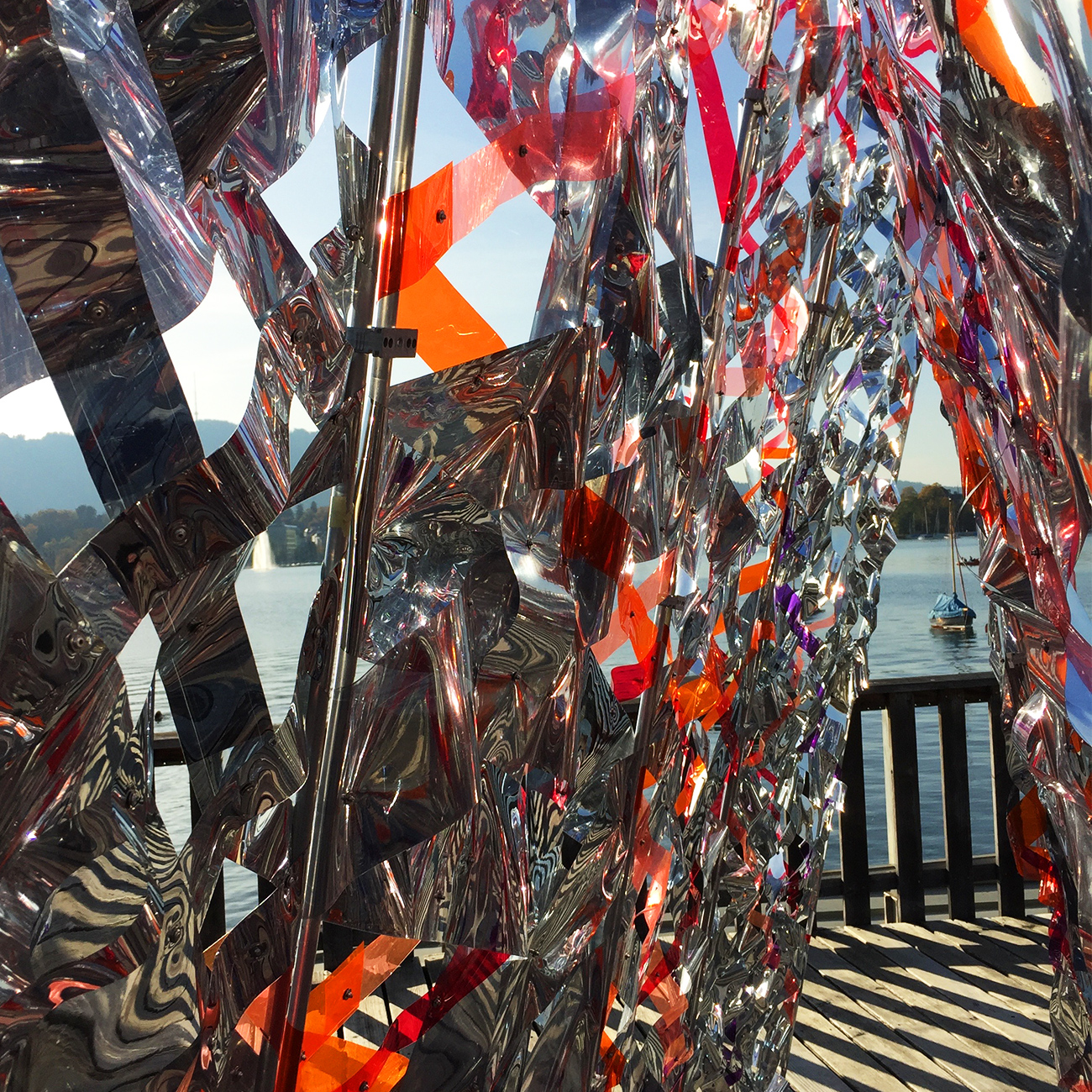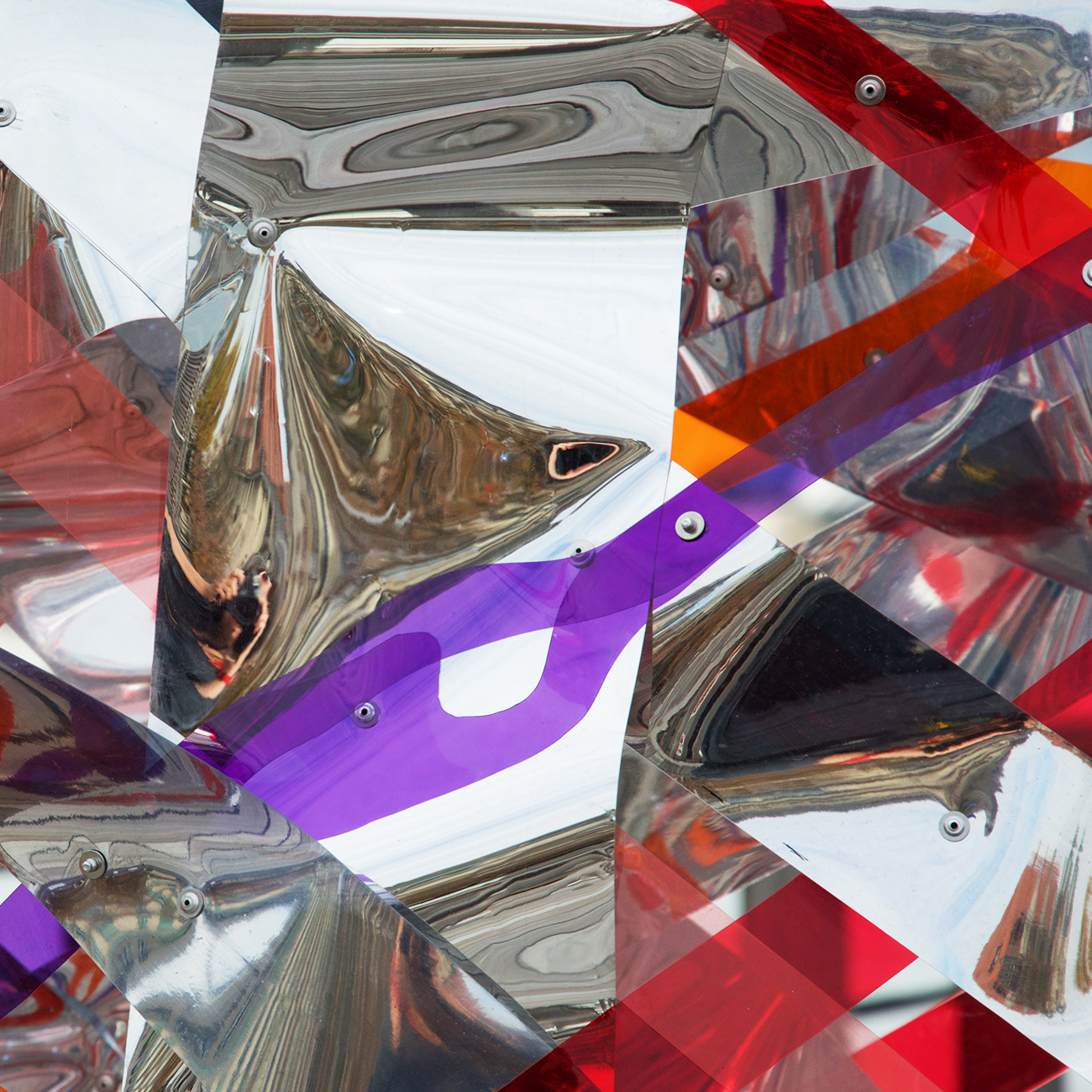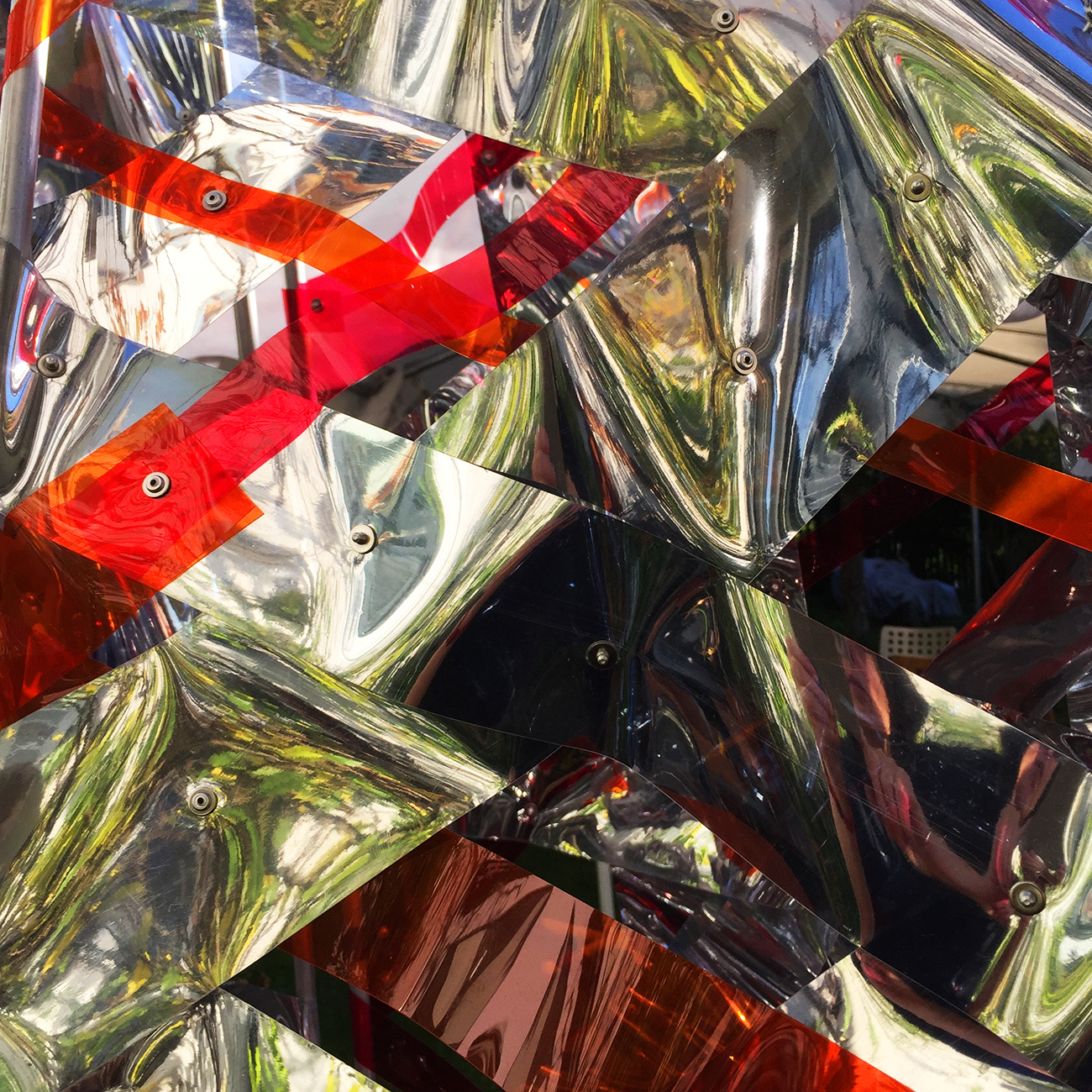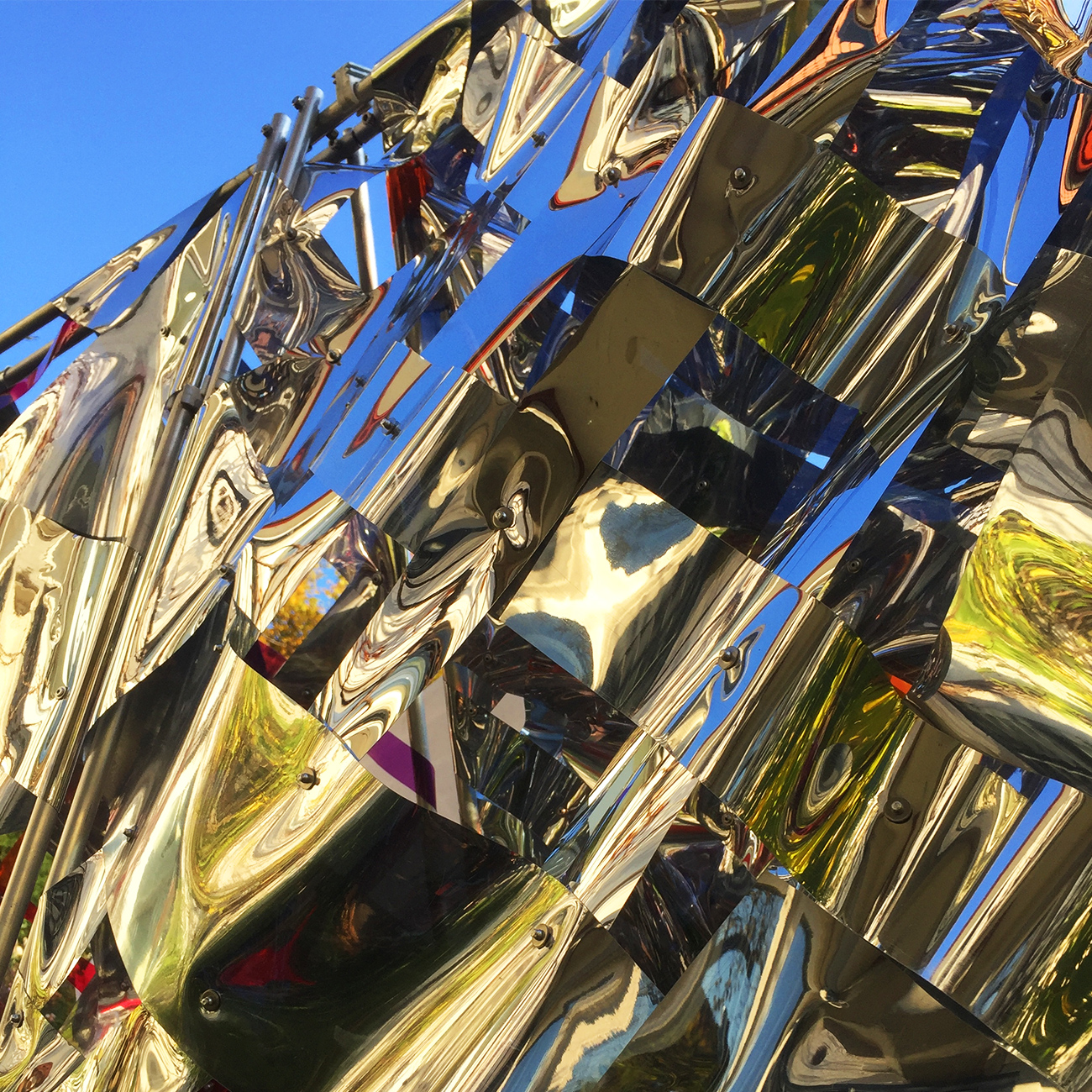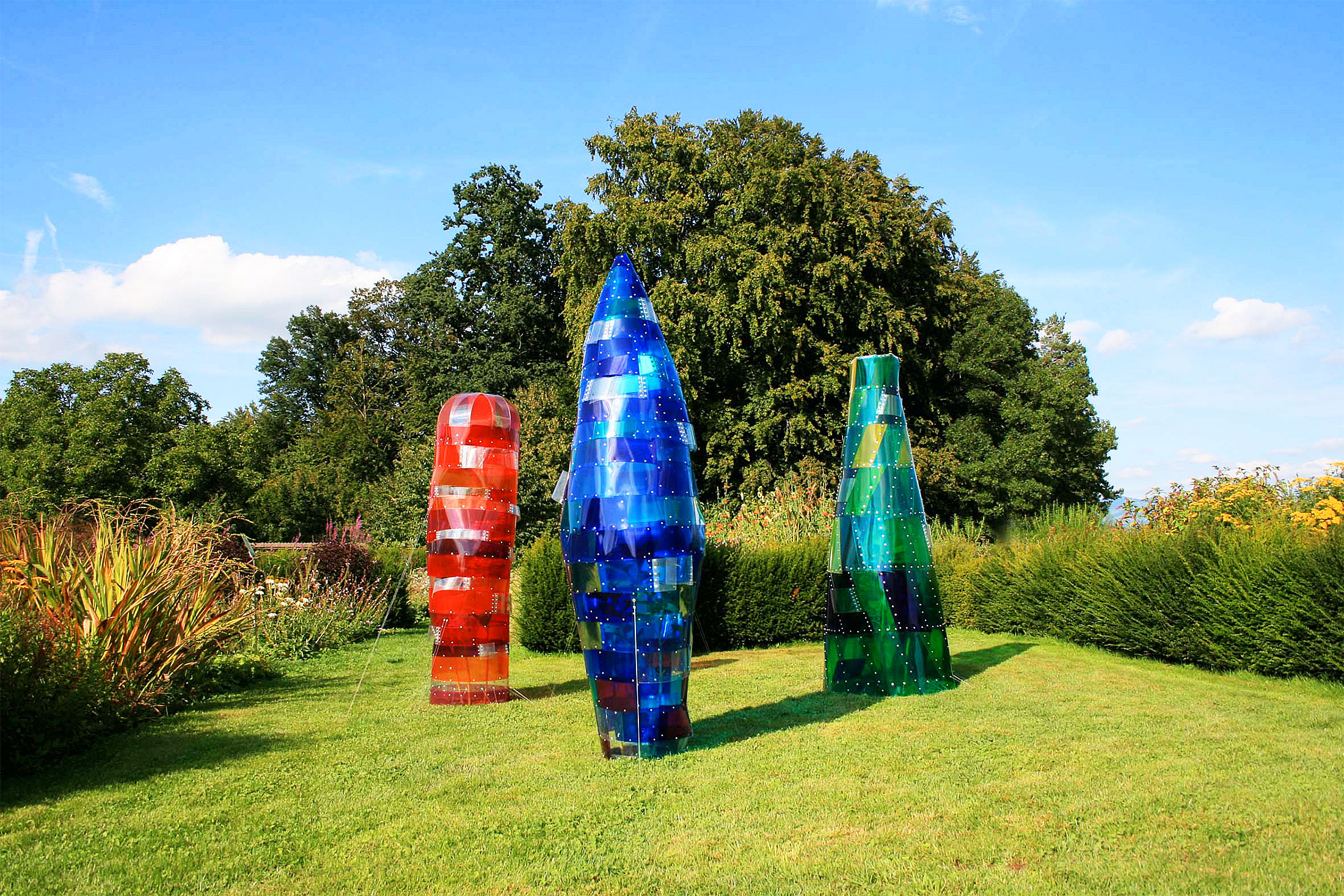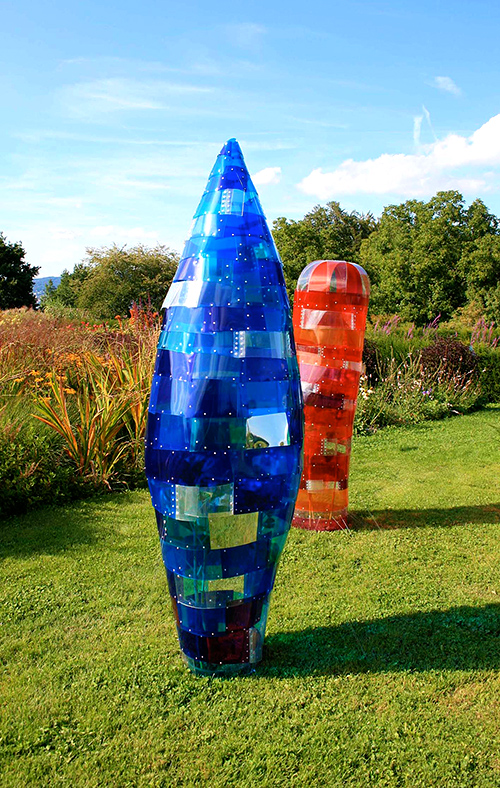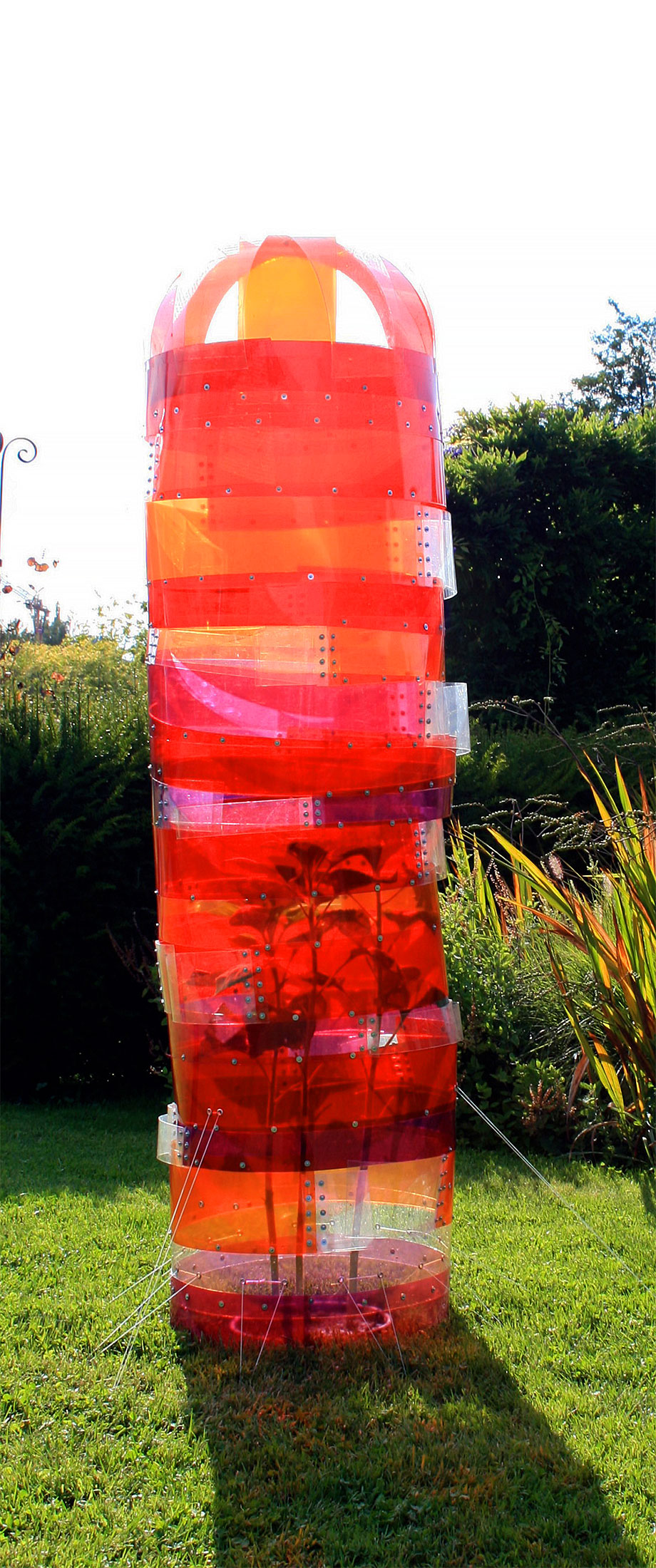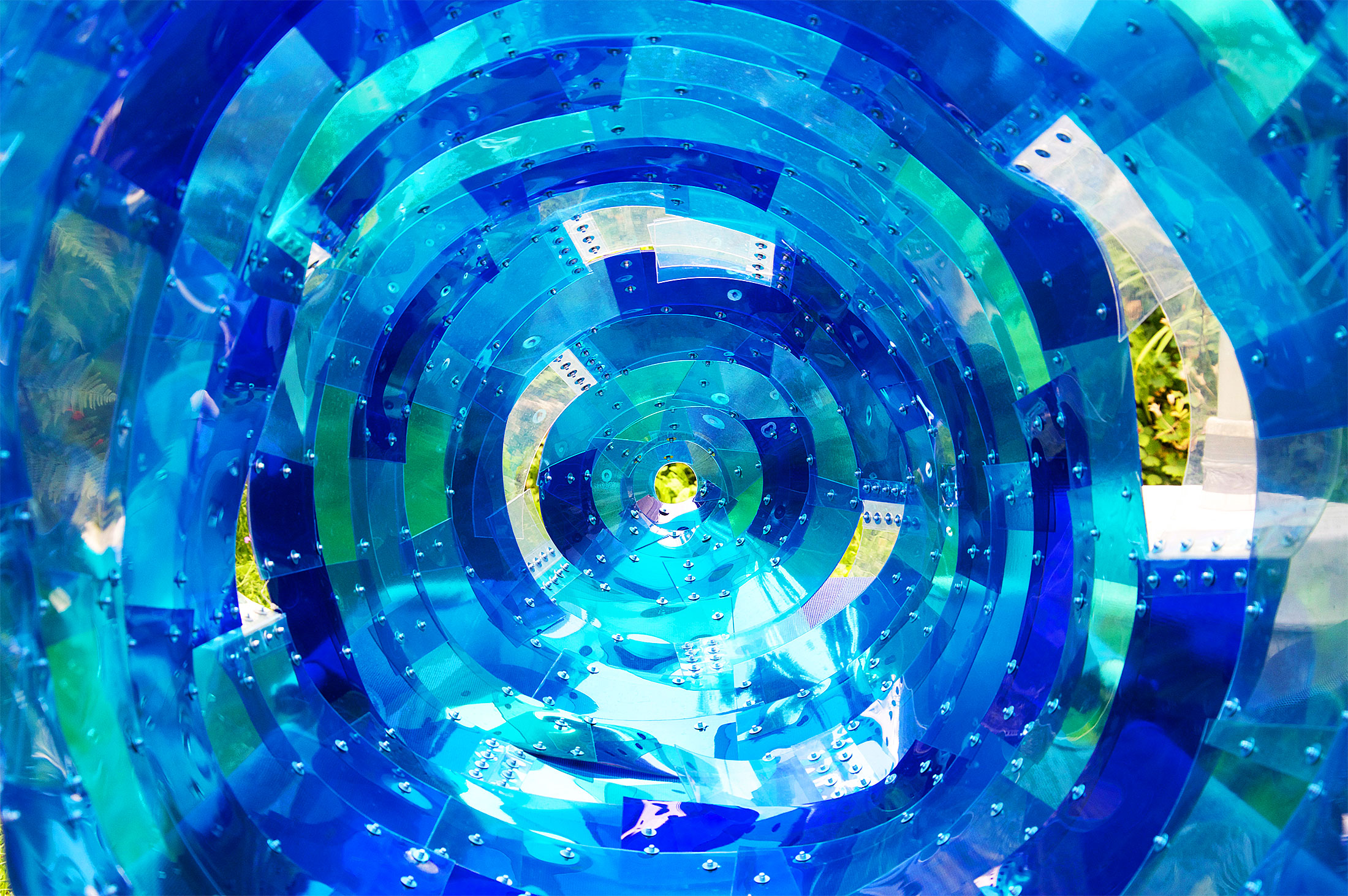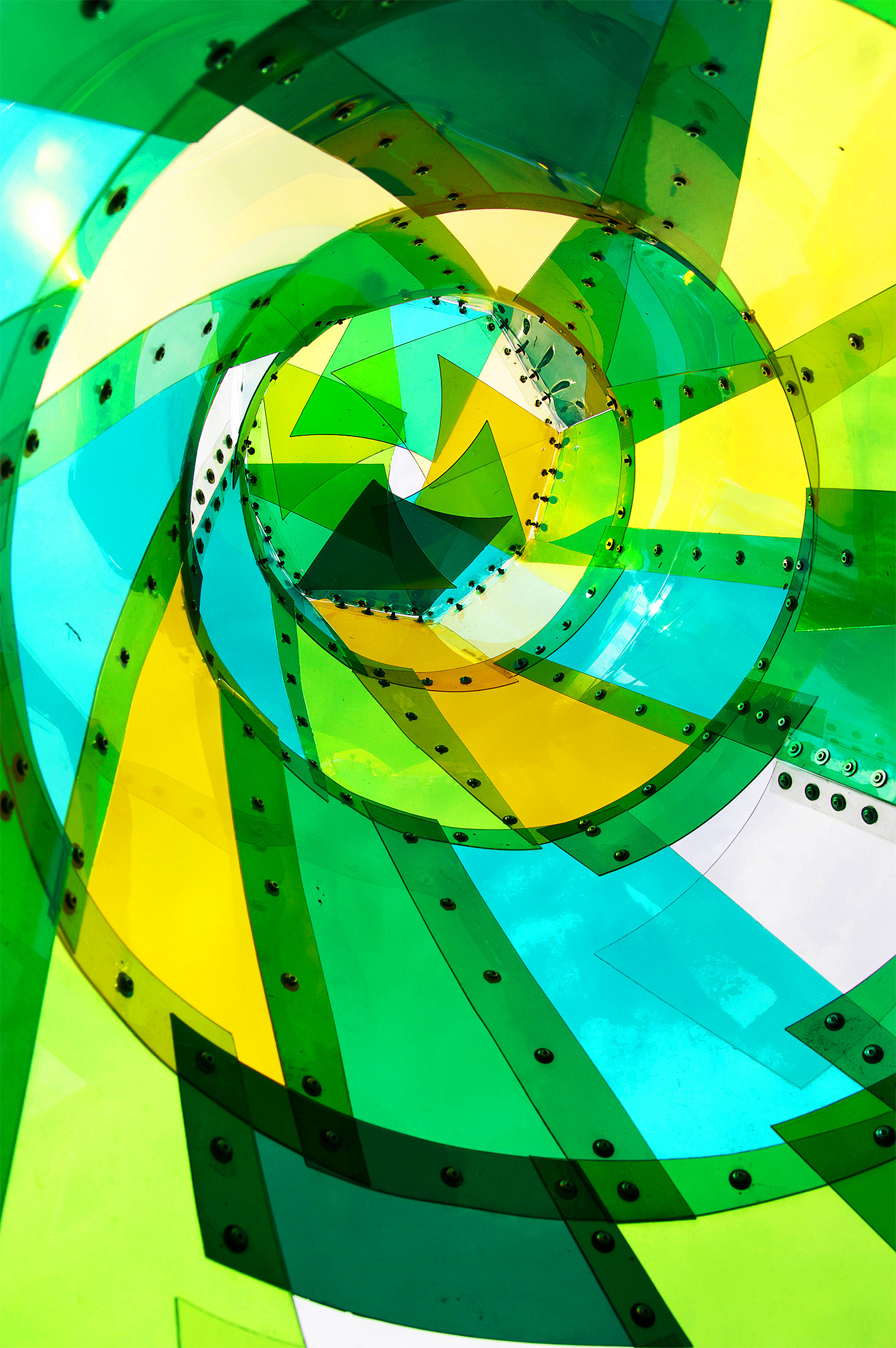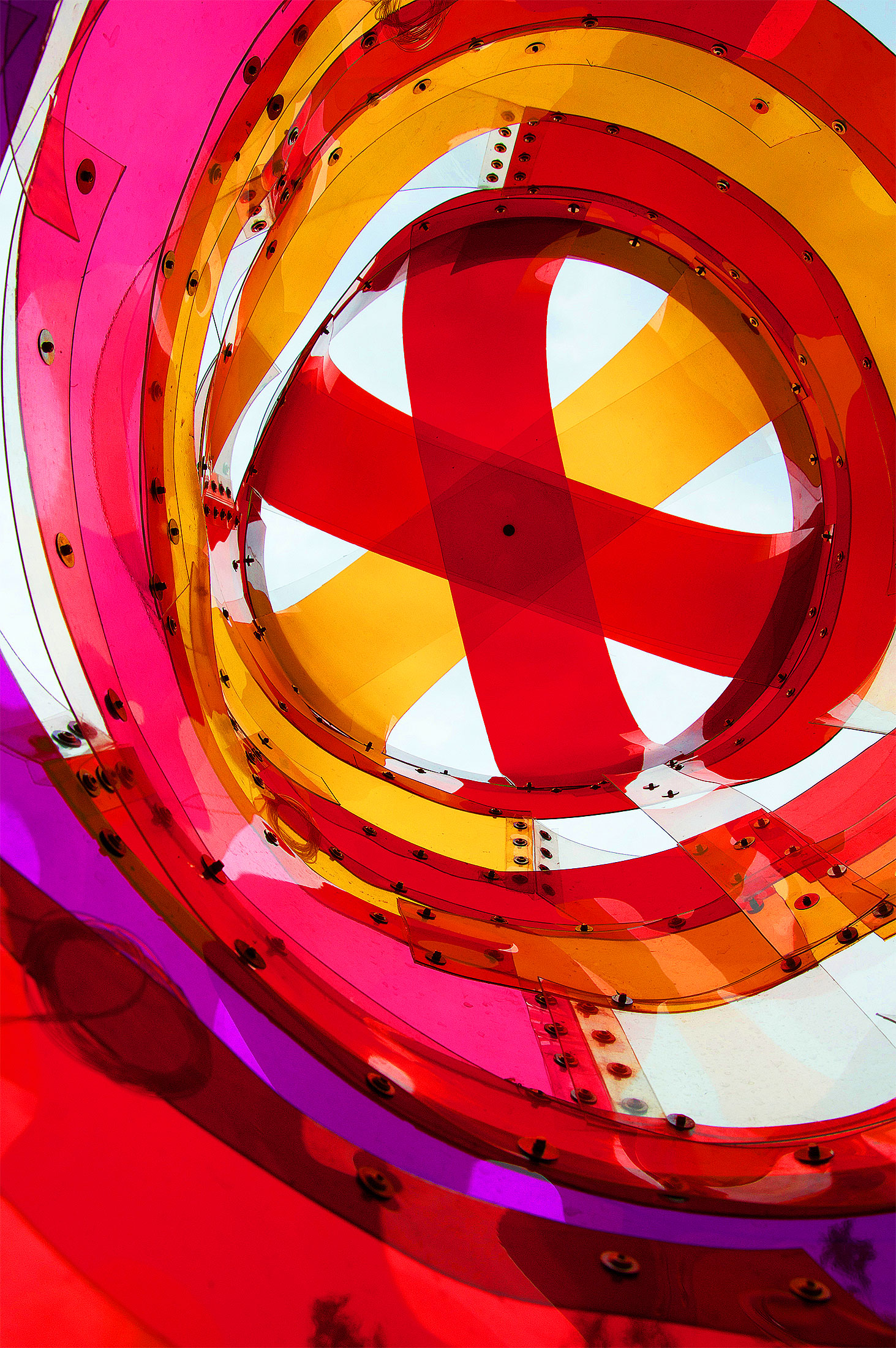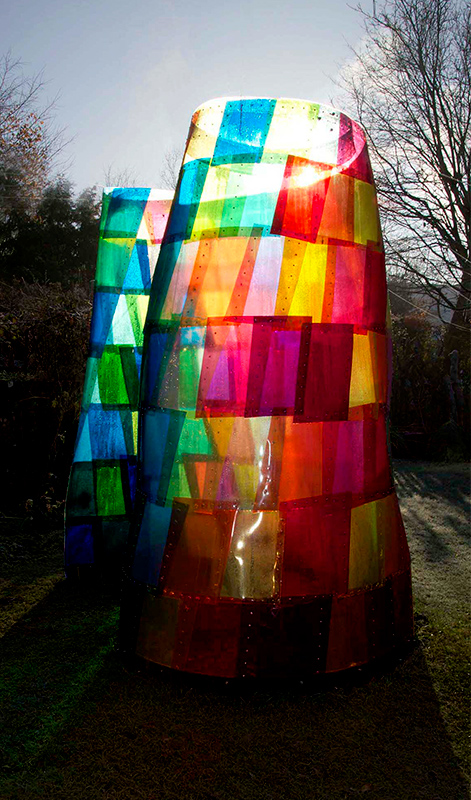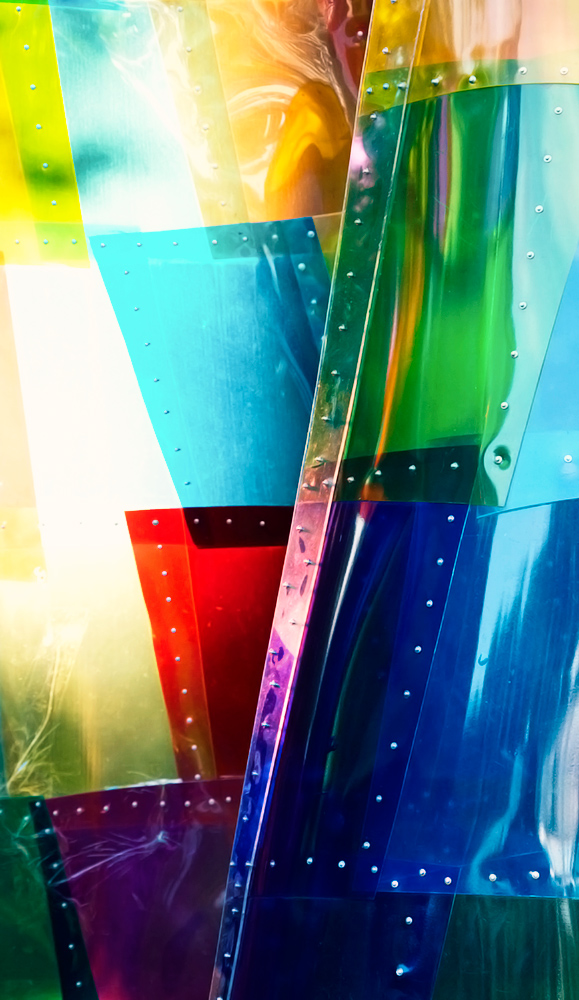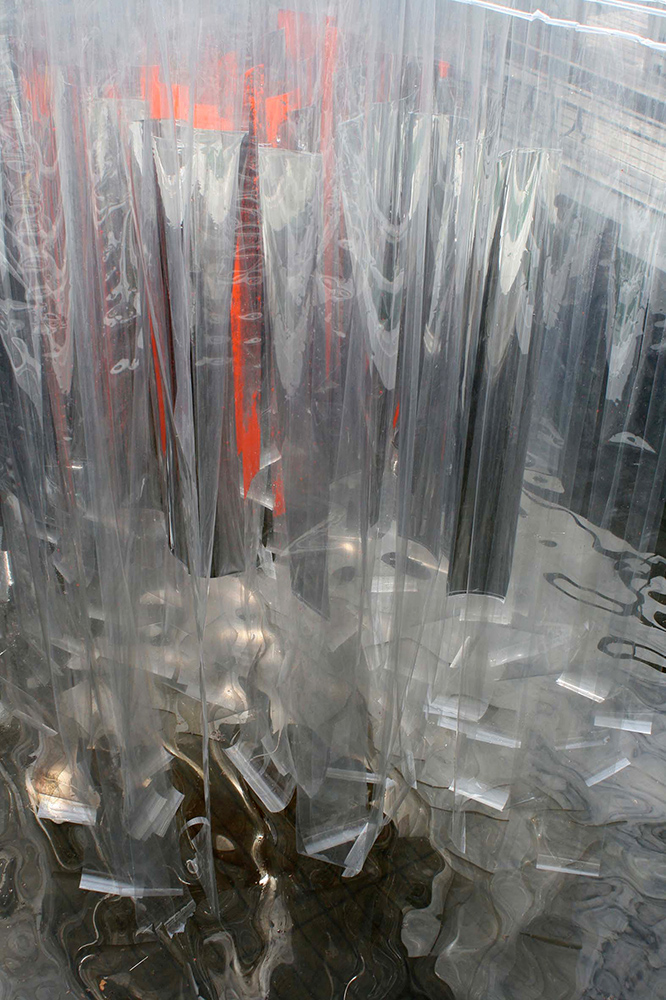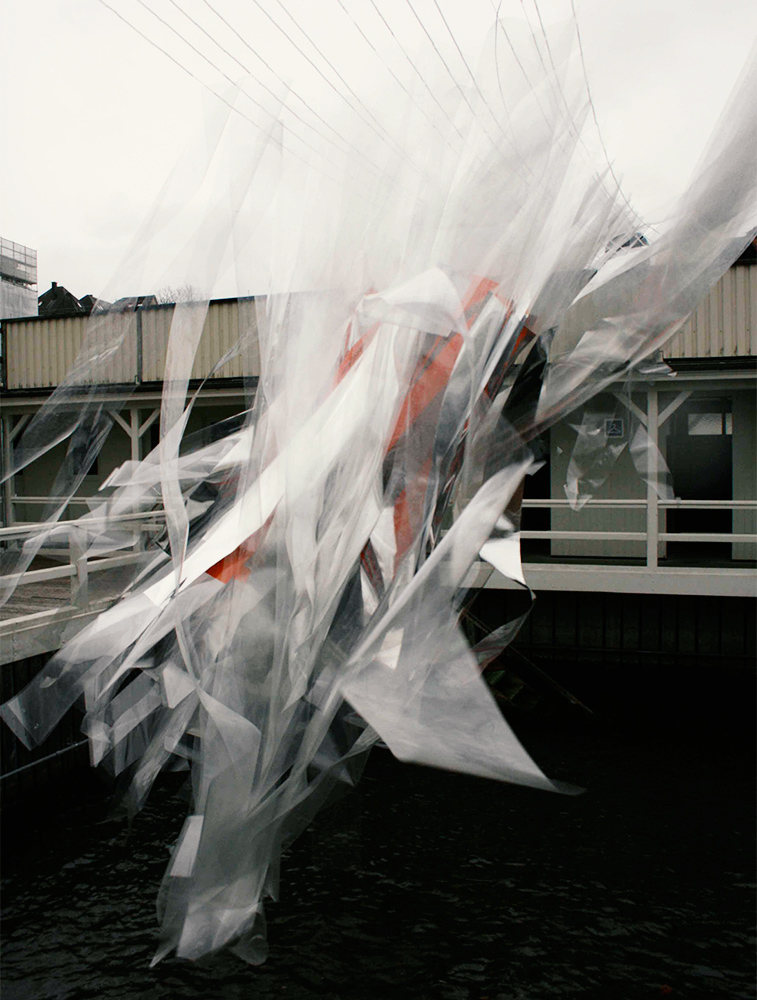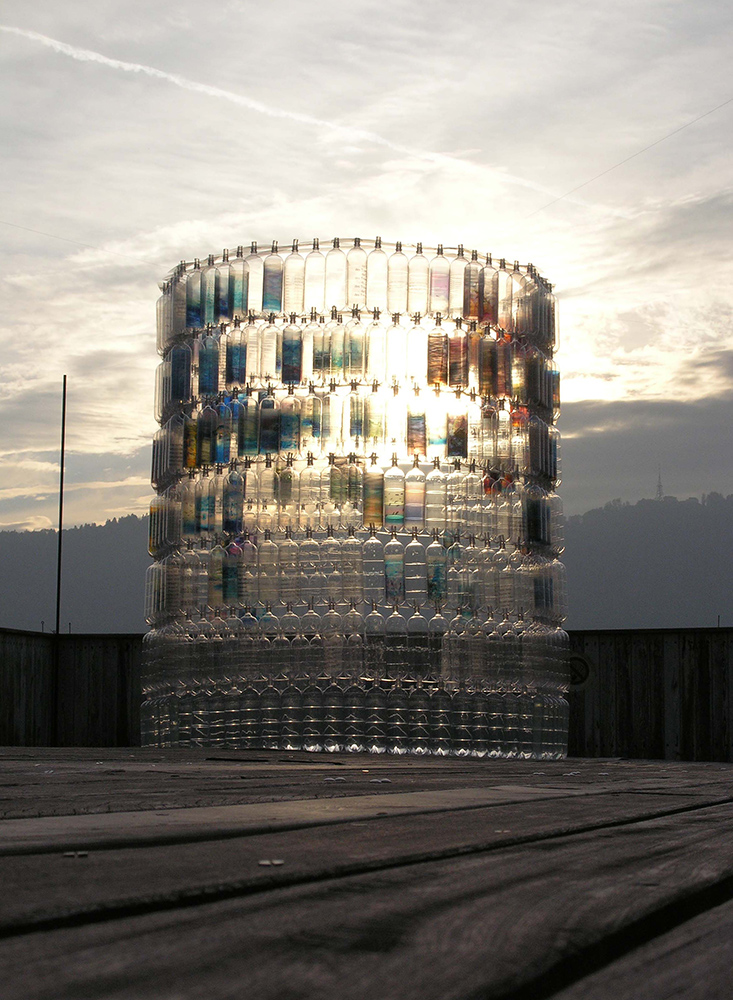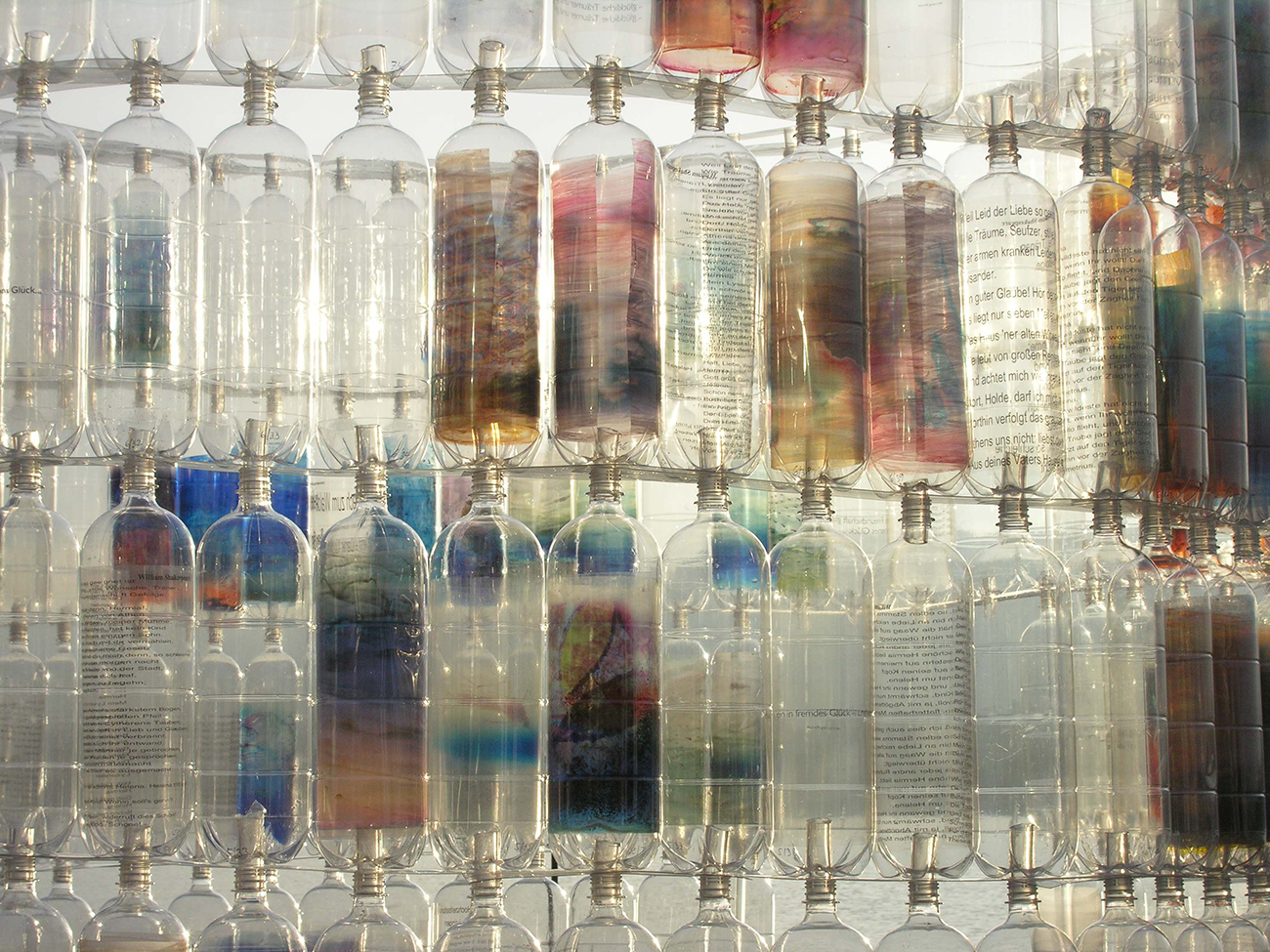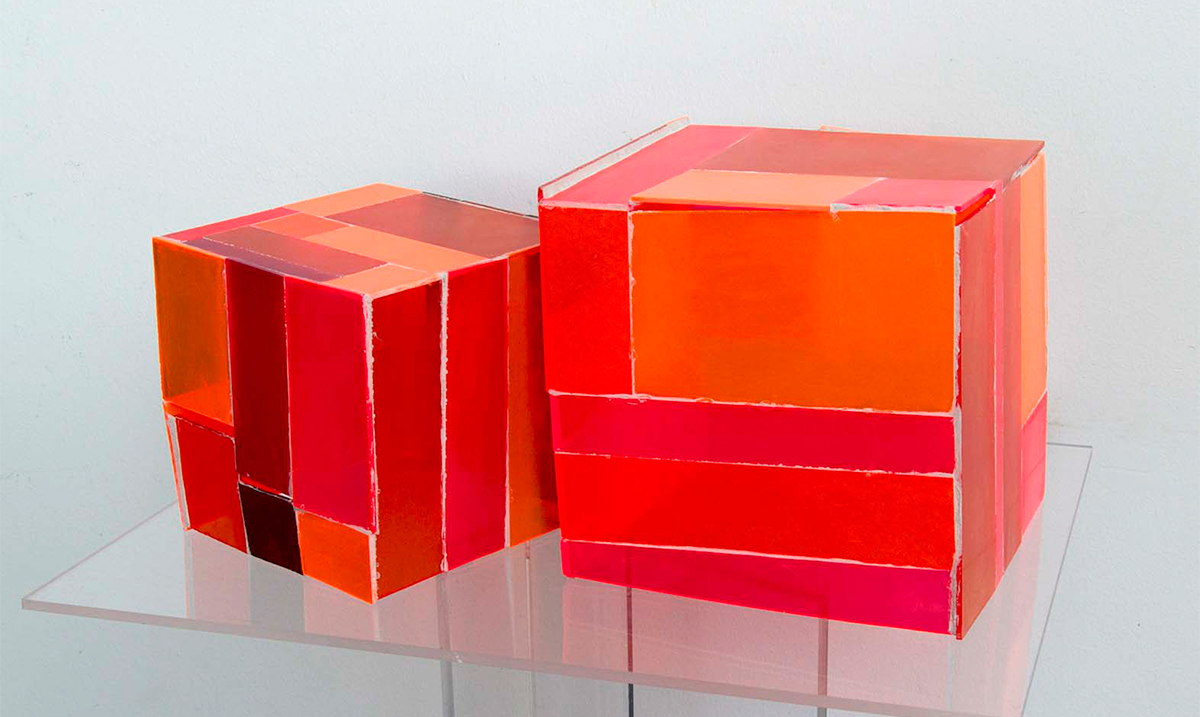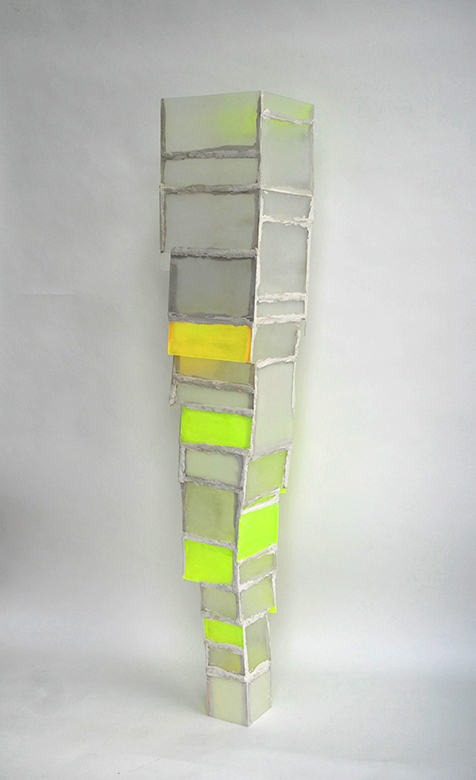Fragments are reference objects and symbols of destruction. At the same time they are a cry of powerlessness, not to be able to intervene. Almost daily we see reports on slaughtering living beings merely for the suggestion of the superstitiousness that the substances extracted from the cadavers might be miraculous startles me. This is a war in which horns and fins are the reason for slaughtering - I therefore expose these parts as memorials of futility. Although they are reproductions, every object is different. In nature not one horn looks like another even though their shape is similar. Every horn is unique.
To express the transitory, the past raised to higher power - conveyed by a material - all that is not perceived in the original material.
"Turbulenzen" exhibition, Bad Utoquai Zurich, 2014
After experiments with colorful greenhouses, which investigated the effect of colors on the growth and appearance of individual plants, the idea of a walk-in object was born. It was to be colored and curved like a rainbow. Immersion in intense colors also has positive effects on the way people feel. From this idea and against the background of the experiments with the greenhouses the "GALERIA FROHSINN" was conceived – an artistic "spectral color energy tunnel" without any scientific claim.
Triennial UNIL Lausanne, 2016 - 2017
For the sculpture triennial of the University of Lausanne, the "GALERIA FROHSINN" was adapted to the open area and the tunnel was extended. The art installation allowed a different view of the university area. The familiar path lost its everyday function for a few brief moments and became an "expedition path", the familiar surroundings suddenly appeared in a different colored light. Whoever used the path had to pass the colored rainbow – whether in summer or winter, day or night, dry or wet.
"KunstSOMMER", Old Church Witikon, 2022
As part of the "KunstSOMMER" campaign, the rainbow will again stand as an installation in public space on the Witikon church hill in Zurich until the end of August. The encounter with the "GALERIA FROHSINN" conveys a certain lightness, stimulates the imagination and gives energy. Walking through the "transformation tunnel" creates a good mood, has a calming effect after turbulence and awakens – depending on the situation – quiet cheerfulness or new hope.
Colorful Shadows of the Swarms
An intervention with four installations
Acrylic glass objects
October 28 to November 20, 2021
At the schauraum multipleart, Merkurstrasse 44, Zurich
The great swarm, 2021
Installation of 58 objects
transparent and fluorescent acrylic glass, lasered and glued
size ca. 13-35 × 13-35 × 13-35 cm
seven iron sheets 70 × 70 cm
Four swarms in four formations, 2021
four installations of 20 to 40 objects
transparent and fluorescent acrylic glass
lasered and glued, size ca. 15-18 × 8 × 5-7 cm
iron sheet plates 70 × 70 cm
The green-blue swarm, 2021
Installation of 10 objects
transparent and fluorescent acrylic glass
lasered and glued, size ca. 35 × 50 × 75 cm
Flamingo Groups, 2021
An experimental photo series of individual objects
photographed in the sunlight of an early summer
fluorescent transparent acrylic glass
lasered and glued, size ca. 15 × 20 × 17 cm
A swarm on the wall, 2021
fluorescent transparent acrylic glass, lasered, glued,
ize ca. 15-20 × 7-10 × 5-8 cm
installation of 12 objects
Size of the installation variable
"You live, you mend and correct and build your life and sometimes damage it. After some time you realise that the way it is composed of mistakes and chance it can’t be changed any more.“
From Eszter’s Inheritance by Sándor Márai
Beauty and fragility, construction and collapse are memories and hopes at the same time. The house of card principle is extremely unstable. A mistake makes everything collapse. Total failure is the price for breaking the prevailing rules, chaos is the answer to the intrusion of the impermissible into the regularities of everyday life.
We all focus on houses of cards in which our dreams, hopes, and wishes are living. We putty them again and again as we want to keep memories and emotions. New houses of cards arise from the shards. The fragility of the fired clay corresponds to the fragility of the house of cards, the bonding putty assumes a supporting function.
Since 2000 up to date the development from ‘dwelling‘ to ’city‘ is pursued. Objects are further developped and condensed in form and content.
Jalta – The Picture of Limits (2016-2017)
A series of 20 objects
For centuries man has thought about the shape of the earth. Later, he measured every angle, drew borders, created territories, and divided them again. New maps were created, new borders, natural, random, harmonious, upside down, desired, unpredictable borders, thus leading to all political consequences. With my work I refer to facts reported in the media. It is all about limits. All over the world there are new limits, borders, fences, walls. What exists is ignored. They are drawing board territories, between public and private, between lawful and unlawful. Some borders are penetrable, some are deadly, many are visible, some are not. Jigsaw pieces at the peace conferences of the powerful. If one piece is the randomly picked out it is divided, isolated, cut into pieces and reshaped.
The objects are covered with engobe colours on both sides. They are presented in at least 8 positions.
Porcelain, clay, engobe, burnt at 1200 ºC, Dimensions 20 cm x 17 cm x 3-4 cm to 40 cm x 40 cm x 4 cm
Akropolis
The building on the hill with its porticos was the symbol of a political and intellectual empire. However, temples are but chart houses of power, mended and reconstructed in the course of history.
Porcelain, clay, engobe, burnt at 1200 ºC
Dimensions ca. 30 x 30 x 7 cm to ca. 40 x 40 x 40 cm
NORTH SEA - BARENTS SEA (1998-2013)
Waves and drill cores form one compact unit joined together from several individual elements, like part of the Barents Sea, like a drill core on the bottom of the sea. Fired clay, all in Raku technique, size approx. 20 x 20 x 30 cm
OIL RIGS (2010)
They are characteristic for the appearance of the North Sea, they balance on wooden beams, symbols of strength and energy man takes from the earth and the sea. Bronze casting, size approx. 10 x 10 x 15 cm, painted wooden beams approx. 100 x 20 x 20 cm
SYLT (2013)
Waves, oil rigs and drill cores stand for stability, fragility, and vulnerability. They tell about man in nature and his history. Installation of two, three, five or seven North Sea waves, engobed, fired, size approx. 30 x 50 x 1 cm
Diary
Diaries of one week, a series of 10 objects.
Daily fractures, lacerations, injuries, lucky breaks, it goes on and on, day and night are mended, improved, polished.
The objects are reversible. We thus see only the good and beautiful, we want to cover what we want to forget.
Porcelain, clay, engobe, burnt at 1200 ºC
Dimensions 20 cm x 17 cm x 3-4 cm
«Blue Planet» I – VII, 2018
A series of 7 objects
Porcelain, sliced, engobe, burnt at 1255 ºC
Dimensions ca. ø 35 cm x 0,5 cm
«Blauer Planet» I – VII, 2018
Serie von 7 Objekten
Porzellan, geschnitten, engobiert, gebrannt 1255 °C
ø ca. 35 cm x 0,5 cm
Water channelling and water storage belong to the most important cultural techniques of mankind. The aquaeducts in ancient Rome, the water sellers in the Sahel, the ring circuit pipelines in Zurich - water management has always known many forms. However, the everlasting formula is: Water means Life.
Shortage, crises, overflow, transport, and quality of water became the topics of the century. 2001 the culture magazine ‘Du' dedicated a special issue to all these current keywords. I then dealt with a competition on ’Fiction and Function’. Will access to water stay a fiction of mankind in the 21st century? Do pipeline systems have another function apart from water transport?
I am interested in the problems of transport and storage in an artistic context. I began to look for answers to the question if water pipeline systems have another than the assigned function - a water pipeline being static and dynamic at the same time as it simultaneously keeps and passes on its content. Storage and transport become the same.
My intention was to highlight the playful netting of the above and underneath of the transport pipes buried in the ground. To give them the opportunity to remind the world of their vital storage function My water storage concept is based on the idea that water pipelines should quasi live their role artistically in public.
Playfully dealing with clay slowly resulted in shapes of imaginary vessels. The storages became double storages with double function: The pipes formed the outer container of an inner container the content of which was cooled or heated according to the water in the system.
A further stage resulted in the project of a personal, mobile and thanks to elastic materials variable storage and pipeline project, the transparent parts of which allowing one to observe the water on the way to its destination.
At the end of a further development of this project and the experiments with transparent hoses would be the vision of a gigantic water hose collecting rain into an infinite circuit, while storing and passing it on - an artistic water management which can be variably adapted to the respective site.
Rags are used, thrown away, washed, crumpled, left aside, folded, kept. They are part of everyday life, they are totally common. By transferring them on a different material all traces of use over the time are preserved. The structure of the material gets a different effectiveness.
Soft becomes firm, the transient remains preserved. Precious materials with initials are carefully kept until they slowly begin to disintegrate. The previously clearly declared property loses its owner. The noble is downgraded to a rag and becomes ephemeral.
With this transformation of an everyday and common object into an art object I want to give it a special character. Daily cleaning becomes somewhat poetic.
The last supper or fragments of a family-table
The idea is a table without dishes, cutlery or glasses but only 12 partly ripped napkins, carelessly thrown on it, is a symbolic hint at The Last Supper. The initials in the monograms are referring to the former diners. The tablecloth is the symbol for clothes left behind and it’s a cloth, in which you would like to wrap yourself. The women had laid the table for 12 people. Together, they celebrated and commemorated. Then they all left. Where about? In what time zone? In which world? Ask the napkins left behind on the table, but they keep their secret. They are falling apart and petrify, like the table preserved according to the moment, when they feasted together at the last supper.
LAMPEDUSA 2015/16 or Schichten der Hoffnung (Layers of Hope)
Constantly surging waves of refugees, tragedies on the high seas, rescue from greatest peril: we have been seeing these pictures for years. Nobody can look away.
Time and again empty lifebelts or their remains are washed ashore, lie scattered all over. Time and tides create land piling up layer by layer. These layerings of fragments of failed hopes and the mute symbols of nameless tragedies will some day become sediments of oblivion.
The ‘Lampedusa’ project is an omnipresent and topical memorial against forgetting and a memento of the sad fate of innumerable human beings. The installation shows broken lifebelts washed ashore - made of clay, layered on top of one another, visualizing total . helplessness: paying reverence to the thousands of nameless disappeared people who clung to lifebelts in the open sea, the lifebelts which were their only and last hope.
Clearing and piling up the remains is an attempt at sorting our thoughts.
Size of the installation
Variable
Size of individual life-belts
approx. 50 cm x 50 cm x ∅10 cm
Material
fired clay, glazed
Mirage – or A “Passaggio specchioloso” 2017
The sailors say: The wind writes. The wind writes stories into the waves which spread out on a huge surface, glittering in the sun in zigzag lines. The wind writes colourful stories into the waves, stories about the lives by the sea, stories about hope, decisions, hazards, prophecies, illusions, and the waves carry them far out.
Installation
Height approx. 250 cm, width approx. 70 – 90 cm, length approx. 320 cm
PET silver foil, colour foil, aluminium tubes, rivets
«Half-life Period 10 000» or «The Individual Plant House» 2011
Preserving the past for the future and protecting the future from the present.
„The Individual Plant House“ is an object which should give empiric answers to the question of how plants react to a changing environment.
The Plant House is an artistically conceived research project - a botanic-architectural garden sculpture. It enables investigation of the influence of the form of a space on the growth of plants if its atmosphere is changed by using different colours.
These objects simulate different climates on a small scale. These may be different in every plant house though still stay comparable.
Exhibition „outside 2“ , Zurich University Of Applied Sciences, Wädenswil 2011
After experimenting with colourful plant houses which dealt with the effect of colours on growth and appearance of plants, the idea emerged to develop walkable objects which would be colourful like a rainbow. Colour influences the physical comfort of man while the original question remains unchanged: How does colour influence the exhibition visitor?
«Stazione Frohsinn» is an object as a place of retreat allowing us to view the environment in various colours while the view into the object depends on the intensity of light. On the basis of a circle the outline extends to a spiral. This allows a central access and at the same time excludes the outside world. The object narrows upwards and leaves a free view to the sky.
The interaction between atmospheric and coloured parts results in a composition which changes with the weather. There is room for several persons at the same time. Sunlight makes the cocoon seem variously transparent according to the time of the day or the year and at the same time lets the object appear more or less transparent.
Exhibition „Kunst im Dolderbad“, Zurich Dolder outdoor swimming pool, 2014 during swimming season. Children used the object to play and hide, whereas adults used it as a locker room according to the personnel.
«Galeria Frohsinn»
Bad luck, dear rainbow. In fairy tales you often end up in a pot of gold but here - in a mixer. Your colours were scrambled to an airy razzle-dazzle, the bonds of physics were broken. When Isaac Newton broke down the sunlight into its spectral colours he was criticised for having destroyed the magic of the rainbow. But you still create a bond between sun and rain, you play with the wind and the waves, you perform magic by bringing serenity into sombreness, you create wishes and dreams. Above all, however, you give us this ephemeral happiness we feel when your colours reconcile fire and water.
Exhibition „Turbulenzen“, Utoquai Lido, Zurich 2014
XANADU I - V 2013/14
Volatile pictorial memories of a city, its built structures, individual urban districts - these are the inspirations creating objects. What stood out and what is retained in our memory? What is striking? What arouses our feelings, awakens memories? Variables - influenced by the time of the visit to the city, varying with the pictures and impressions we then encountered. ’Xanadu’ is an imaginary city, formed of individual objects with a constantly changing aura. The towers seem transparent, at times even invisible, though merely granting a vista though no insight. May this have been what the fantastic town constucted by the Mongolian emperor Kublai Khan and Marco Polo looked like during their conversations? Could this have been what the town found by Italo Calvino and described in his novel ‘Invisible Cities’ looked like? XANADU II – V 2013/2014 Materials: plexiglass, glue, putty, dimensions approx. 10 - 40 x 10 - 40 x 20 - 40 cm
ANEMOSCOPIUM (WIND GAUGE)
«Devant nous le désir, après nous le ciel» If they were let free, they would rise infinitely, flying to become the blue of the sky, the white of the clouds, the brilliant sun glittering, and the darkness of the night. Weightless and free. Translucent gravity. We measured the wind. But the wind, too, took measure and left its marks. At a closer look we can say: The wind blew. It actually blew quite strongly.
Installation in collaboration with Corinne Schroff, 2008
Material: transparent und coloured PET ribbons, approx. 30 cm x 500 cm
Dimensions: approx.. 450 cm x 500 cm
«TRAUMFÄNGER»
Is it at all possible to catch and keep a dream of a summer night? Can you enclose dreams? Is it an attempt at catching and keeping colours and feelings of a dream in a bottle? An object of dreams caught all over gives the chance to dream them again as if immersing in a cloud full of dreams and continue dreaming. Looking up to the passing clouds and through the dream sequences on the seemingly transformed environment. Confusing - or just phantasmagoric? Looking from the inside of the object through the enclosed dreams creates a link to the outside world and at the same moment puts into perspective their reality.
Installation in collaboration with Corinne Schroff, 2006
Material: Transparentes PET, Mixed media, all recyclable
Dimensions: ∅ approx. 200 cm, height 7 rows of bottles or approx. 245 cm 420 bottles, approx. 35 cm x 10 cm each
